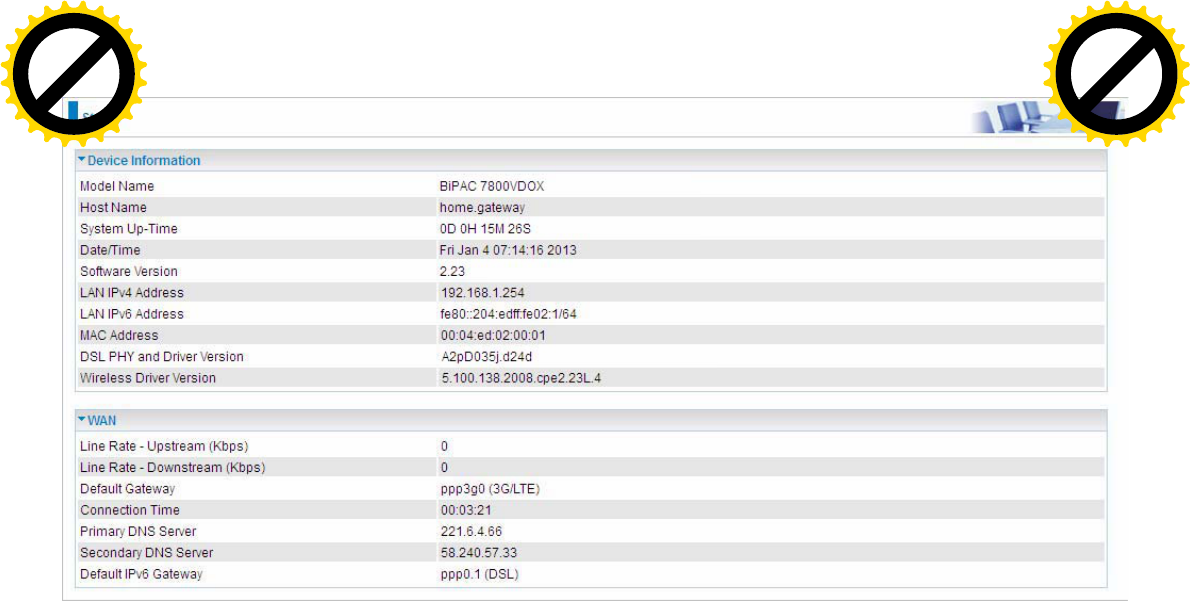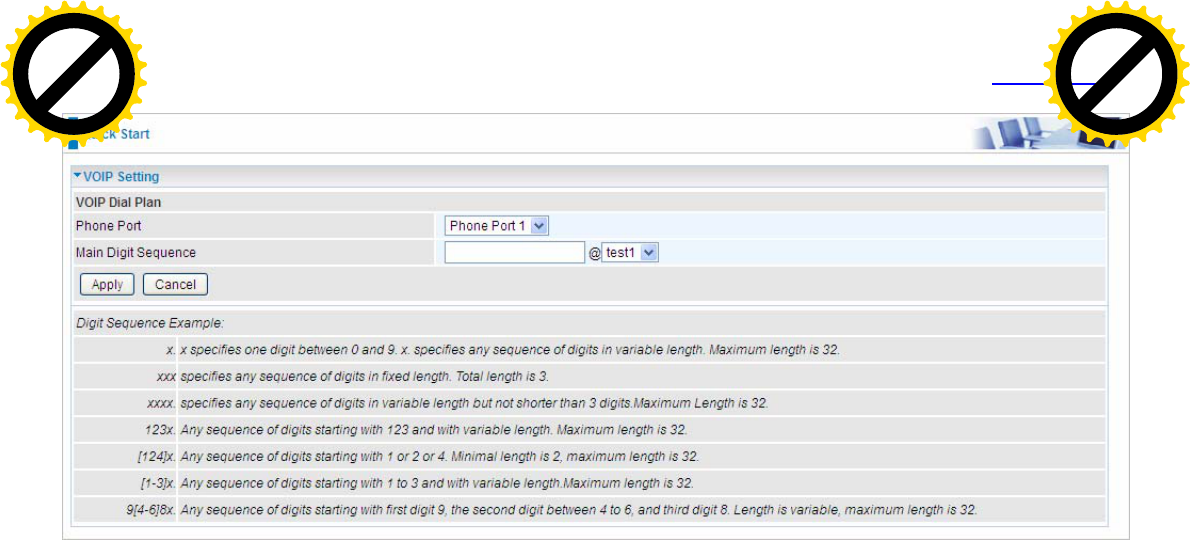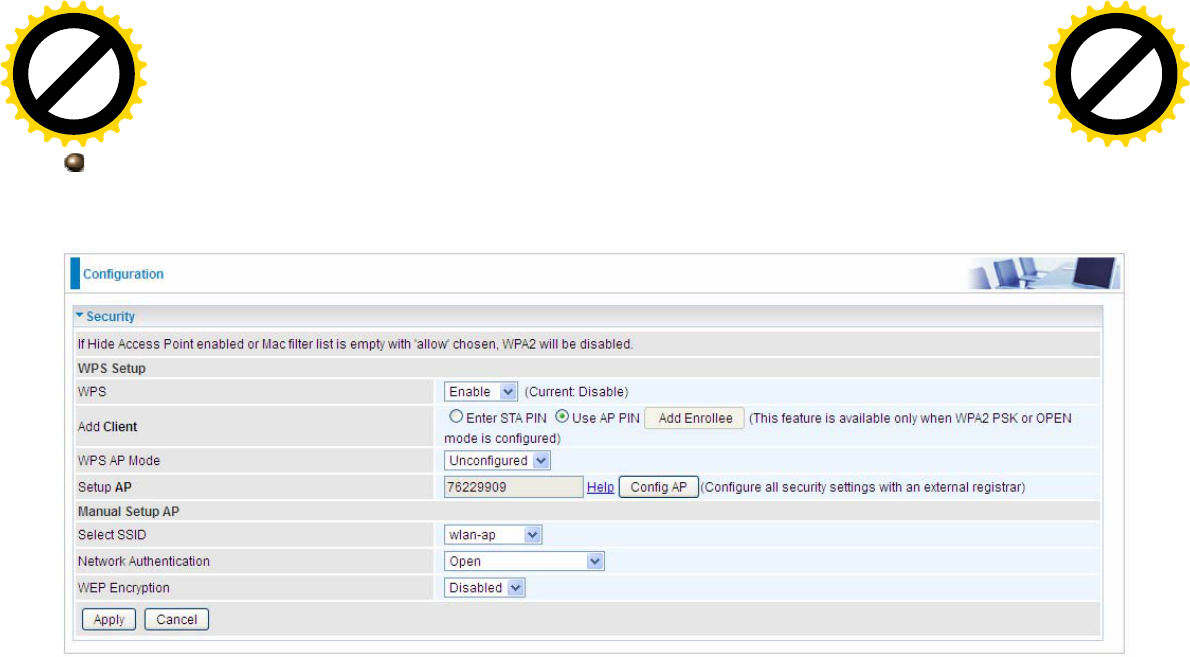Billion Electric BIL-7800VNOX Wireless-N ADSL2+/Fibre Broadband Router User Manual 2
Billion Electric Co., Ltd. Wireless-N ADSL2+/Fibre Broadband Router 2
Contents
- 1. user manual-1
- 2. user manual-2
- 3. user manual-3
user manual-2
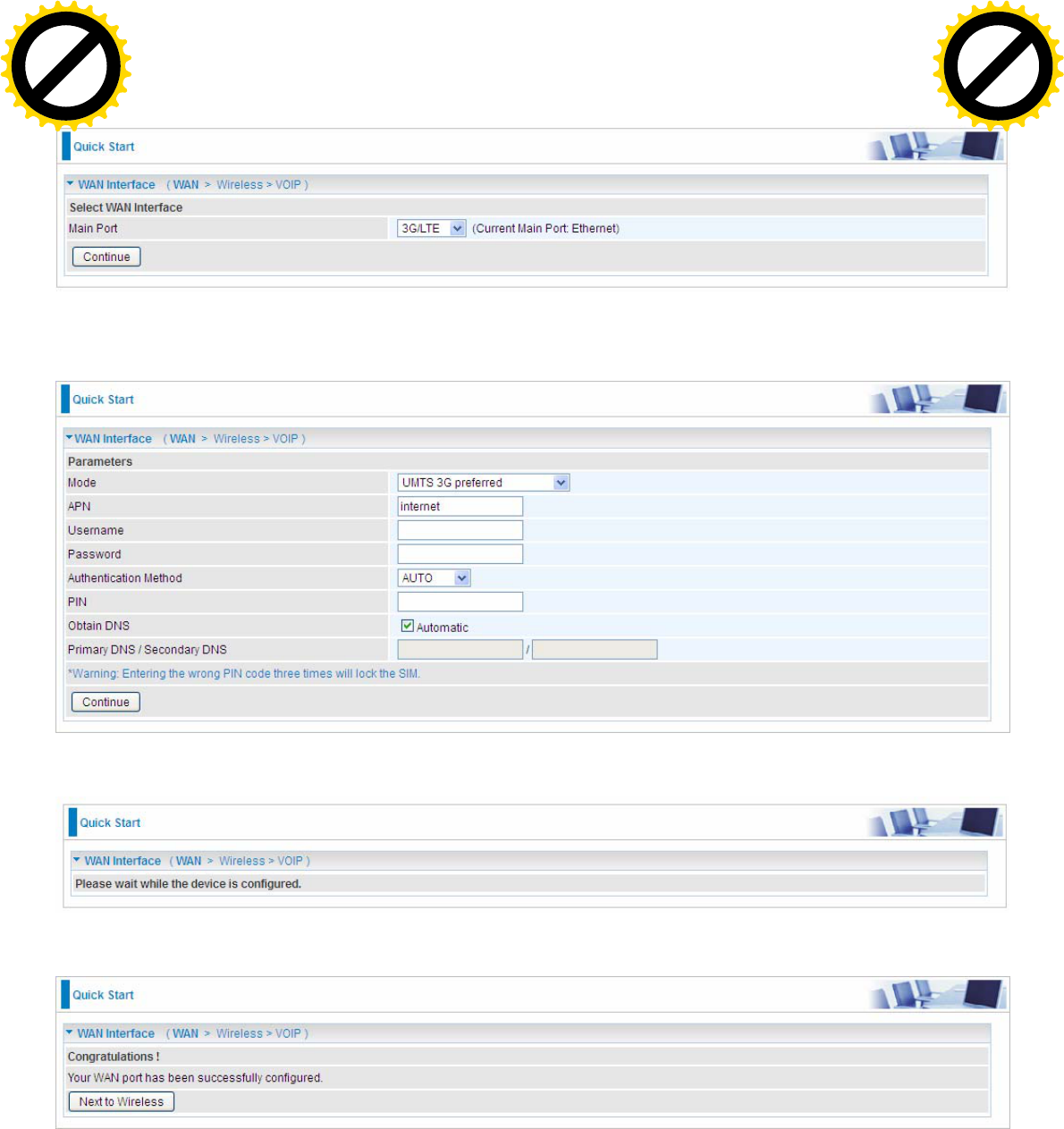
72
3G/LTE
1. Select 3G/LTE, press Continue to go on to next step。
2. Select the 3G mode, and enter the APN, username, password from your ISP; and check with your
ISP with the authentication method setting.
3. Wait while the device is configured.
4. WAN port configuration is successful.
Click to buy NOW!
P
D
F
-
X
C
h
a
n
g
e
V
i
e
w
e
r
w
w
w
.
d
o
c
u
-
t
r
a
c
k
.
c
o
m
Click to buy NOW!
P
D
F
-
X
C
h
a
n
g
e
V
i
e
w
e
r
w
w
w
.
d
o
c
u
-
t
r
a
c
k
.
c
o
m
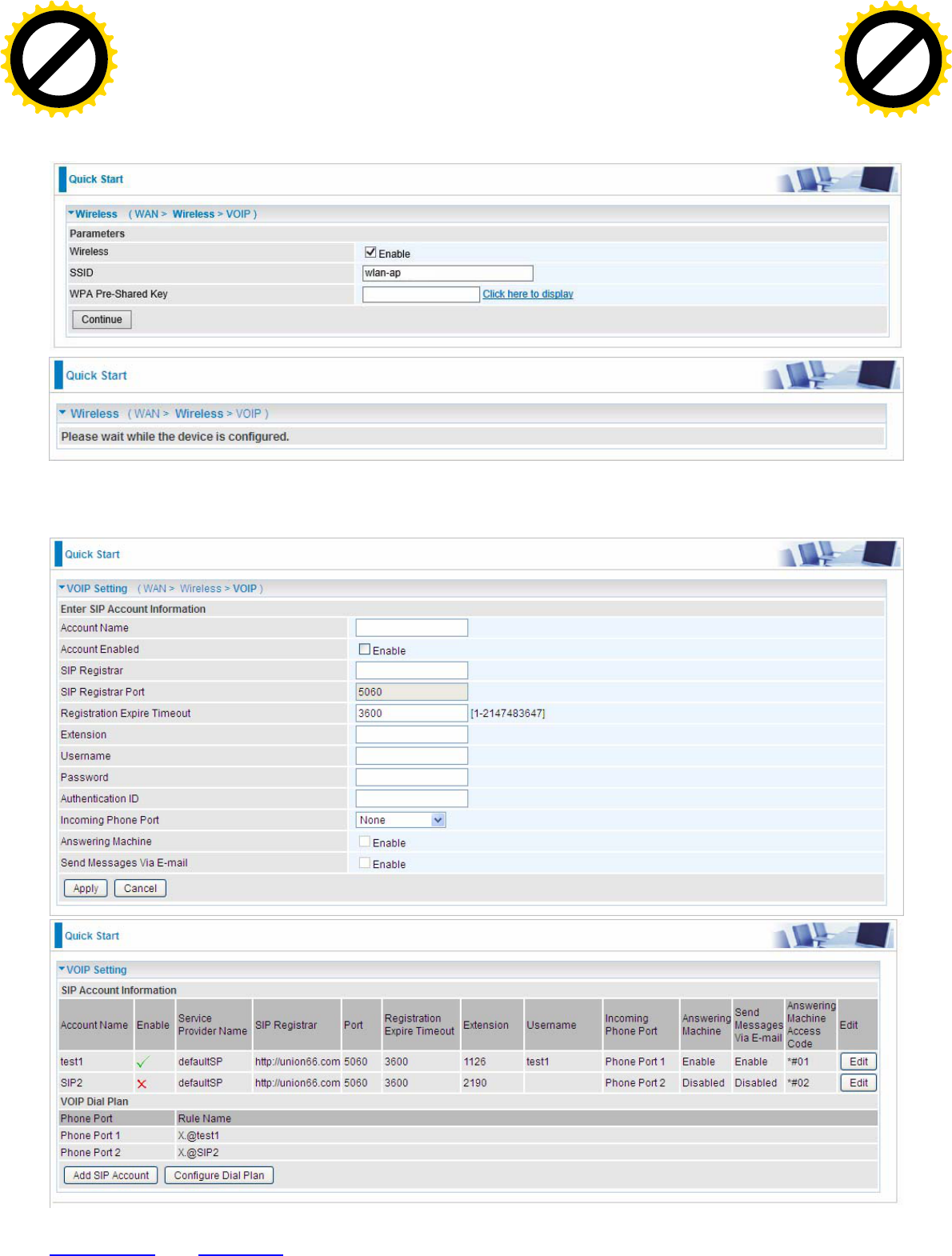
73
5. After the configuration is successful, click Next to Wireless button and you may proceed to
configure the Wireless setting. In Quick Start part, users can only enable or disable the wireless and
set the exact SSID and encryption Key (1. Leave it empty to disable the wireless security; 2. Fill in
the Key, and the encryption mode will be WPA2-PSK/AES). For detail setting, please go to the
Wireless part in this Manual.
7. Set the VoIP parameters. First user should turn to a VoIP service provider to register a SIP
account, write down the registration information and fill it in the following blanks.
In this page, user can continue to add SIP account and configure dial plan, for more, please refer to
SIP Account and VoIP Plan.
Click to buy NOW!
P
D
F
-
X
C
h
a
n
g
e
V
i
e
w
e
r
w
w
w
.
d
o
c
u
-
t
r
a
c
k
.
c
o
m
Click to buy NOW!
P
D
F
-
X
C
h
a
n
g
e
V
i
e
w
e
r
w
w
w
.
d
o
c
u
-
t
r
a
c
k
.
c
o
m
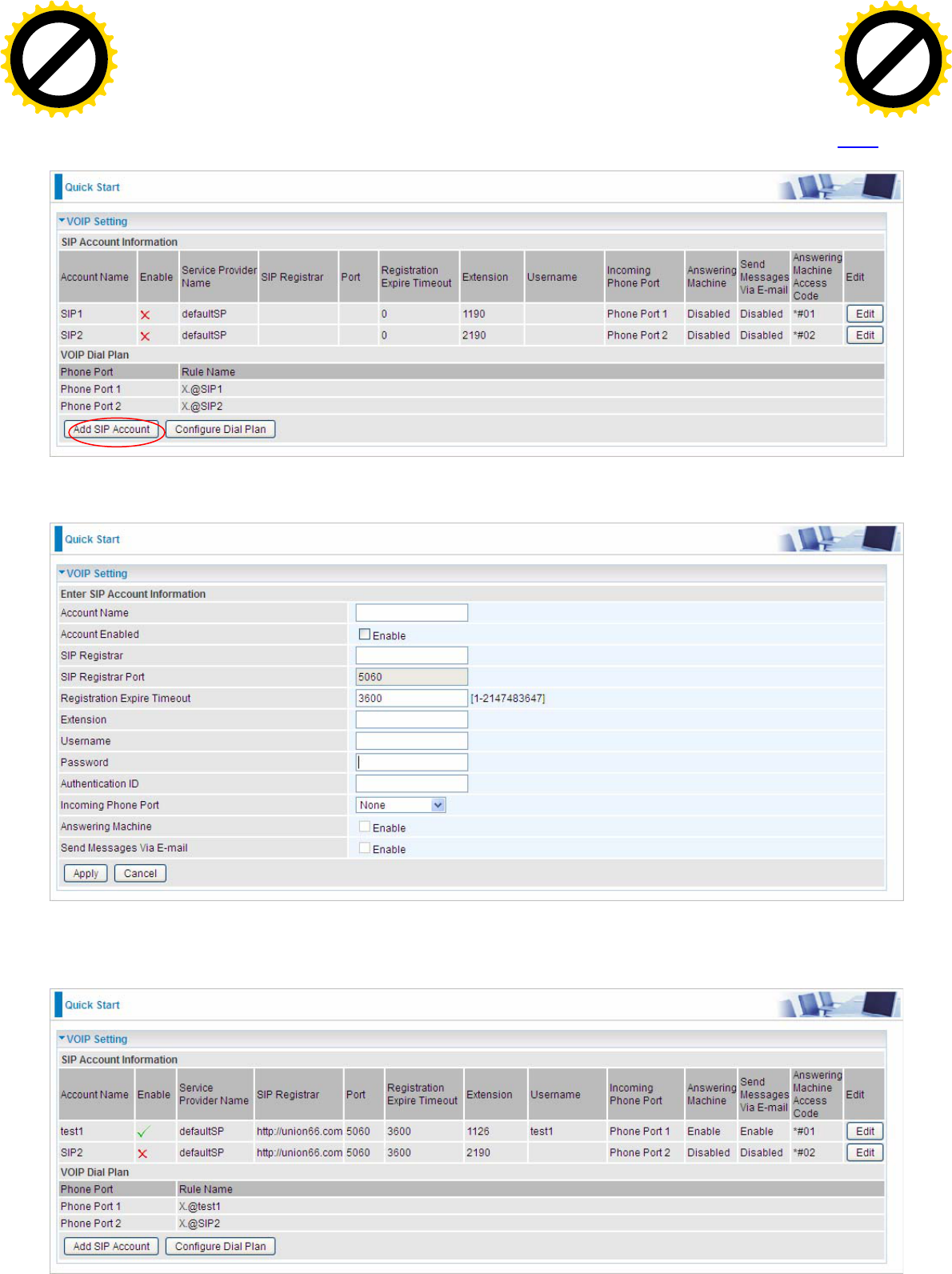
75
VoIP Quick Setup
“VoIP Quick Setup” links to quick VoIP setting pages. In this part, users can conduct the necessary
settings (SIP account, VoIP Dial Plan, etc) of VoIP for use. For detail settings, please refer to VoIP.
Picture1
Click Add SIP Account to add new sip accounts (set the registration information).
Picture2
Click Apply to save the settings.
For example:
Click to buy NOW!
P
D
F
-
X
C
h
a
n
g
e
V
i
e
w
e
r
w
w
w
.
d
o
c
u
-
t
r
a
c
k
.
c
o
m
Click to buy NOW!
P
D
F
-
X
C
h
a
n
g
e
V
i
e
w
e
r
w
w
w
.
d
o
c
u
-
t
r
a
c
k
.
c
o
m
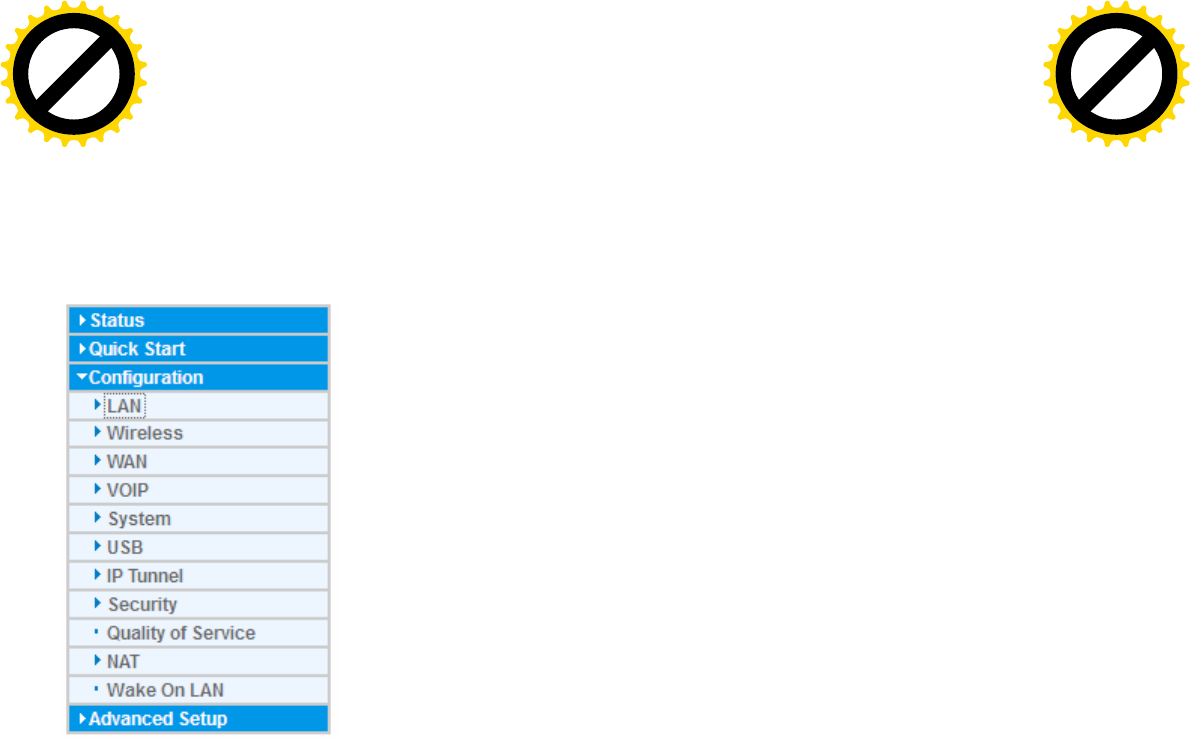
77
Configuration
When you click this item, the column will expand to display the sub-items that will allow you to further
configure your router.
LAN, Wireless, WAN, VOIP, System, USB, IP Tunnel, Security, Quality of Service, NAT and
Wake On LAN.
(7800VNPX)
The function of each configuration sub-item is described in the following sections.
Click to buy NOW!
P
D
F
-
X
C
h
a
n
g
e
V
i
e
w
e
r
w
w
w
.
d
o
c
u
-
t
r
a
c
k
.
c
o
m
Click to buy NOW!
P
D
F
-
X
C
h
a
n
g
e
V
i
e
w
e
r
w
w
w
.
d
o
c
u
-
t
r
a
c
k
.
c
o
m
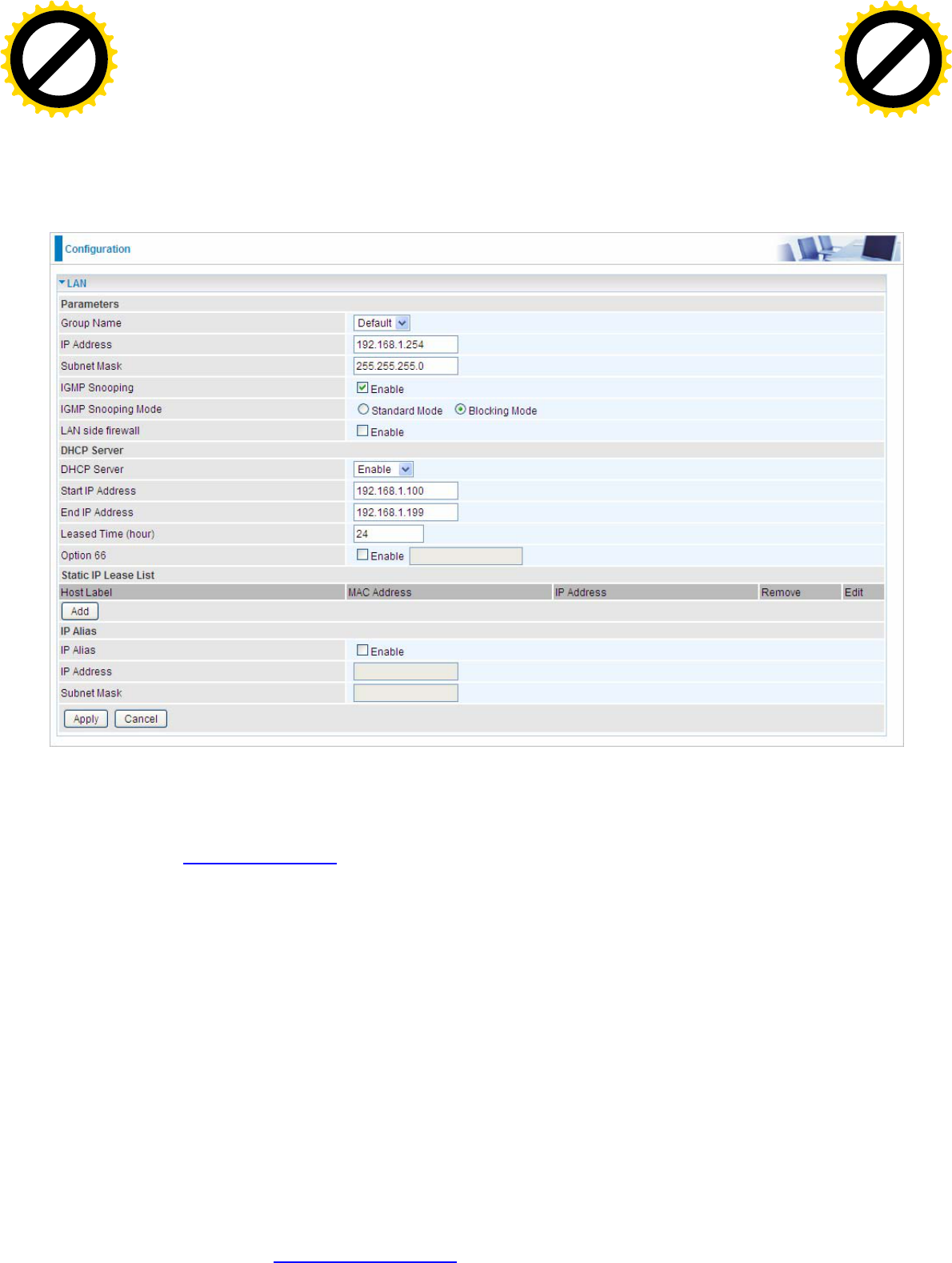
78
LAN - Local Area Network
A Local Area Network (LAN) is a shared communication system network where many computers
are connected. This type of network is area defined and is usually limited to a confined region within
a building.
Ethernet
Parameters
Group Name: This refers to the group you set in Interface Grouping section; you can set the
parameters for the specific group. Select the group via the drop-down box. For more information
please refer to Interface Grouping of this manual.
IP address: the IP address of the router. Default is 192.168.1.254.
Subnet Mask: the default Subnet mask on the router.
IGMP Snooping: Enable or disable the IGMP Snooping function. Without IGMP snooping,
multicast traffic is treated in the same manner as broadcast traffic - that is, it is forwarded to all
ports. With IGMP snooping, multicast traffic of a group is only forwarded to ports that have
members of that group.”
When enabled, you will see two modes:
Standard Mode: In standard mode, multicast traffic will flood to all bridge ports when no
client subscribes to a multicast group.
Blocking Mode: In blocking mode, the multicast data will be blocked when there are no
client subscribes to a multicast group, it won’t flood to the bridge ports.
LAN side firewall: Enable to drop all traffic from the specified LAN group interface. After activating it,
all incoming packets by default will be dropped, and the user on the specified LAN group interface
can't access CPE anymore. But, you can still access the internet service. If user wants to manage
the CPE, please turn to IP Filtering Incoming to add the allowing rules. Note that all incoming
packets by default will be dropped if the LAN side firewall is enabled and user cannot manage this
Click to buy NOW!
P
D
F
-
X
C
h
a
n
g
e
V
i
e
w
e
r
w
w
w
.
d
o
c
u
-
t
r
a
c
k
.
c
o
m
Click to buy NOW!
P
D
F
-
X
C
h
a
n
g
e
V
i
e
w
e
r
w
w
w
.
d
o
c
u
-
t
r
a
c
k
.
c
o
m
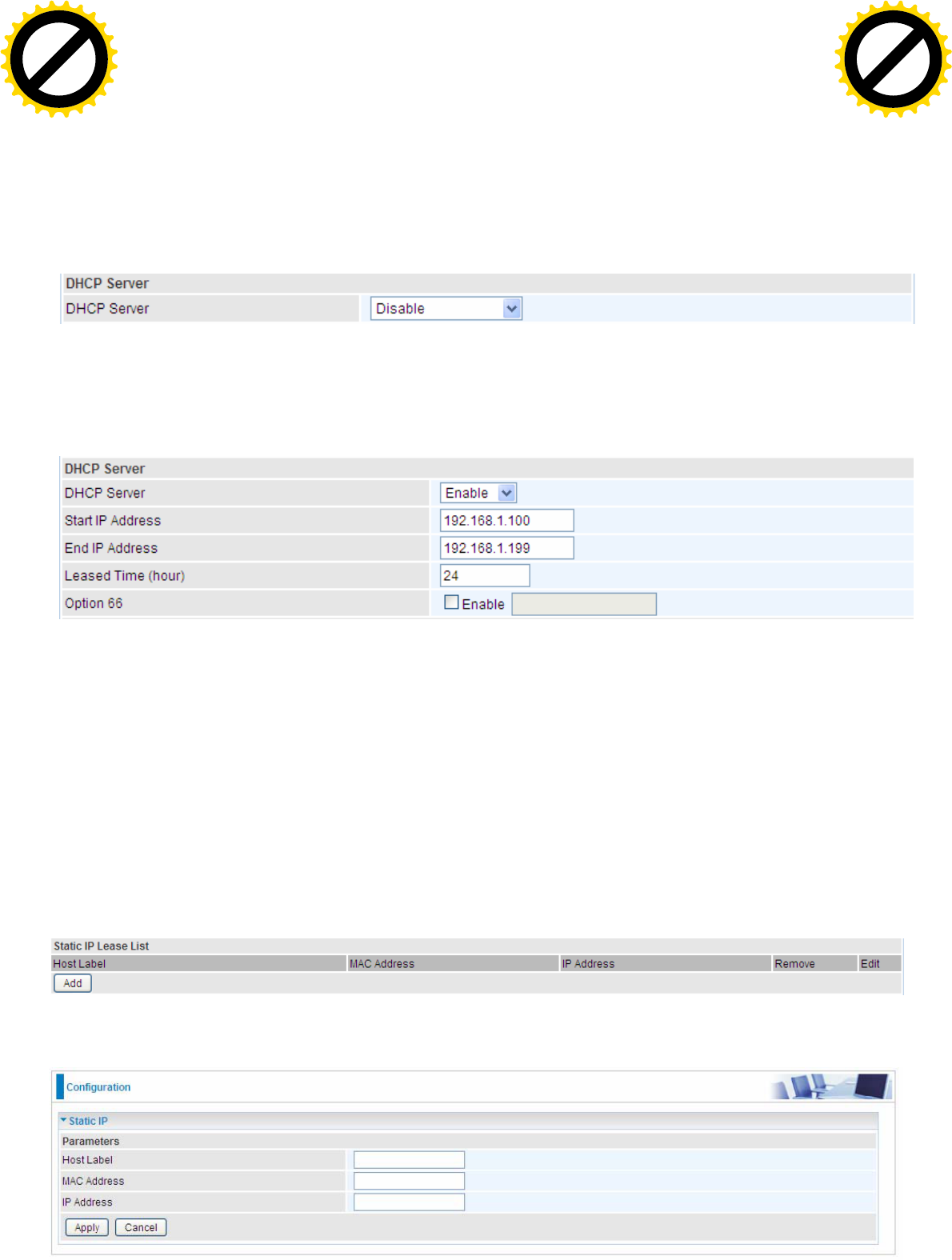
79
CPE from the specified LAN group.
DHCP Server
You can disable or enable the DHCP (Dynamic Host Configuration Protocol) server or enable the
router’s DHCP relay functions. The DHCP protocol allows your router to dynamically assign IP
addresses to PCs on your network if they are configured to obtain IP addresses automatically.
Disable
Disable the DHCP Server function.
Enable
Enable the DHCP function, enter the information wanted. Here as default.
Start IP Address: The start IP address of the range the DHCP Server used to assign to the Clients.
End IP Address: The end IP address f the range the DHCP Server used to assign to the Clients.
Leased Time (hour): The leased time for each DHCP Client.
Option 66: Click Enable to activate DHCP option 66 for some special devices, like IPTV Set Box.
The devices can get firmware or some special service from the TFTP server. User needs to set the
IP or hostname of the TFTP server.
Static IP List
The specified IP will be assigned to the corresponding MAC Address listed in the following table
when DHCP Server assigns IP Addresses to Clients.
Press Add to the Static IP List.
Enter the MAC Address, IP Address, and then click Apply to confirm your settings. But the IP
Click to buy NOW!
P
D
F
-
X
C
h
a
n
g
e
V
i
e
w
e
r
w
w
w
.
d
o
c
u
-
t
r
a
c
k
.
c
o
m
Click to buy NOW!
P
D
F
-
X
C
h
a
n
g
e
V
i
e
w
e
r
w
w
w
.
d
o
c
u
-
t
r
a
c
k
.
c
o
m
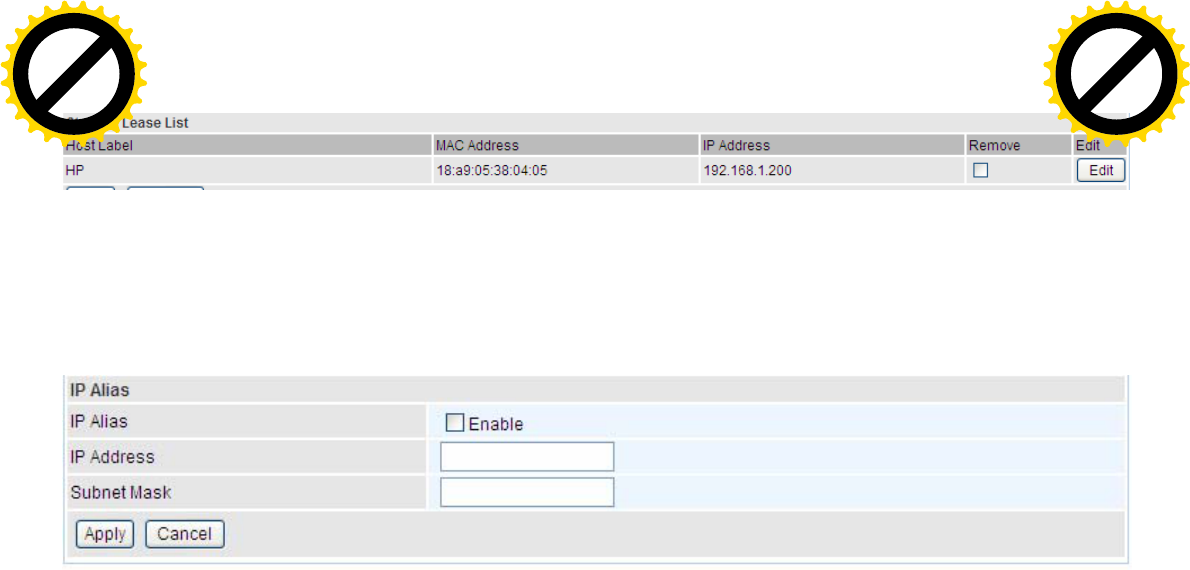
80
assigned should be outside the range of 192.168.1.100-192.168.1.199.
IP Alias
This function allows the creation of multiple virtual IP interfaces on this router. It helps to connect two
or more local networks to the ISP or remote node.
IP Alias: Check whether to enable this function.
IP Address: Specify an IP address on this virtual interface.
Subnet Mask: Specify a subnet mask on this virtual interface.
Click Apply to apply your settings.
Click to buy NOW!
P
D
F
-
X
C
h
a
n
g
e
V
i
e
w
e
r
w
w
w
.
d
o
c
u
-
t
r
a
c
k
.
c
o
m
Click to buy NOW!
P
D
F
-
X
C
h
a
n
g
e
V
i
e
w
e
r
w
w
w
.
d
o
c
u
-
t
r
a
c
k
.
c
o
m
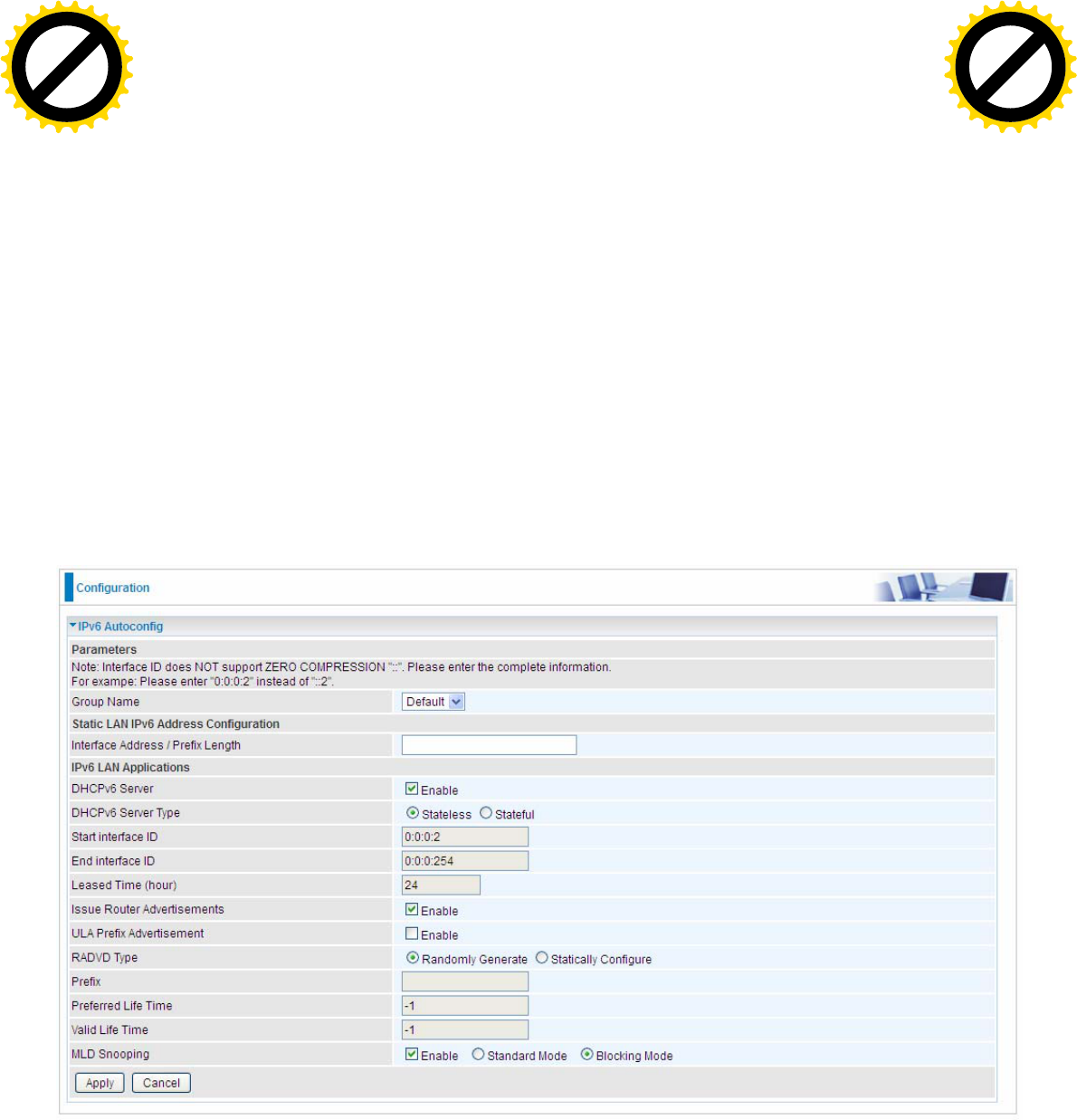
81
IPv6 Autoconfig
The IPv6 address composes of two parts, the prefix and the interface ID.
There are two ways to dynamically configure IPv6 address on hosts. One is “stateful” configuration,
for example using DHCPv6 (which resembles its counterpart DHCP in IPv4.) In the stateful auto-
configuration model, hosts obtain interface addresses and/or configuration information and
parameters from a DHCPv6 server. The Server maintains a database that keeps track of which
addresses have been assigned to which hosts.
The second way is “stateless” configuration. Stateless auto-configuration requires no manual
configuration of hosts, minimal (if any) configuration of routers, and no additional servers. The
stateless mechanism allows a host to generate its own addresses using a combination of locally
available information (MAC address) and information (prefix) advertised by routers. Routers
advertise prefixes that identify the subnet(s) associated with a link, while hosts generate an
"interface identifier" that uniquely identifies an interface on a subnet. An address is formed by
combining the two. When using stateless configuration, you needn’t configure anything on the client.
Group Name: Here group refers to the group you set in Interface Grouping section, you can set
the parameters for the specific group. Select the group by the drop-down box. For more
information please refer to Interface Grouping of this manual.
Static LAN IPv6 Address Configuration
Interface Address / Prefix Length: Enter the static LAN IPv6 address.
IPv6 LAN application
DHCPv6 Server: Check whether to enable DHCPv6 server.
DHCPv6 Server Type: Select Stateless or Stateful. When DHCPv6 is enabled, this parameter is
Click to buy NOW!
P
D
F
-
X
C
h
a
n
g
e
V
i
e
w
e
r
w
w
w
.
d
o
c
u
-
t
r
a
c
k
.
c
o
m
Click to buy NOW!
P
D
F
-
X
C
h
a
n
g
e
V
i
e
w
e
r
w
w
w
.
d
o
c
u
-
t
r
a
c
k
.
c
o
m

82
available. Stateless: If selected, the PCs in LAN are configured through RA mode, thus, the PCs in
LAN are configured through RA mode, to obtain the prefix message and generate an address using
a combination of locally available information (MAC address) and information (prefix) advertised by
routers, but they can obtain such information like DNS from DHCPv6 Server. Stateful: if selected,
the PCs in LAN will be configured like in IPv4 mode, thus obtain addresses and DNS information
from DHCPv6 server.
Start interface ID: Enter the start interface ID. The IPv6 address composed of two parts, thus, the
prefix and the interface ID. Interface is like the Host ID compared to IPv4.
End interface ID: Enter the end interface ID.
Note: Interface ID does NOT support ZERO COMPRESSION "::". Please enter the complete
information.
For example: Please enter "0:0:0:2" instead of "::2".
Leased Time (hour): The leased time, similar to leased time in DHCPv4, is a time limit assigned to
clients, when expires, the assigned ID will be recycled and reassigned.
Issue Router Advertisement: Check whether to enable issue Router Advertisement feature. It is to
send Router Advertisement messages periodically.
ULA Prefix Advertisement: Enable this parameter to include the ipv6 ULA address in the RA
messages. ULA, unique local address, is an IPv6 address in the block fc00::/7. It is approximately
the IPv6 counterpart of the IPv4 private address. They are not routable in the global IPv6 Internet.
RADVD Type: The way that ULA prefix is generated.
Randomly Generated
Statically Configured: select to set manually in the following parameters.
Prefix: Set the prefix manually.
Preferred Life Time: The ULA prefix life time. When the time is over, the ULA prefix is invalid any
more, -1 means no limit.
Valid Life Time: It is a time threshold, when the time is over, clients should obtain new IPv6 address
from the router through RA; -1 means to be limitless.
MLD snooping: Similar to IGMP snooping, listens in on the MLD conversation between hosts and
routers by processing MLD packets sent in a multicast network, and it analyzes all MLD packets
between hosts and the connected multicast routers in the network. Without MLD snooping, multicast
traffic is treated in the same manner as broadcast traffic - that is, it is forwarded to all ports. With
MLD snooping, multicast traffic of a group is only forwarded to ports that have members of that
group.
Standard Mode: In standard mode, multicast traffic will flood to all bridge ports when no
client subscribes to a multicast group.
Blocking Mode: In blocking mode, the multicast data will be blocked when there is no
client subscribes to a multicast group, it won’t flood to the bridge ports.
Click to buy NOW!
P
D
F
-
X
C
h
a
n
g
e
V
i
e
w
e
r
w
w
w
.
d
o
c
u
-
t
r
a
c
k
.
c
o
m
Click to buy NOW!
P
D
F
-
X
C
h
a
n
g
e
V
i
e
w
e
r
w
w
w
.
d
o
c
u
-
t
r
a
c
k
.
c
o
m
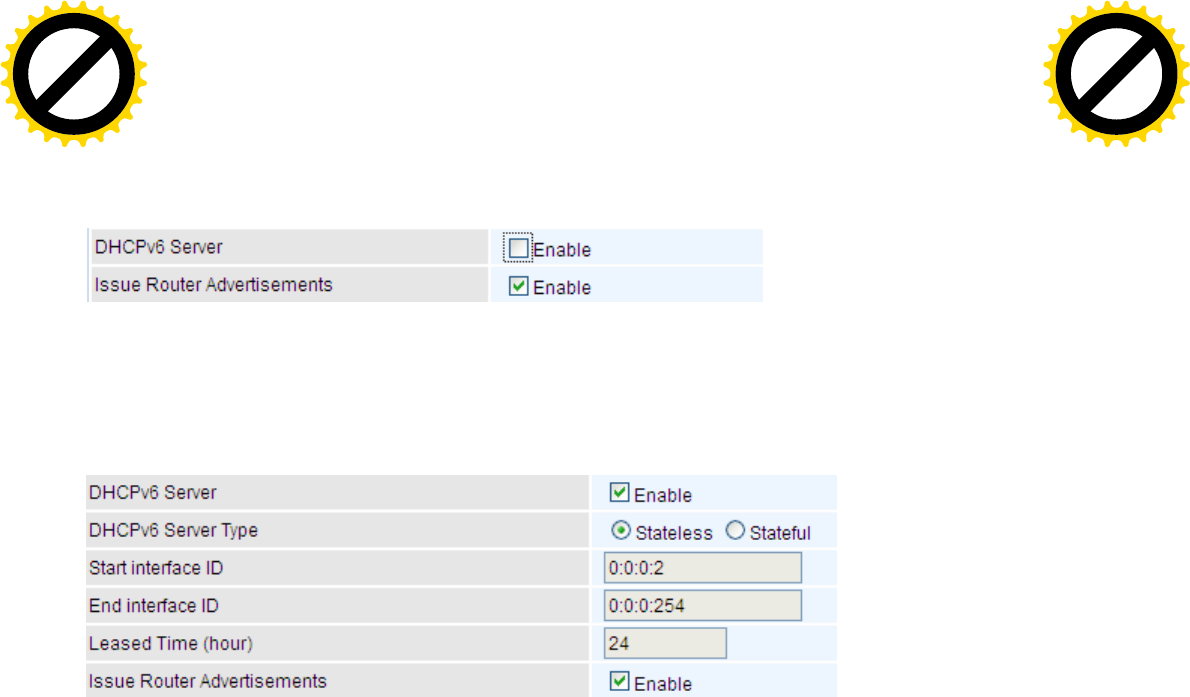
83
Stateless and Stateful IPv6 address Configuration
Stateless: Two methods can be carried.
With DHCPv6 disabled, but Issue Router Advertisement Enabled
With this method, the PCs in LAN are configured through RA mode, thus, the PCs in LAN are
configured through RA mode, to obtain the prefix message and generate an address using a
combination of locally available information (MAC address) and information (prefix) advertised by
routers.
With both DHCPv6 and Issue Router Advertisement Enabled
With this method, the PCs’ addresses in LAN are configured like above method, but they can
obtain such information like DNS from DHCPv6 Server.
Click to buy NOW!
P
D
F
-
X
C
h
a
n
g
e
V
i
e
w
e
r
w
w
w
.
d
o
c
u
-
t
r
a
c
k
.
c
o
m
Click to buy NOW!
P
D
F
-
X
C
h
a
n
g
e
V
i
e
w
e
r
w
w
w
.
d
o
c
u
-
t
r
a
c
k
.
c
o
m
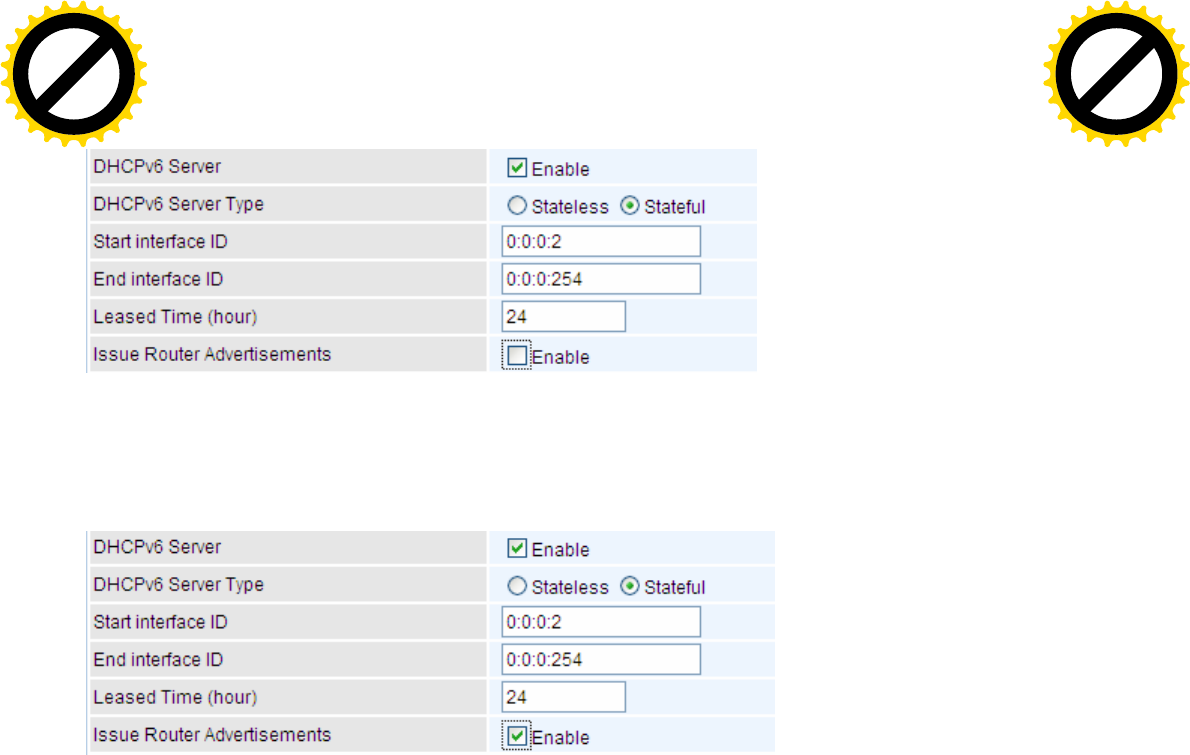
84
Stateful: two methods can be adopted.
With only DHCPv6 enabled
With this method, the PCs’ addresses are configured the same as in IPv4, that is addresses are
assigned by DHCPv6 server.
With both DHCPv6 and Issue Router Advertisement Enabled
With this method, the PCs’ addresses are configured the same like above, and the address
information in RA packets will be neglected.
Click to buy NOW!
P
D
F
-
X
C
h
a
n
g
e
V
i
e
w
e
r
w
w
w
.
d
o
c
u
-
t
r
a
c
k
.
c
o
m
Click to buy NOW!
P
D
F
-
X
C
h
a
n
g
e
V
i
e
w
e
r
w
w
w
.
d
o
c
u
-
t
r
a
c
k
.
c
o
m
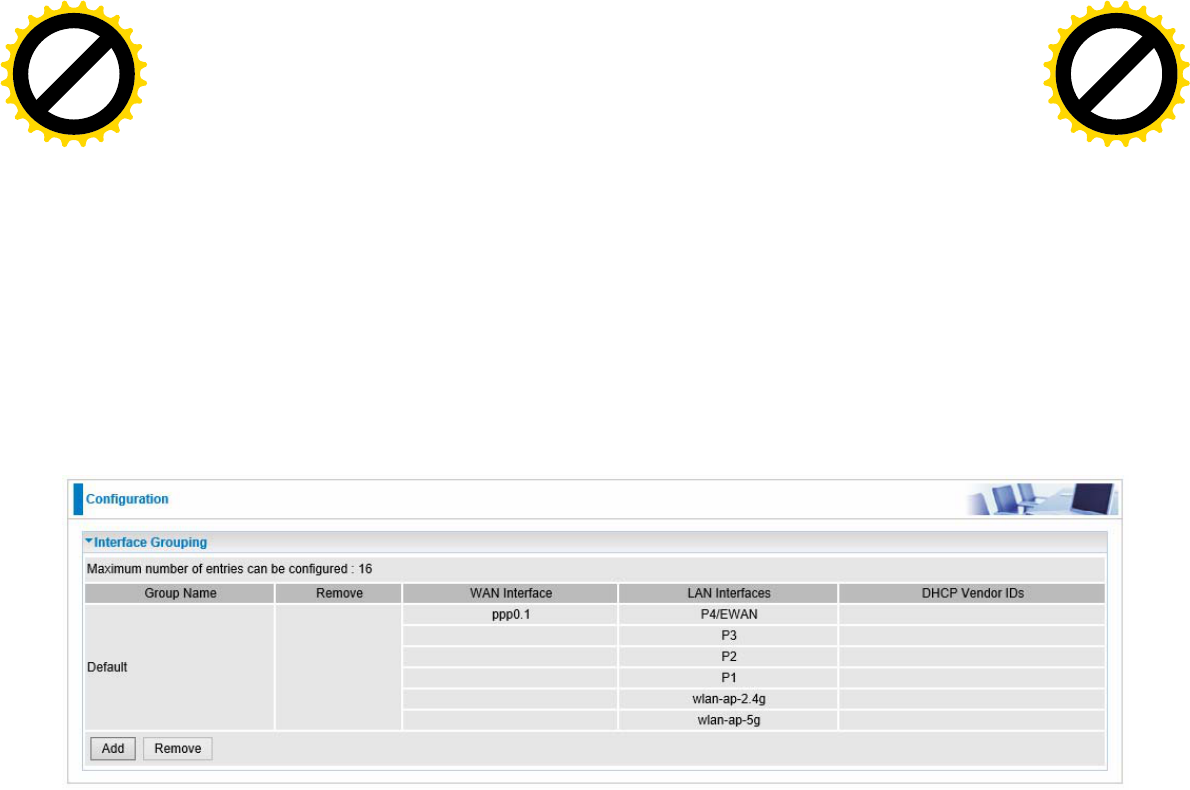
85
Interface Grouping
Interface grouping is a function to group interfaces, known as VLAN. A Virtual LAN, commonly known
as a VLAN, is a group of hosts with the common set of requirements that communicate as if they were
attached to the same broadcast domain, regardless of the physical location. A VLAN has the same
attributes as a physical LAN, but it allows for end stations to be grouped together even if they are not
located on the same network switch.
Each group will perform as an independent network. To support this feature, you must create
mapping groups with appropriate LAN and WAN interfaces using the Add button.
(Please Note: P4 can be configured as EWAN, and when the device is in EWAN profile, there is no
P4/EWAN interface as P4 is working as a WAN port.)
Click to buy NOW!
P
D
F
-
X
C
h
a
n
g
e
V
i
e
w
e
r
w
w
w
.
d
o
c
u
-
t
r
a
c
k
.
c
o
m
Click to buy NOW!
P
D
F
-
X
C
h
a
n
g
e
V
i
e
w
e
r
w
w
w
.
d
o
c
u
-
t
r
a
c
k
.
c
o
m
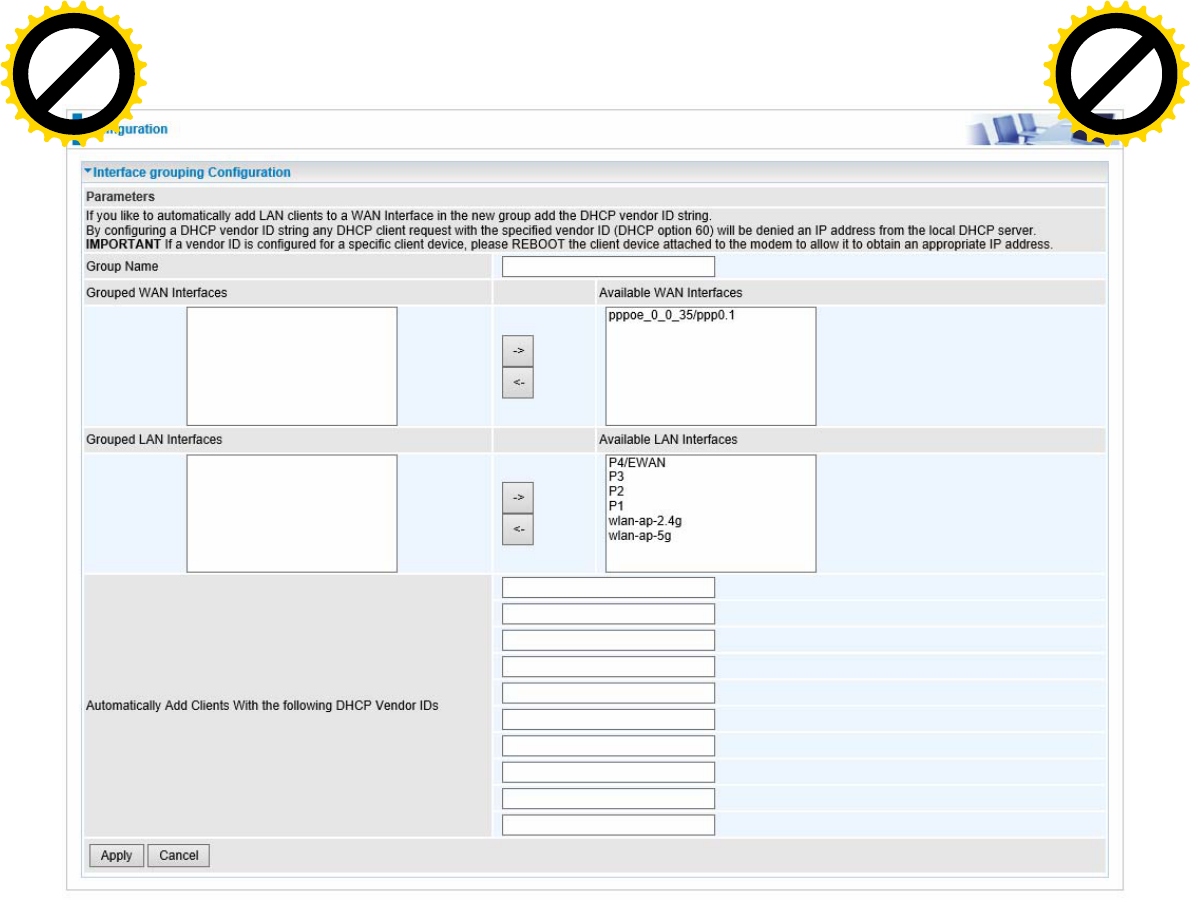
86
Click Add to add groups.
Group Name: Type a group name.
Grouped WAN Interfaces: Select from the box the WAN interface you want to applied in the group.
Grouped LAN Interfaces: Select the LAN interfaces you want to group as a single group from
Available LAN Interfaces.
Automatically Add Clients with following DHCP Vendor IDs: Enter the DHCP Vendor IDs for
which you want the Clients automatically added into the group. DHCP vendor ID (DHCP 60) is an
Authentication for DHCP Messages.
Click Apply to confirm your settings and your added group will be listed in the Interface Grouping
table below.
Click to buy NOW!
P
D
F
-
X
C
h
a
n
g
e
V
i
e
w
e
r
w
w
w
.
d
o
c
u
-
t
r
a
c
k
.
c
o
m
Click to buy NOW!
P
D
F
-
X
C
h
a
n
g
e
V
i
e
w
e
r
w
w
w
.
d
o
c
u
-
t
r
a
c
k
.
c
o
m
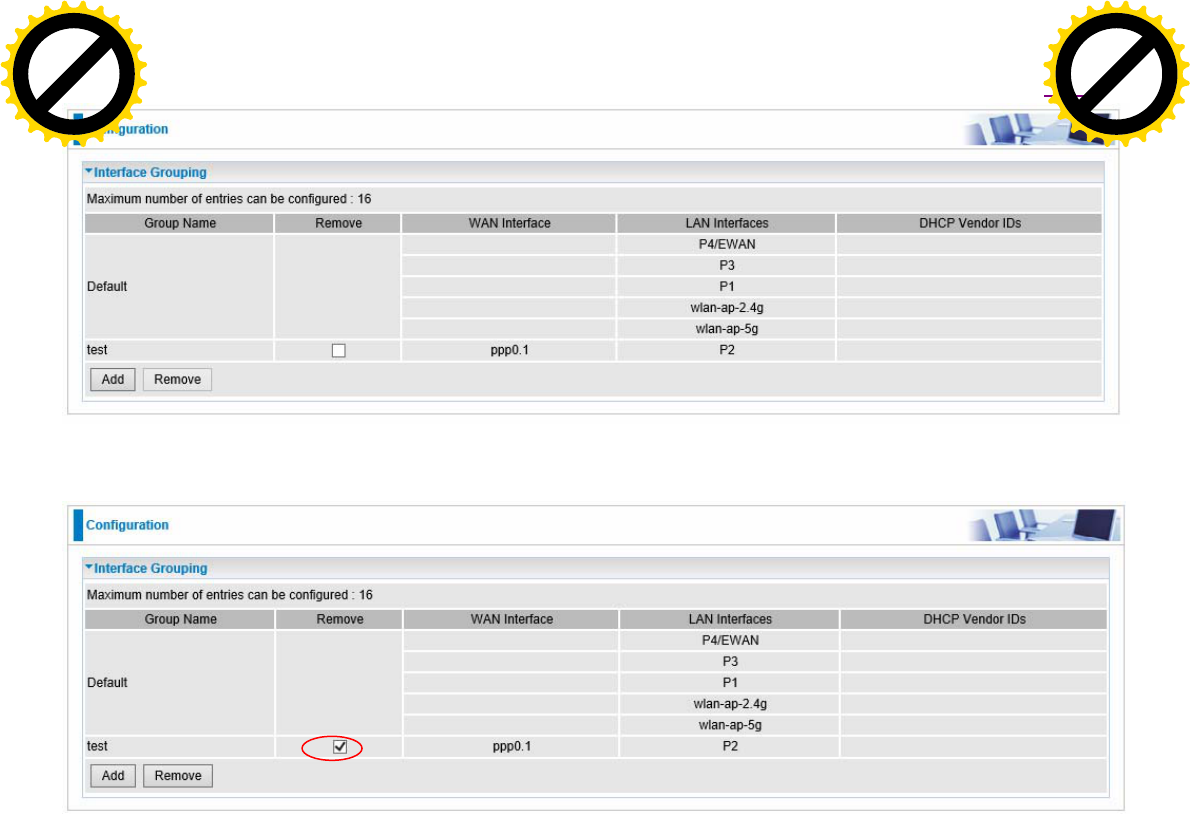
87
In group "test", P2 and PPP0.1 are grouped in one group, they have their only network , see LAN.
If you want to remove the group, check the box as the following and press Remove.
Note: If you like to automatically add LAN clients to a WAN Interface in the new group add the
DHCP vendor ID string.
By configuring a DHCP vendor ID string any DHCP client request with the specified vendor
ID (DHCP option 60) will be denied an IP address from the local DHCP server.
If a vendor ID is configured for a specific client device, please REBOOT the client device
attached to the modem to allow it to obtain an appropriate IP address.
Each LAN interface can only be added into one group and one WAN interface can only be
used in one group.
Click to buy NOW!
P
D
F
-
X
C
h
a
n
g
e
V
i
e
w
e
r
w
w
w
.
d
o
c
u
-
t
r
a
c
k
.
c
o
m
Click to buy NOW!
P
D
F
-
X
C
h
a
n
g
e
V
i
e
w
e
r
w
w
w
.
d
o
c
u
-
t
r
a
c
k
.
c
o
m

88
Wireless
This section provides you ways to configure wireless access. The BiPAC 7800VNP(O)X supports
wireless on the 2.4GHz for users. This part has sub-items as Basic, Security, MAC Filter, Wireless
Bridge, Advanced and Station Info here.
(7800VNPX)
Click to buy NOW!
P
D
F
-
X
C
h
a
n
g
e
V
i
e
w
e
r
w
w
w
.
d
o
c
u
-
t
r
a
c
k
.
c
o
m
Click to buy NOW!
P
D
F
-
X
C
h
a
n
g
e
V
i
e
w
e
r
w
w
w
.
d
o
c
u
-
t
r
a
c
k
.
c
o
m
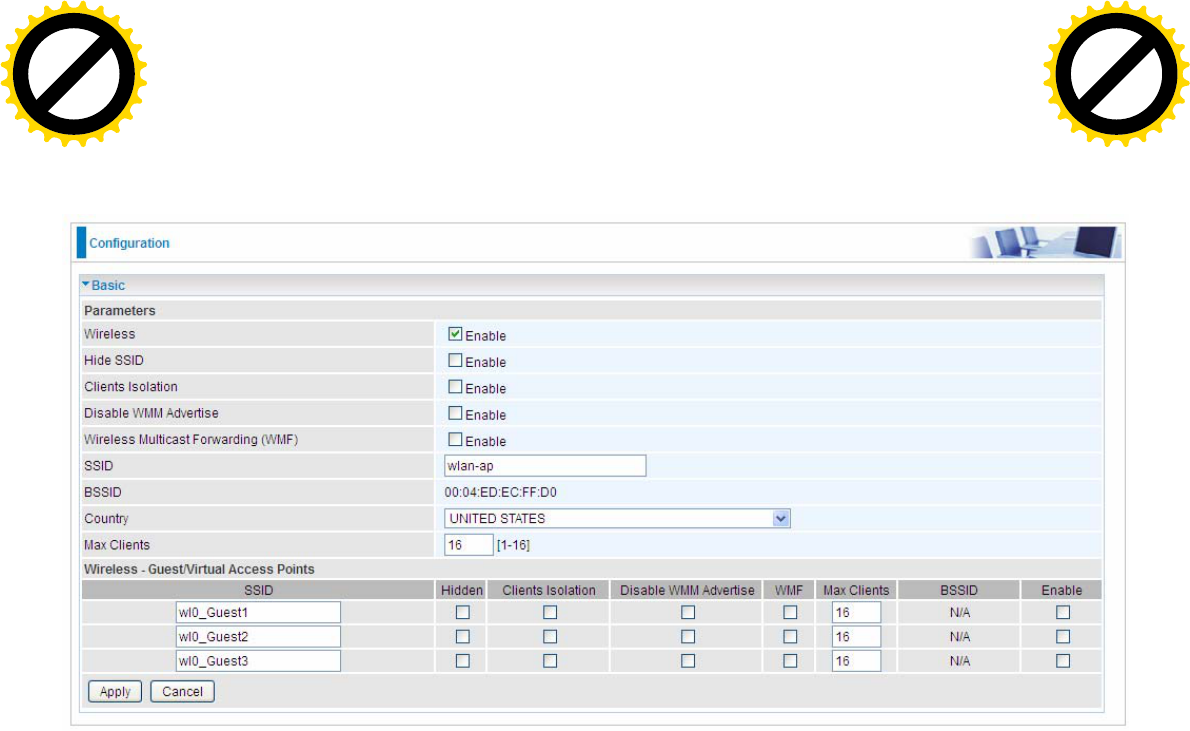
89
Basic
It let you determine whether to enable Wireless function and set the basic parameters of an AP and
the Virtual APs.
Wireless: Default setting is set to Enable. If you do not have any wireless devices, check the
checkbox again to unselect.
Hide SSID: It is function in which transmits its SSID to the air so that when wireless client searches
for a network, router can then be discovered and recognized. Check the checkbox to determine
whether you want to hide SSID.
Clients Isolation: if you enabled this function, then each of your wireless clients will not be able to
communicate with each other.
Disable WMM Advertise: Stop the router from ‘advertising’ its Wireless Multimedia (WMM)
functionality, which provides basic quality of service for time-sensitive applications (e.g. VoIP, Video).
Check to disable or enable this function.
Wireless multicast Forwarding (WMF): check to enable or disable wireless multicast forwarding.
SSID: The SSID is the unique name of a wireless access point (AP) to be distinguished from another.
For security purpose, change the default wlan-ap to a unique ID name to the AP already built-in to
the router’s wireless interface. It is case sensitive and must not excess 32 characters. Make sure
your wireless clients have exactly the SSID as the device, in order to get connected to your network.
Note: SSID is case sensitive and must not exceed 32 characters.
BSSID: Basic Set Service Identifier, it is a local managed IEEE MAC address, and is 48 bits value.
Country: Different countries have different wireless band resources, so you can select the
appropriate Country according to your location.
Max Clients: enter the number of max clients the wireless network can supports,1-16.
Guest/virtual Access Points: A “Virtual Access Point” is a logical entity that exists within a physical
Access Point (AP). When a single physical AP supports multiple “Virtual APs”, each Virtual AP
appears to stations (STAs) to be an independent physical AP, even though only a single physical AP
is present. For example, multiple Virtual APs might exist within a single physical AP, each advertising
a distinct SSID and capability set. Alternatively, multiple Virtual APs might advertise the same SSID
but a different capability set – allowing access to be provided via Web Portal, WEP, and WPA
Click to buy NOW!
P
D
F
-
X
C
h
a
n
g
e
V
i
e
w
e
r
w
w
w
.
d
o
c
u
-
t
r
a
c
k
.
c
o
m
Click to buy NOW!
P
D
F
-
X
C
h
a
n
g
e
V
i
e
w
e
r
w
w
w
.
d
o
c
u
-
t
r
a
c
k
.
c
o
m

90
simultaneously. Where APs are shared by multiple providers, Virtual APs provide each provider with
separate authentication and accounting data for their users, as well as diagnostic information,
without sharing sensitive management traffic or data between providers. You can enable the virtual
AP.
Here you can enable some Virtual APs according to the request. And the other parameters of virtual
APs are the same to the above.
Click Apply to apply your settings.
Click to buy NOW!
P
D
F
-
X
C
h
a
n
g
e
V
i
e
w
e
r
w
w
w
.
d
o
c
u
-
t
r
a
c
k
.
c
o
m
Click to buy NOW!
P
D
F
-
X
C
h
a
n
g
e
V
i
e
w
e
r
w
w
w
.
d
o
c
u
-
t
r
a
c
k
.
c
o
m
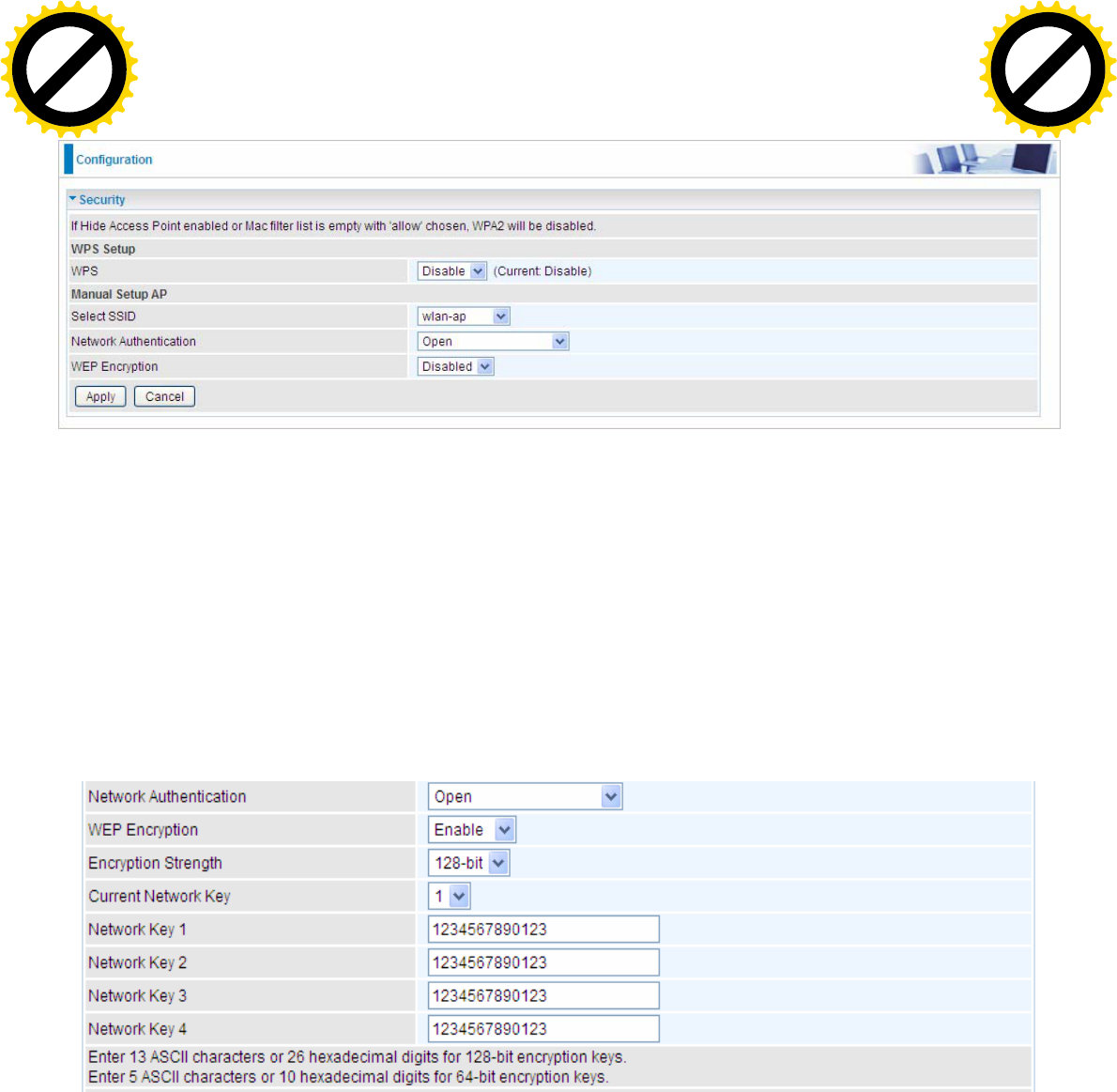
91
Security
Wireless security prevents unauthorized access or damage to computers using wireless network.
Note:
The WPS feature will also be unavailable when the security setting is not WPA2 or OPEN. So, if you
manually set the wireless security setting, you should give notice to it, but you can find prompt
indicating configuration.
Manual Setup AP
Select SSID: select the SSID you want these settings apply to.
Network Authentication
Open
WEP Encryption: Select to enable or disable WEP Encryption. Here select Enable.
Encryption Strength: Select the strength, 128-bit or 64-bit.
Current Network Key: Select the one to be the current network key. Please refer to key 1- 4 below.
Network Key (1- 4): Enter 13 ASCII characters or 26 hexadecimal digits for 128-bit encryption keys.
Enter 5 ASCII characters or 10 hexadecimal digits for 64-bit encryption keys.
Click to buy NOW!
P
D
F
-
X
C
h
a
n
g
e
V
i
e
w
e
r
w
w
w
.
d
o
c
u
-
t
r
a
c
k
.
c
o
m
Click to buy NOW!
P
D
F
-
X
C
h
a
n
g
e
V
i
e
w
e
r
w
w
w
.
d
o
c
u
-
t
r
a
c
k
.
c
o
m
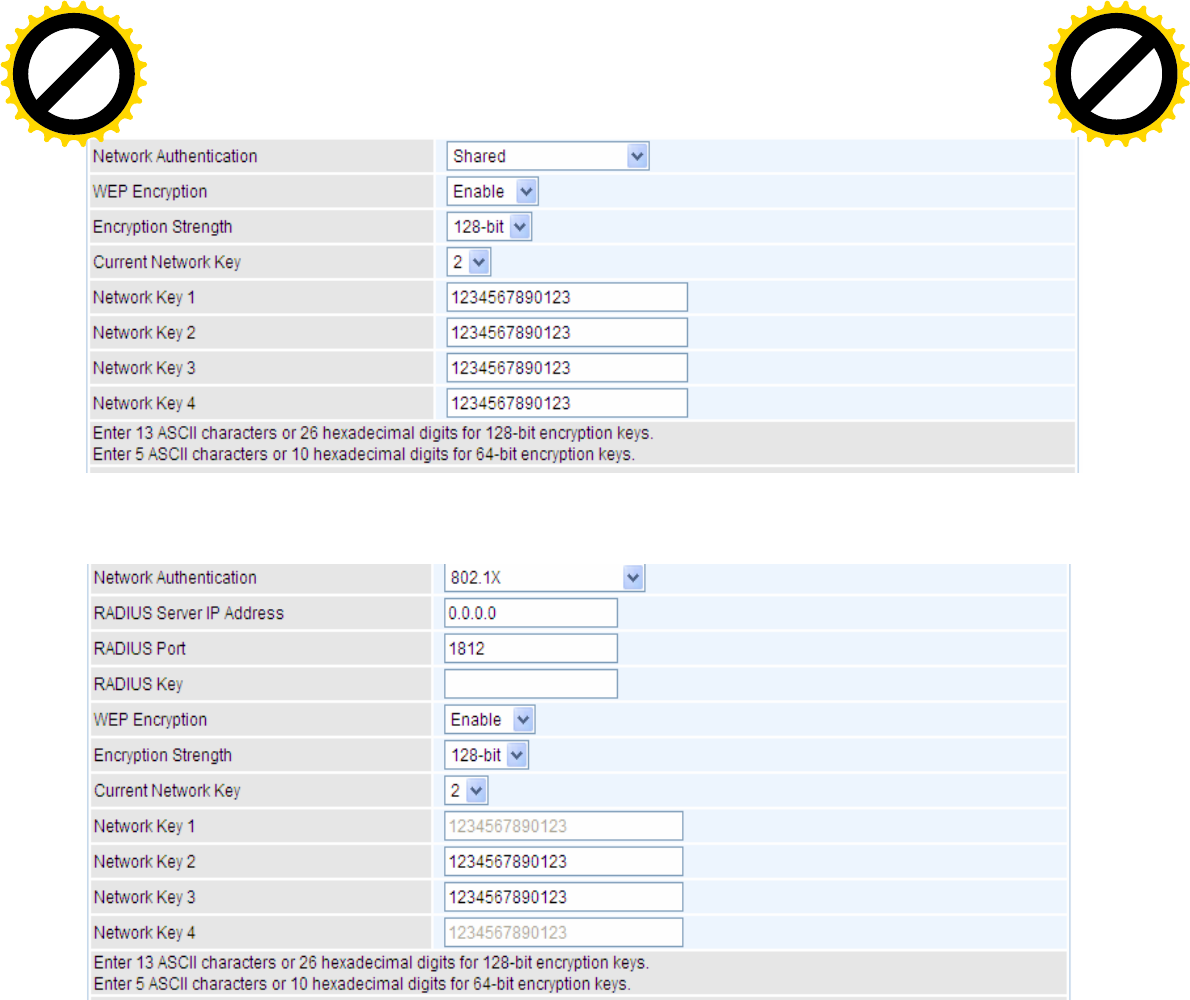
92
Shared
This is similar to network authentication ‘Open’. But here the WEP Encryption must be enabled.
802.1x
RADIUS Server IP Address: RADIUS( Remote Authentication Dial In User Service), Enter the
IP address of RADIUS authentication server.
RADIUS Server Port: Enter the port number of RADIUS authentication server here.
RADIUS Key: Enter the password of RADIUS authentication server.
WEP Encryption: Select to enable or disable WEP Encryption. Here select Enable.
Current Network Key: Select the one to be the current network key. Please refer to key 2- 3 below.
Network Key (1- 4): Enter 13 ASCII characters or 26 hexadecimal digits for 128-bit encryption keys.
Enter 5 ASCII characters or 10 hexadecimal digits for 64-bit encryption keys.
Click to buy NOW!
P
D
F
-
X
C
h
a
n
g
e
V
i
e
w
e
r
w
w
w
.
d
o
c
u
-
t
r
a
c
k
.
c
o
m
Click to buy NOW!
P
D
F
-
X
C
h
a
n
g
e
V
i
e
w
e
r
w
w
w
.
d
o
c
u
-
t
r
a
c
k
.
c
o
m
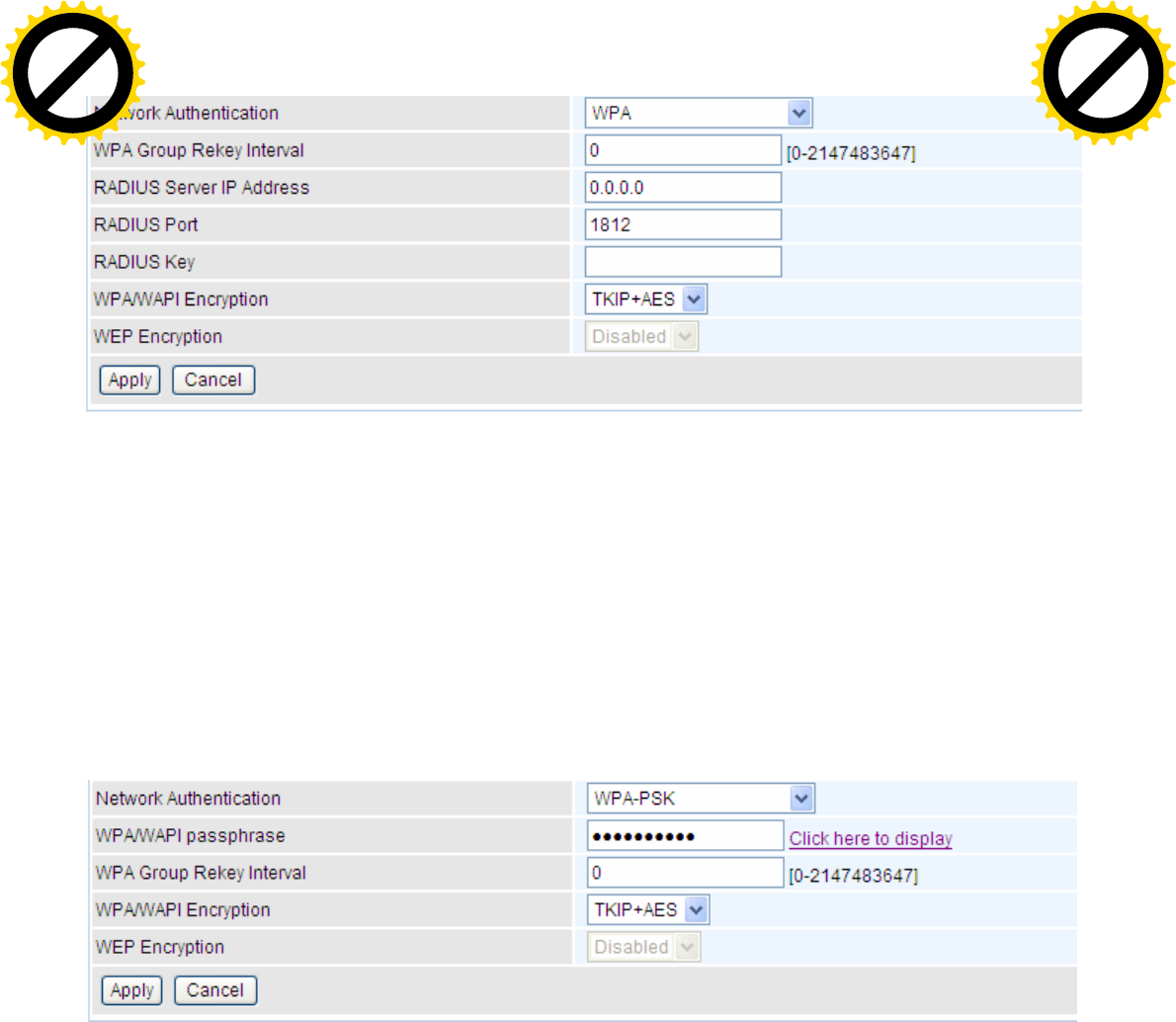
93
WPA
WPA Group ReKey Internal: The period of renewal time for changing the security key automatically
between wireless client and Access Point (AP). This is in seconds.
RADIUS Server IP Address: RADIUS( Remote Authentication Dial In User Service), Enter the
IP address of RADIUS authentication server.
RADIUS Server Port: Enter the port number of RADIUS authentication server here.
RADIUS Key: Enter the password of RADIUS authentication server.
WPA/WAPI Encryption: There are two Algorithms, AES (Advanced Encryption Standard) and
TKIP(Temporal Key Integrity Protocol) which help to protect the wireless communication.
WPA-PSK / WPA2-PSK
WPA/WAPI passphrase: Enter the WPA.WAPI passphrase; you can click here to display to view it.
WPA Group ReKey Internal: The period of renewal time for changing the security key automatically
between wireless client and Access Point (AP). This is in seconds.
WPA/WAPI Encryption: There are two Algorithms, AES (Advanced Encryption Standard) and
TKIP(Temporal Key Integrity Protocol) which help to protect the wireless communication.
Click to buy NOW!
P
D
F
-
X
C
h
a
n
g
e
V
i
e
w
e
r
w
w
w
.
d
o
c
u
-
t
r
a
c
k
.
c
o
m
Click to buy NOW!
P
D
F
-
X
C
h
a
n
g
e
V
i
e
w
e
r
w
w
w
.
d
o
c
u
-
t
r
a
c
k
.
c
o
m
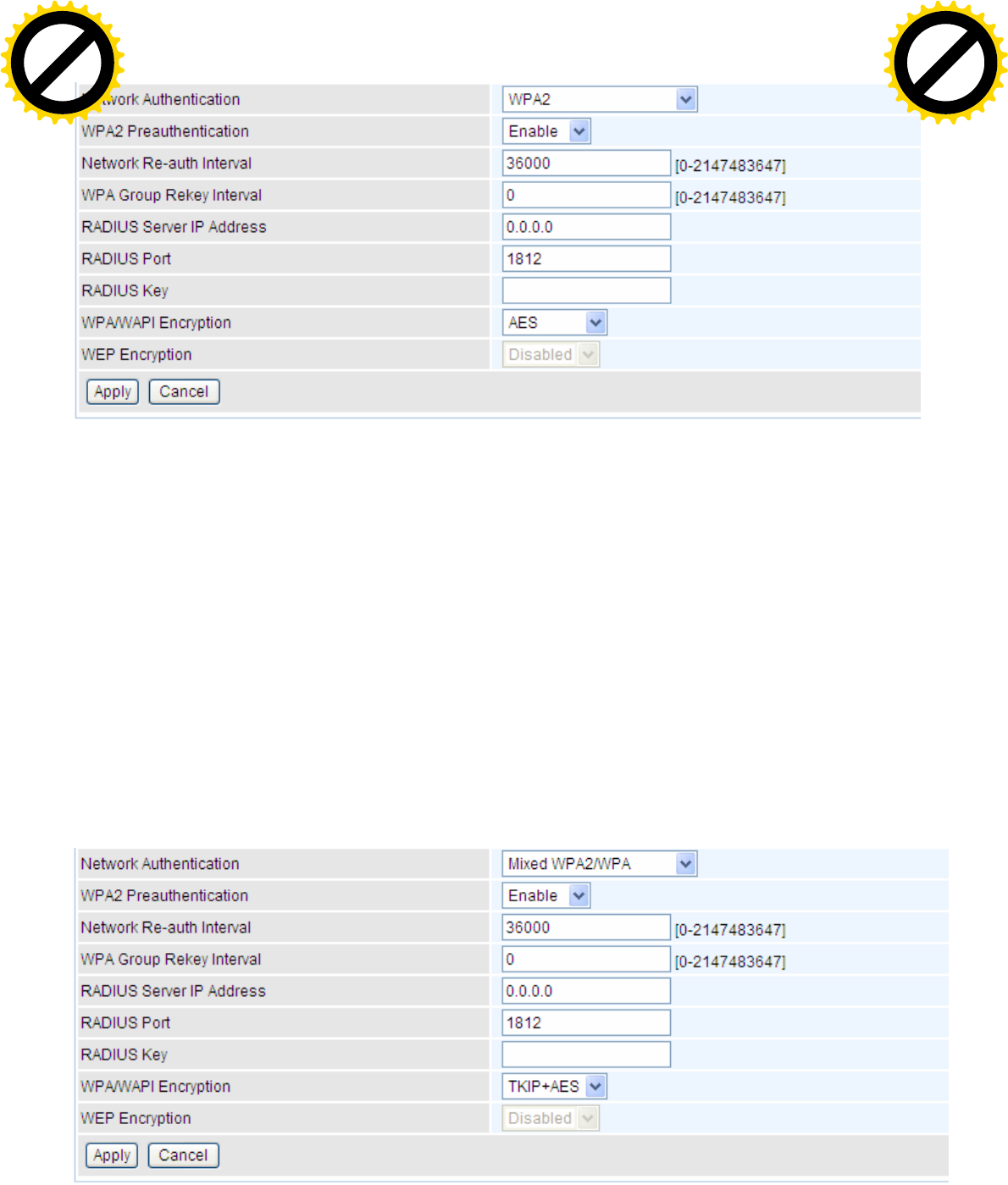
94
WPA2
WPA2 Preauthentication: When a wireless client wants to handoff to another AP, with
preauthentication, it can perform 802.1X authentication to the new AP, and when handoff happens,
this mode will help reduce the association time.
Network Re-auth Interval: the interval for network Re-authentication. This is in seconds.
WPA Group ReKey Internal: The period of renewal time for changing the security key automatically
between wireless client and Access Point (AP). This is in seconds.
RADIUS Server IP Address: RADIUS( Remote Authentication Dial In User Service), Enter the
IP address of RADIUS authentication server. This is in seconds.
RADIUS Server Port: Enter the port number of RADIUS authentication server here.
RADIUS Key: Enter the password of RADIUS authentication server.
WPA/WAPI Encryption: There are two Algorithms, AES (Advanced Encryption Standard) and
TKIP(Temporal Key Integrity Protocol) which help to protect the wireless communication.
Mixed WPA2/WPA
WPA2 Preauthentication: When a wireless client wants to handoff to another AP, with
preauthentication, it can perform 802.1X authentications to the new AP, and when handoff happens,
this mode will help reduce the association time used.
Network Re-auth Interval: the interval for network Re-authentication. The unit is second.
WPA Group ReKey Internal: The period of renewal time for changing the security key automatically
between wireless client and Access Point (AP). This is in seconds.
Click to buy NOW!
P
D
F
-
X
C
h
a
n
g
e
V
i
e
w
e
r
w
w
w
.
d
o
c
u
-
t
r
a
c
k
.
c
o
m
Click to buy NOW!
P
D
F
-
X
C
h
a
n
g
e
V
i
e
w
e
r
w
w
w
.
d
o
c
u
-
t
r
a
c
k
.
c
o
m
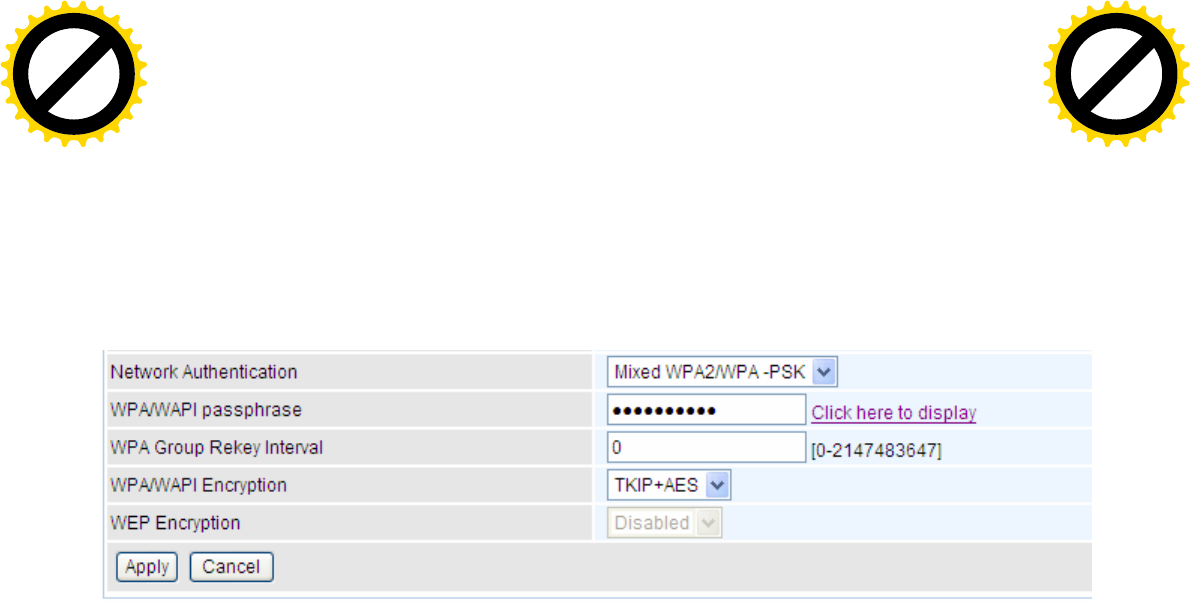
95
RADIUS Server IP Address: RADIUS( Remote Authentication Dial In User Service), Enter the
IP address of RADIUS authentication server.
RADIUS Server Port: Enter the port number of RADIUS authentication server here.
RADIUS Key: Enter the password of RADIUS authentication server.
WPA/WAPI Encryption: There are two Algorithms, AES (Advanced Encryption Standard) and
TKIP(Temporal Key Integrity Protocol) which help to protect the wireless communication.
Mixed WPA2/WPA-PSk
WPA/WAPI passphrase: enter the WPA.WAPI passphrase, you can click here to display to view it.
WPA Group ReKey Internal: The period of renewal time for changing the security key automatically
between wireless client and Access Point (AP). The unit is second.
WPA/WAPI Encryption: There are two Algorithms, AES (Advanced Encryption Standard) and
TKIP(Temporal Key Integrity Protocol) which help to protect the wireless communication.
Click to buy NOW!
P
D
F
-
X
C
h
a
n
g
e
V
i
e
w
e
r
w
w
w
.
d
o
c
u
-
t
r
a
c
k
.
c
o
m
Click to buy NOW!
P
D
F
-
X
C
h
a
n
g
e
V
i
e
w
e
r
w
w
w
.
d
o
c
u
-
t
r
a
c
k
.
c
o
m
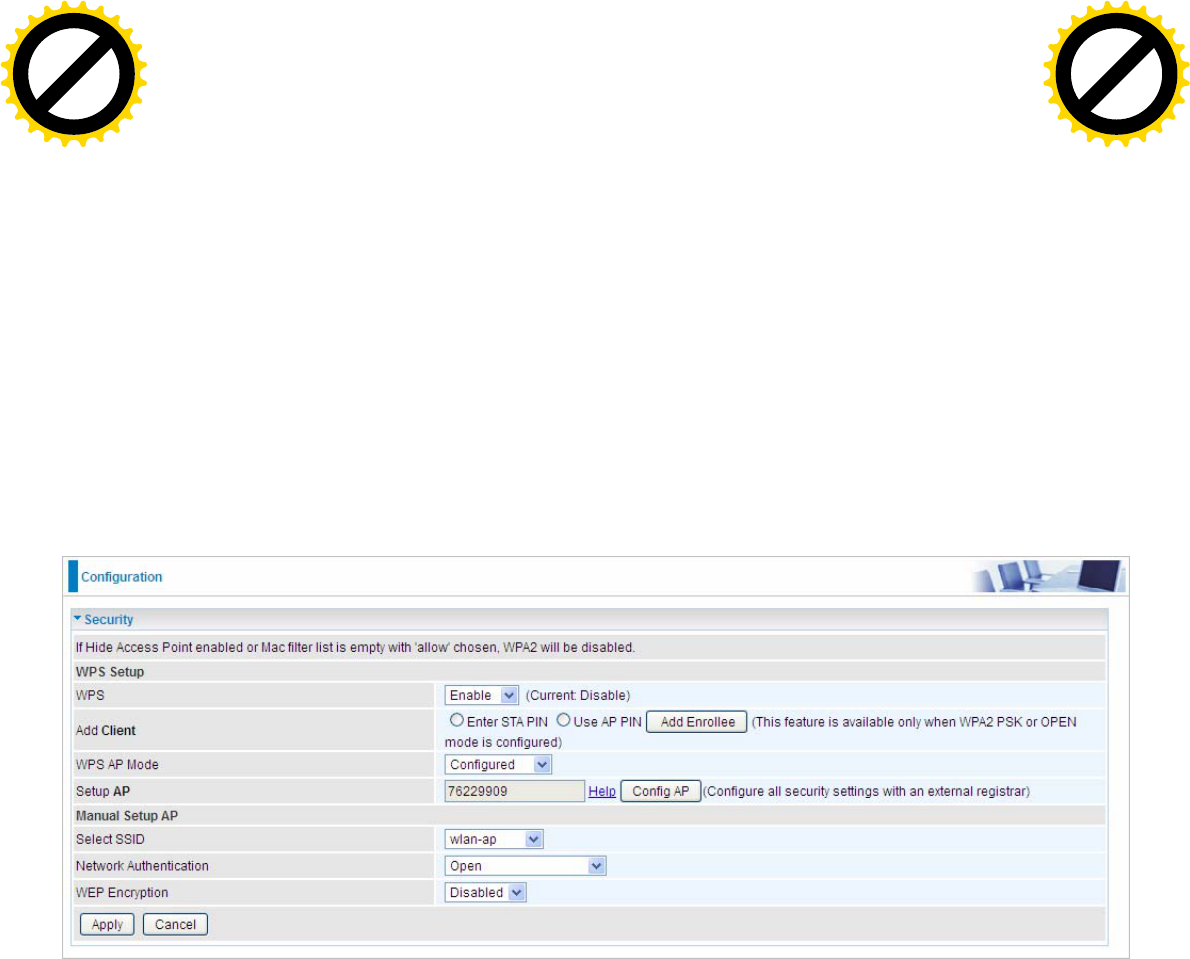
96
WPS Setup
WPS (Wi-Fi Protected Setup) feature is a standard protocol created by Wi-Fi Alliance. WPS is used
to exchange the AP setting with Station and configure Ap settings. This feature greatly simplifies the
steps needed to create a Wi-Fi network for a residential or an office setting. The commonly known
PIN method is supported to configure WPS.
WPS: Select enable to enable WPS function. Please note that WPS can only be available when
WPA2-PSK or OPEN mode is configured.
Note:
1) WPS feature is only available when in WPA2 or OPEN mode in security settings.
2) Here wireless can be configured as Registrar and Enrollee mode respectively. When AP is
configured as Registrar, you should select “Configured” in the WPS AP Mode below, and default
WPS AP Mode is “Configured”. When AP is configured as Enrollee, the WPS AP Mode below
should be changed to “Unconfigured”. Follow the following steps.
Click to buy NOW!
P
D
F
-
X
C
h
a
n
g
e
V
i
e
w
e
r
w
w
w
.
d
o
c
u
-
t
r
a
c
k
.
c
o
m
Click to buy NOW!
P
D
F
-
X
C
h
a
n
g
e
V
i
e
w
e
r
w
w
w
.
d
o
c
u
-
t
r
a
c
k
.
c
o
m
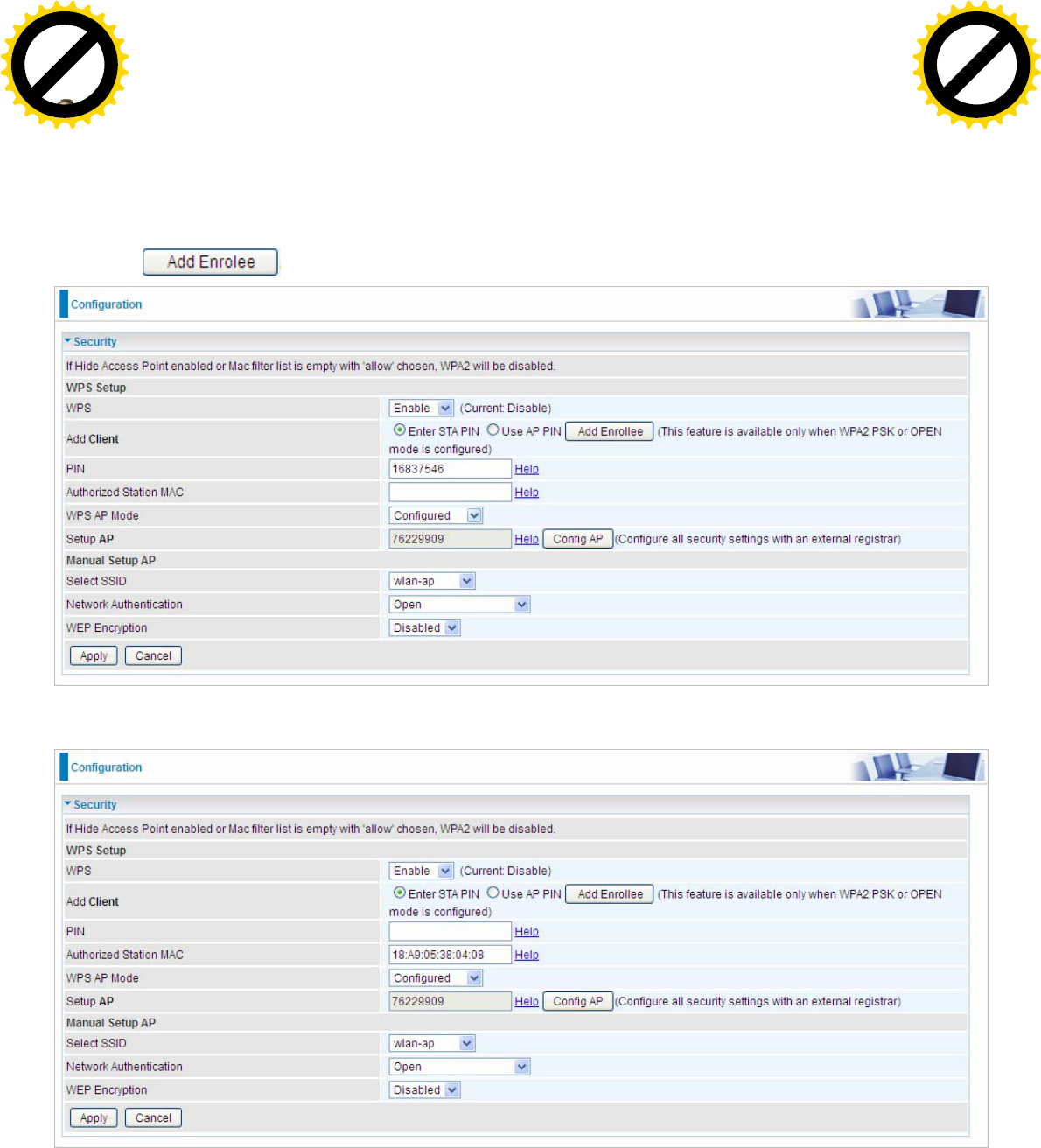
97
Configure AP as Registrar
Add Enrollee with PIN method
1. Select radio button “Enter STA PIN”.
2. Input PIN from Enrollee Station (16837546 in this example), Or else users can alternatively
enter the authorized station MAC Help: it is to help users to understand the concept and correct
operation.
3. Click .
(Station PIN)
(Station MAC)
Note: Users can alternatively input PIN from Enrollee Station or enter the authorized station MAC.
Click to buy NOW!
P
D
F
-
X
C
h
a
n
g
e
V
i
e
w
e
r
w
w
w
.
d
o
c
u
-
t
r
a
c
k
.
c
o
m
Click to buy NOW!
P
D
F
-
X
C
h
a
n
g
e
V
i
e
w
e
r
w
w
w
.
d
o
c
u
-
t
r
a
c
k
.
c
o
m
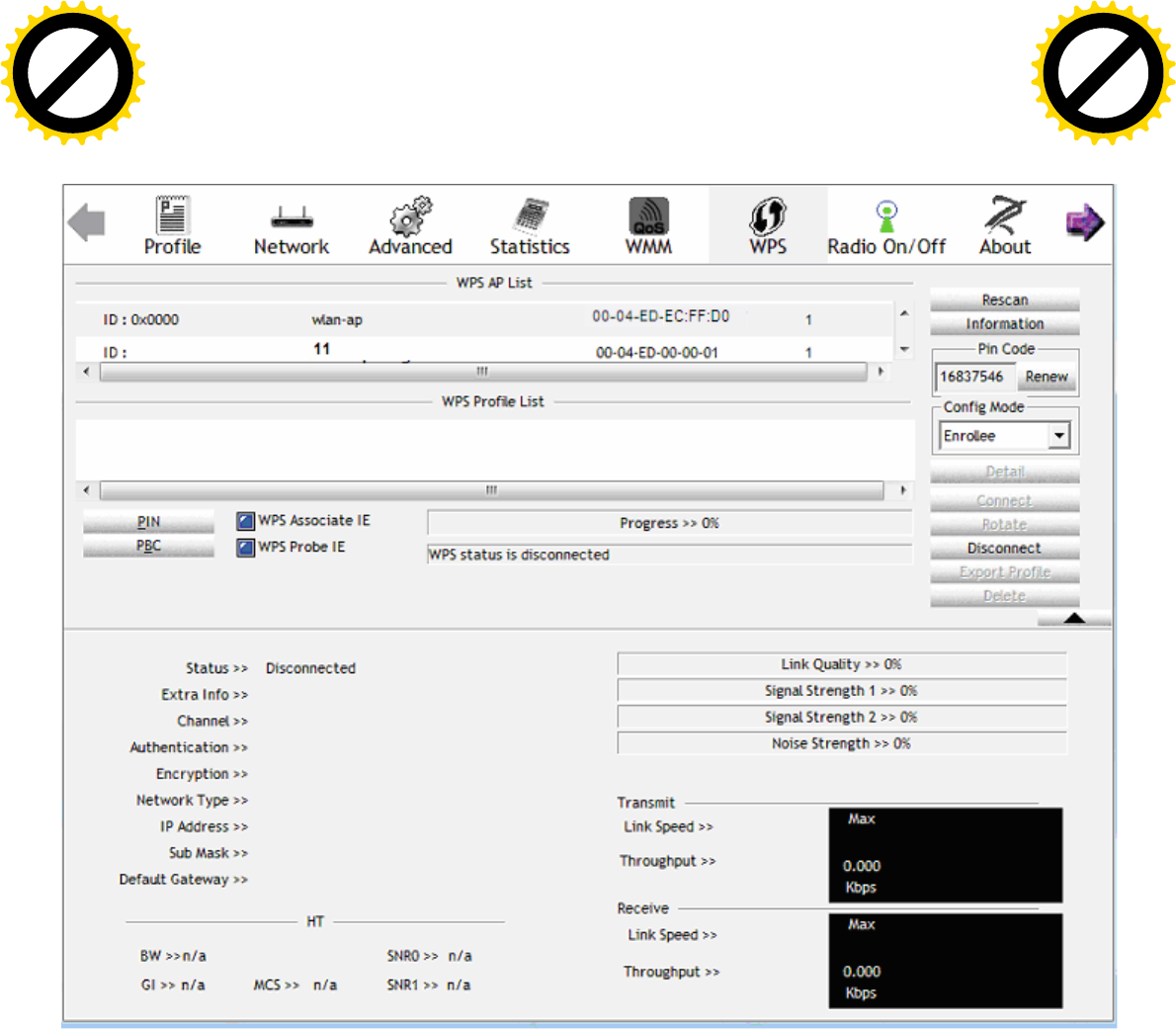
98
4. Operate Station to start WPS Adding Enrollee. Launch the wireless client’s WPS utility (eg.Ralink
Utility). Set the Config Mode as Enrollee, press the WPS button on the top bar, select the AP (eg.
Wlan-ap) from the WPS AP List column. Then press the PIN button located on the middle left of
the page to run the scan.
Click to buy NOW!
P
D
F
-
X
C
h
a
n
g
e
V
i
e
w
e
r
w
w
w
.
d
o
c
u
-
t
r
a
c
k
.
c
o
m
Click to buy NOW!
P
D
F
-
X
C
h
a
n
g
e
V
i
e
w
e
r
w
w
w
.
d
o
c
u
-
t
r
a
c
k
.
c
o
m
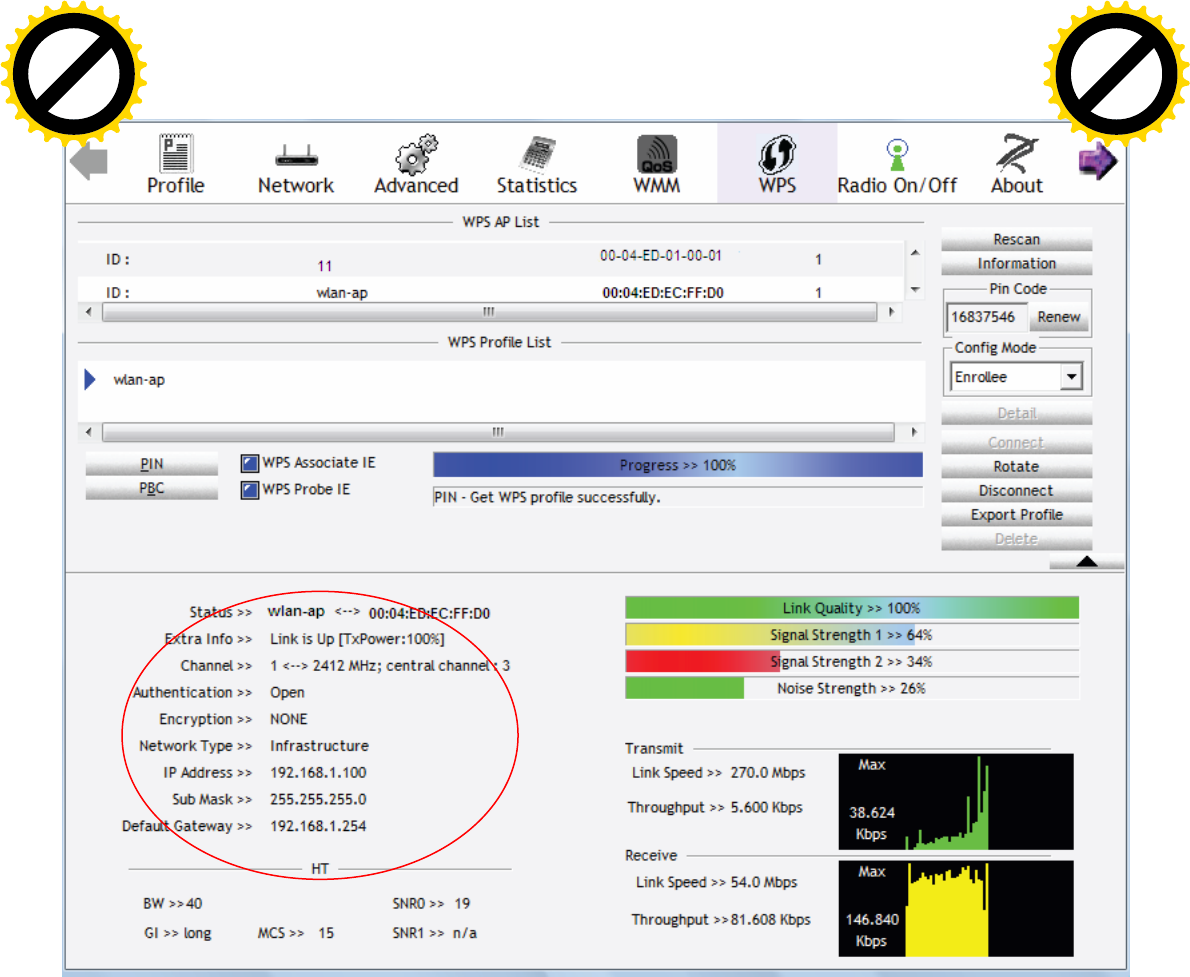
99
4. The client’s SSID and security settings will now be configured to match the SSID and security
settings of the registrar.
You can check the message in the red ellipse with the security parameters you set, here we all use
the default.
Click to buy NOW!
P
D
F
-
X
C
h
a
n
g
e
V
i
e
w
e
r
w
w
w
.
d
o
c
u
-
t
r
a
c
k
.
c
o
m
Click to buy NOW!
P
D
F
-
X
C
h
a
n
g
e
V
i
e
w
e
r
w
w
w
.
d
o
c
u
-
t
r
a
c
k
.
c
o
m
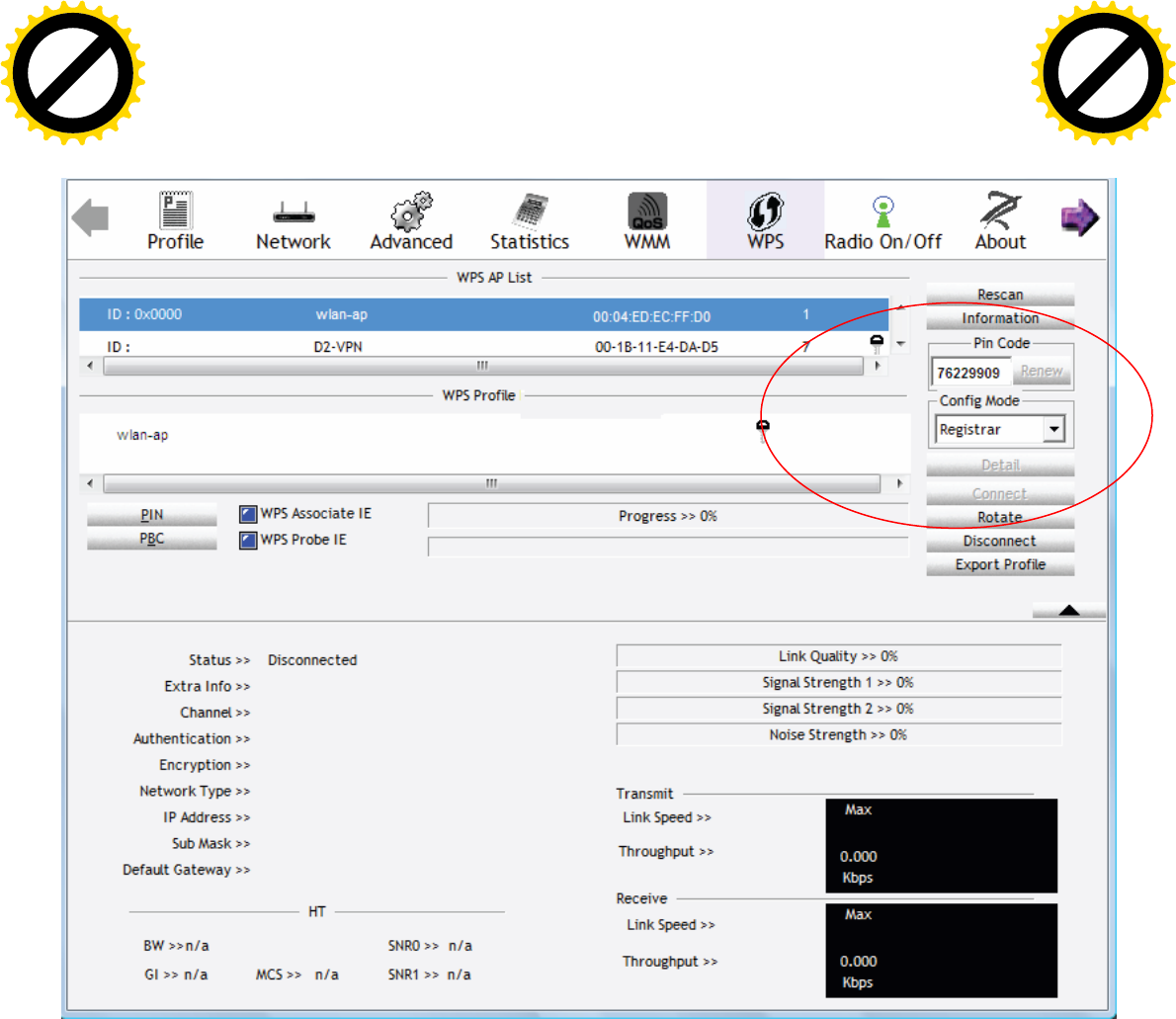
101
2. Launch the wireless client’s WPS utility (eg. Ralink Utility). Set the Config Mode as Registrar.
Enter the PIN number (76229909 (device) for example) in the PIN Code column then choose the
correct AP (eg. wlan-ap) from the WPS AP List section before pressing the PIN button to run the
scan.
Click to buy NOW!
P
D
F
-
X
C
h
a
n
g
e
V
i
e
w
e
r
w
w
w
.
d
o
c
u
-
t
r
a
c
k
.
c
o
m
Click to buy NOW!
P
D
F
-
X
C
h
a
n
g
e
V
i
e
w
e
r
w
w
w
.
d
o
c
u
-
t
r
a
c
k
.
c
o
m
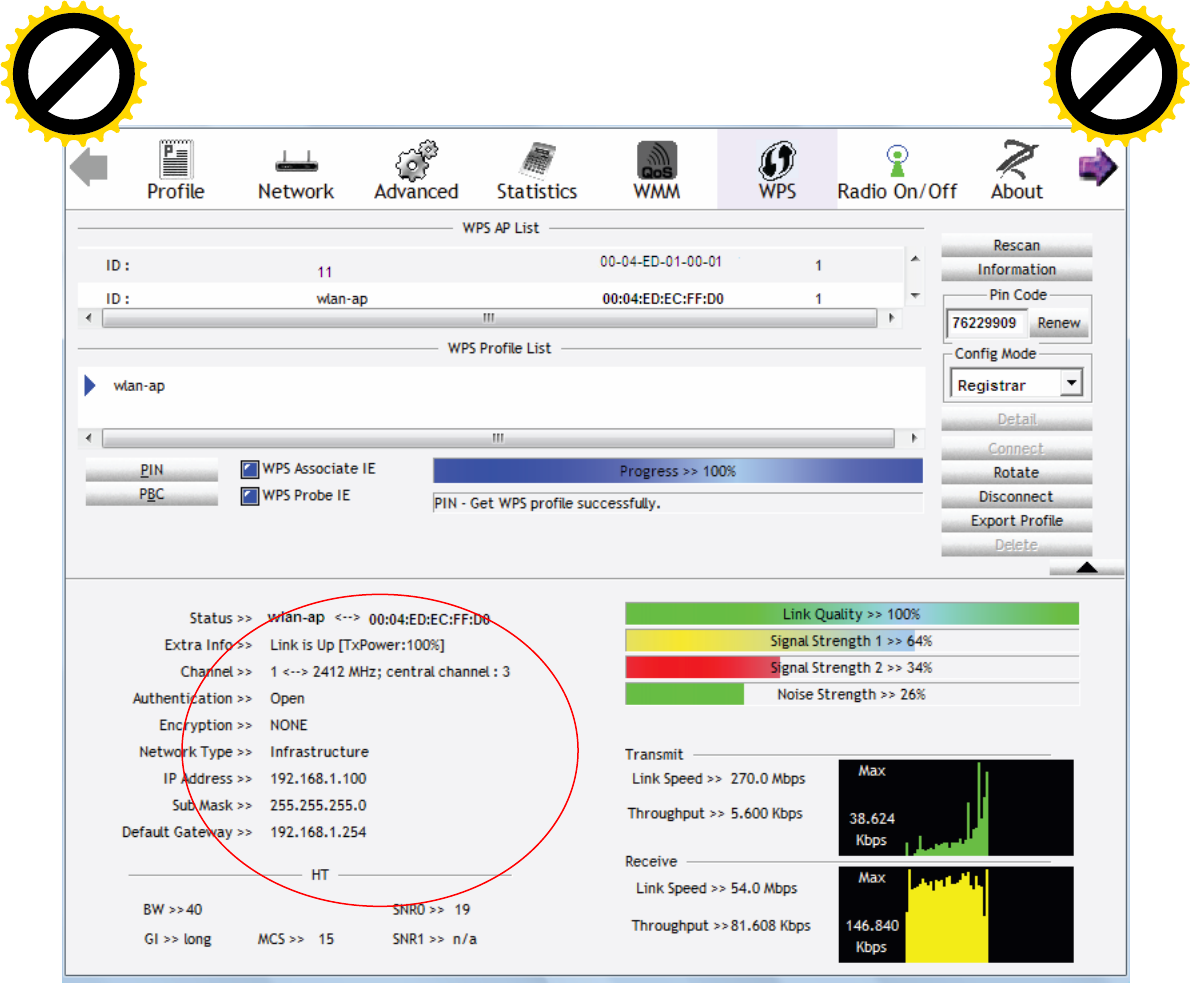
102
3. The router’s (AP’s) SSID and security setting will now be configured to match the SSID and
security setting of the registrar.
4. Do Web Page refresh after ER complete AP Configuration to check the new parameters setting.
Click to buy NOW!
P
D
F
-
X
C
h
a
n
g
e
V
i
e
w
e
r
w
w
w
.
d
o
c
u
-
t
r
a
c
k
.
c
o
m
Click to buy NOW!
P
D
F
-
X
C
h
a
n
g
e
V
i
e
w
e
r
w
w
w
.
d
o
c
u
-
t
r
a
c
k
.
c
o
m
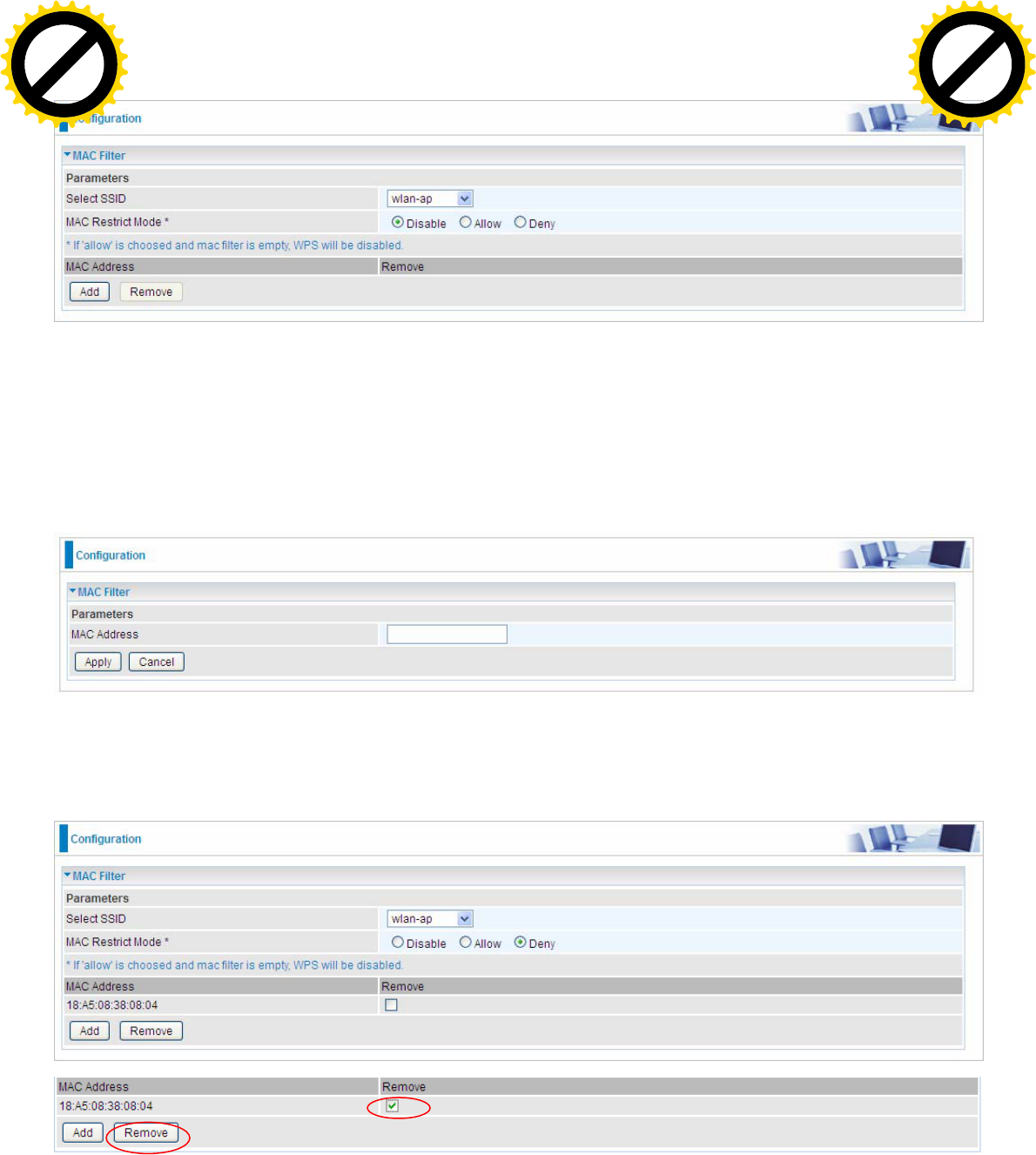
103
MAC Filter
Select SSID: select the SSID you want this filter applies to.
MAC Restrict Mode:
Disable: disable the MAC Filter function.
Allow: allow the hosts with the following listed MACs to access the wireless network.
Deny: deny the hosts with the following listed MACs to access the wireless network.
Click Add to add the MACs.
MAC Address: enter the MAC address(es). The format of MAC address could be: xx:xx:xx:xx:xx:xx
or xx-xx-xx-xx-xx-xx.
Click Apply to apply your settings and the item will be listed below.
If you don’t need a rule, check the remove checkbox and press Remove to delete it.
Click to buy NOW!
P
D
F
-
X
C
h
a
n
g
e
V
i
e
w
e
r
w
w
w
.
d
o
c
u
-
t
r
a
c
k
.
c
o
m
Click to buy NOW!
P
D
F
-
X
C
h
a
n
g
e
V
i
e
w
e
r
w
w
w
.
d
o
c
u
-
t
r
a
c
k
.
c
o
m
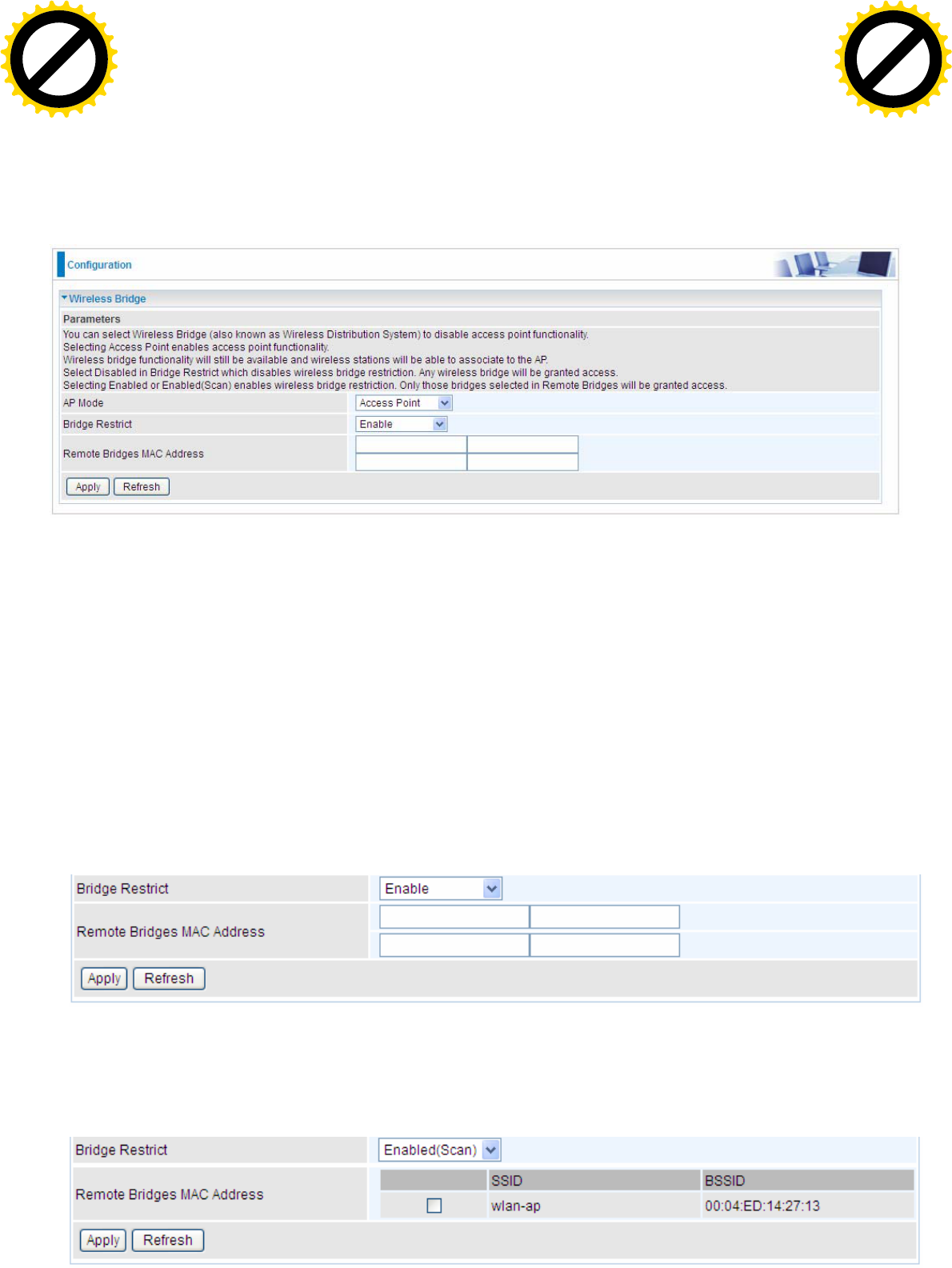
104
Wireless Bridge
WDS (wireless distributed system) is a wireless access point mode that enables wireless link and
communication with other access points. It’s easy to install, simply define the peer’s MAC address of
the connected AP. WDS takes advantage of cost saving and flexibility with no extra wireless client
device required to bridge between two access points and extending an existing wired or wireless
infrastructure network to create a larger network.
Here you can select what role the AP server has, AP or wireless bridge (WDS).
AP Mode: determines whether the gateway will act as an Access point or as a Bridge.
Access Point: the gateway communicates with both clients and bridges.
Wireless Bridge: the gateway communicates with other WDS devices only. In this mode, the
gateway doesn’t communicate with client devices.
If your wireless network includes repeaters that use WDS, the gateway in wireless bridge mode will
also communicate with your repeaters. The gateway in wireless bridge mode will not communicate
with a repeater that uses a proprietary (non-WDS) mode.
Bridge Restrict: When AP Mode is set to Wireless Bridge, this determines whether the gateway
will communicate with all other bridges or only specific ones:
Enable: to enable wireless bridge restriction. Only those specified in the Remote MAC
Address the gateway can communicate with.
Remote Bridge MAC Address: enter the remote bridge MAC addresses. Here up to 4 bridge
MAC addresses are supported.
Enabled (Scan): to enable wireless bridge restriction. Only those scanned by the gateway
can communicate.
Click to buy NOW!
P
D
F
-
X
C
h
a
n
g
e
V
i
e
w
e
r
w
w
w
.
d
o
c
u
-
t
r
a
c
k
.
c
o
m
Click to buy NOW!
P
D
F
-
X
C
h
a
n
g
e
V
i
e
w
e
r
w
w
w
.
d
o
c
u
-
t
r
a
c
k
.
c
o
m

105
Remote Bridge MAC Address: select the remote bridge MAC addresses.
Disable: Does not restrict the gateway communicating with bridges that have their MAC
address listed, but it is still open to communicate with all bridges that are in the same network.
Click Apply to apply your settings.
Click to buy NOW!
P
D
F
-
X
C
h
a
n
g
e
V
i
e
w
e
r
w
w
w
.
d
o
c
u
-
t
r
a
c
k
.
c
o
m
Click to buy NOW!
P
D
F
-
X
C
h
a
n
g
e
V
i
e
w
e
r
w
w
w
.
d
o
c
u
-
t
r
a
c
k
.
c
o
m
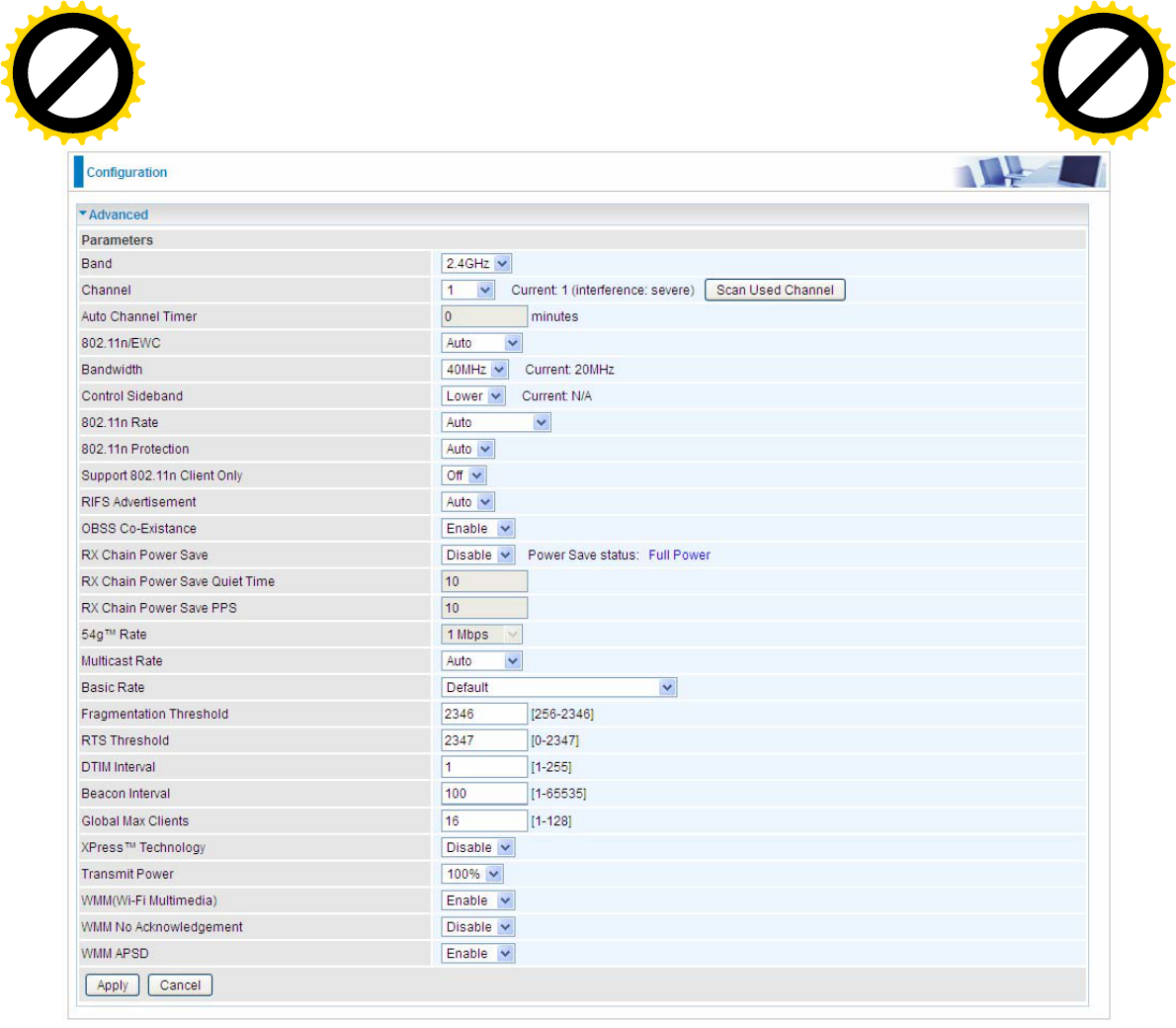
106
Advanced
Here users can set some advanced parameters about wireless.
Band: Select frequency band.
Channel: Allows channel selection of a specific channel (1-7) or Auto mode.
Scan Used Channel: Press the button to scan and list all channels being used.
Auto Channel Timer (min): The auto channel times length it takes to scan in minutes. Only
available for auto channel mode.
802.11n/EWC: select to auto enable or disable 802.11n.
Bandwidth: Select bandwidth. The higher the bandwidth the better the performance will be.
Control Sideband: only available for 40MHz. It allows you to select upper sideband or lower
sideband. Sideband refers to the frequency band either above (upper sideband) or below (lower
sideband) the carrier frequency, within which fall the spectral components produced by modulation
of a carrier wave.
802.11n Rate: This allows you to select the fixed transmission rate or auto.
802.11n Protection: turn off for maximize throughput. Auto for greater security.
Support 802.11n Client Only: turn on the option to only provide wireless access to the clients
operating at 802.11n speeds.
Click to buy NOW!
P
D
F
-
X
C
h
a
n
g
e
V
i
e
w
e
r
w
w
w
.
d
o
c
u
-
t
r
a
c
k
.
c
o
m
Click to buy NOW!
P
D
F
-
X
C
h
a
n
g
e
V
i
e
w
e
r
w
w
w
.
d
o
c
u
-
t
r
a
c
k
.
c
o
m

107
RIFS Advertisement: Reduced Inter-frame Spacing (RIFS) is a 802.11n feature that also improves
performance by reducing the amount of dead time required between OFDM transmissions. Select
Off to disable this function or auto to enable this function.
OBSS Co-Existence: coexistence (or not) between 20 MHZ and 40 MHZ overlapping basic service
sets (OBSS) in wireless local area networks.
RX Chain Power Save: Enabling this feature turns off one of the Receive chains, going from 2x2 to
2x1 to save power.
RX Chain Power Save Quiet Time: The number of seconds the traffic must be below the PPS
value before the Rx Chain Power Save feature activates itself.
RX Chain Power Save PPS: The maximum number of packets per seconds that can be processed
by the WLAN interface for a duration of Quiet Time, described above, before the Rx Chain Power
Save feature activates itself.
Multicast Rate: Setting for multicast packets transmission rate.
Basic Rate: Setting for basic transmission rate. It is not a specific kind of rate, it is a series of rates
supported. When set to Default, the router can transmit with all kinds of standardized rates.
Fragmentation Threshold: A threshold (in bytes) whether the packets will be fragmented and at
what size. Packets succeeding the fragmentation threshold of 802.11n WLAN will be split into
smaller units suitable for circuit size. While the packets smaller than fragmentation threshold will not
be fragmented. Default is 2346, setting the fragmentation too low may result in poor performance.
RTS Threshold: Request to Send (RTS) threshold specifies the packet size, when exceeds the size,
the RTS/CTS will be triggered. The default setting of 2347(max length) will disable the RTS.
DTIM Interval: Delivery Traffic Indication Message (DTIM). The entry range is a value between 1
and 255. A DTIM is countdown variable that informs clients of the next window for listening to
broadcast and multicast messages. When the AP has buffered broadcast or multicast messages for
associated clients, it sends the next DTIM with a DTIM interval value. AP clients hear the beacons
and awaken to receive the broadcast and multicast messages. The default is 1.
Beacon Interval: The amount of time between beacon transmissions in is milliseconds. The default
is 100ms and the acceptable is 1- 65535. The beacon transmissions identify the presence of an
access point.
Global Max Clients: Here you have the option of setting the limit of the number of clients who can
connect to your wireless network.
XPress™ Technology: It has been designed to improve the wireless network efficiency. Default is
disabled.
Regulatory Mode: select to deny any regulatory mode. There are two regulatory modes:
802.11h: The standard solves interference problems with e.g. satellites and radar using the same
band as 802.11a or 802.11n dual-band access points.
802.11d: This standard automatically adjusts its allowed frequencies, power levels and bandwidth
accordingly to the country it's located in.
This means that manufacturers don't need to make country specific products.
Transmit Power: select the transmitting power of your wireless signal.
WMM (Wi-Fi Multimedia): you can choose to enable or disable this function which allows for priority
of certain data over wireless network.
WMM No Acknowledgement: Refers to the acknowledge policy at the MAC level. Enabling WMM
No Acknowledgement can result in more efficient throughput but higher error rates in noisy Radio
Frequency (RF) environment.
WMM APSD: Automatic Power Save Delivery. Enable this to save power.
Click to buy NOW!
P
D
F
-
X
C
h
a
n
g
e
V
i
e
w
e
r
w
w
w
.
d
o
c
u
-
t
r
a
c
k
.
c
o
m
Click to buy NOW!
P
D
F
-
X
C
h
a
n
g
e
V
i
e
w
e
r
w
w
w
.
d
o
c
u
-
t
r
a
c
k
.
c
o
m

108
Station Info
Here you can view information about the wireless clients.
MAC Address: The MAC address of the wireless clients.
Associated: List all the stations that are associated with the Access Point. If a station is idle for too
long, it is removed from this list
Authorized: List those devices with authorized access.
SSID: Show the current SSID of the client.
Interface: To show which interface the wireless client is connected to.
Refresh: To get the latest information.
Click to buy NOW!
P
D
F
-
X
C
h
a
n
g
e
V
i
e
w
e
r
w
w
w
.
d
o
c
u
-
t
r
a
c
k
.
c
o
m
Click to buy NOW!
P
D
F
-
X
C
h
a
n
g
e
V
i
e
w
e
r
w
w
w
.
d
o
c
u
-
t
r
a
c
k
.
c
o
m
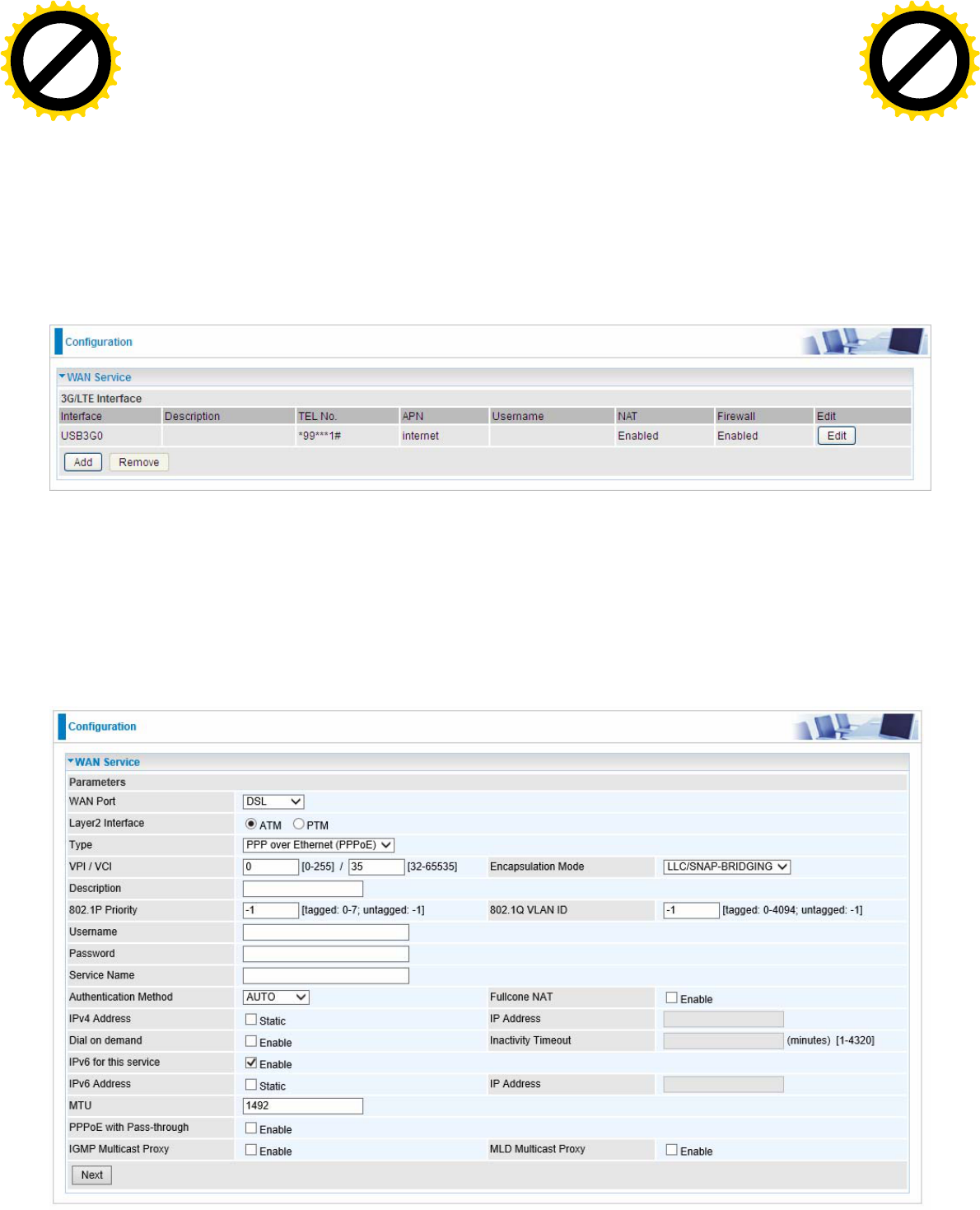
109
WAN-Wide Area Network
A WAN (Wide Area Network) is a computer network that covers a broad geographical area (eg.
Internet) that is used to connect LAN and other types of network systems.
WAN Service
Two WAN interfaces are provided for WAN connection: DSL and Ethernet.
Click Add to add new WAN connections.
DSL
In DSL mode, there are two transfer modes for you to configure for WAN connection, namely ATM
and PTM, configuration of PTM mode is similar as ATM mode, here take ATM mode WAN
configuration for example.
Layer2 Interface: 2 transfer mode, ATM or PTM.
Click to buy NOW!
P
D
F
-
X
C
h
a
n
g
e
V
i
e
w
e
r
w
w
w
.
d
o
c
u
-
t
r
a
c
k
.
c
o
m
Click to buy NOW!
P
D
F
-
X
C
h
a
n
g
e
V
i
e
w
e
r
w
w
w
.
d
o
c
u
-
t
r
a
c
k
.
c
o
m
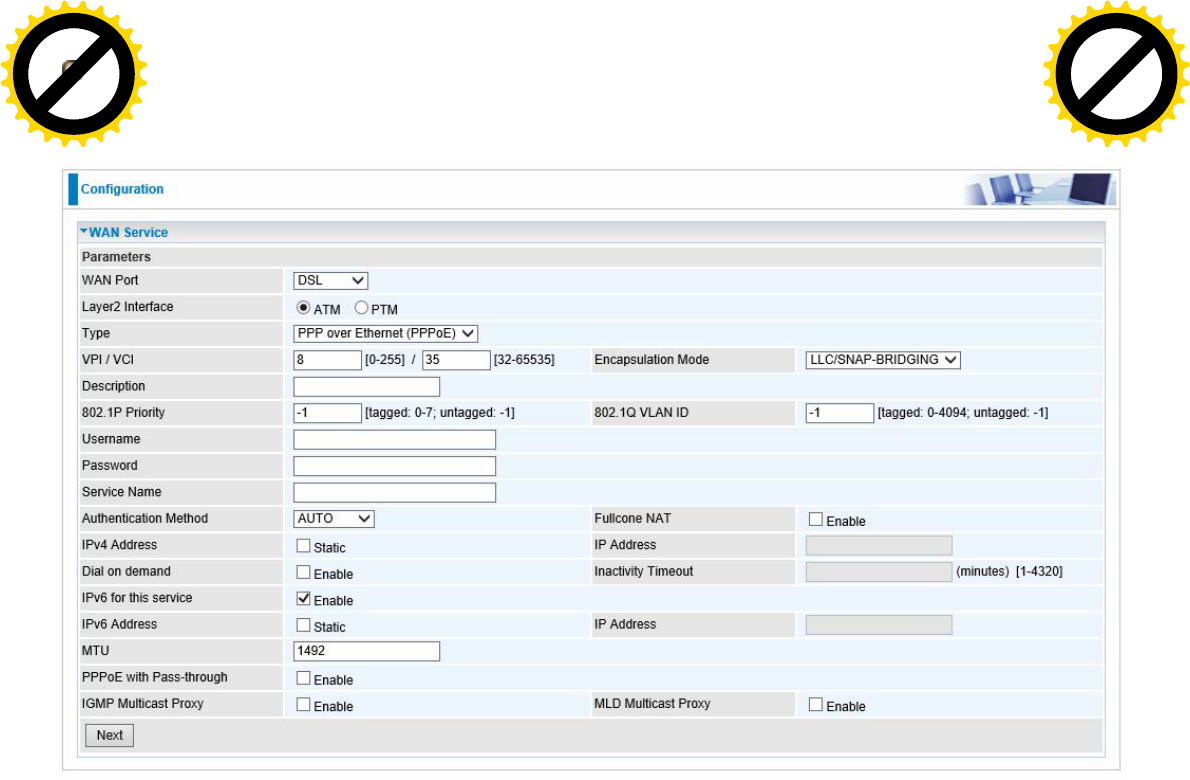
110
PPPoE
PPPoE (PPP over Ethernet) provides access control in a manner which is similar to dial-up services
using PPP.
VCP/VPI: Enter the VCI/VPI combination from you ISP.
Encapsulation Mode: Select the encapsulation mode, LLC/SNAP-BRIDGING, or VC/MUX.
Description: User-defined description for the connection, commonly for friendly use.
802.1P Priority: The parameter indicates the frame priority level from 0 (lowest) to 7 (highest), which
can be used to prioritize different classes of traffic (voice, video, data, etc). Enter the priority
identification, tagged: 0-1, untagged: -1.
802.1Q VLAN ID: It is a parameter to specify the VLAN which the frame belongs. Enter the VLAN ID
identification, tagged: 0-4094, untagged : -1.
Username: Enter the account obtained from the ISP.
Password: Enter the password obtained from the ISP.
Service Name: The item is for identification purpose, user can define it yourselfe.
Authentication Method: Default is Auto. Or else your ISP will advise you the appropriate mode.
Fullcone NAT: Enable or disable fullcone NAT. Fullcone is a kind of NAT, in this mode, all requests
from the same internal IP address and port are mapped to the same external IP address and port.
Furthermore, any external host can send a packet to the internal host by sending a packet to the
mapped external address.
Note: In PPPoE connection, NAT is enabled by default, you can determine whether to enable
Fullcone NAT or disable Fullcone NAT and only use NAT, the default NAT type is Port Restricted
cone NAT. Of Port-Restricted cone NAT, the restriction includes port numbers. Specifically, an
external host can send a packet, with source IP address X and source port P, to the internal host
only if the internal host had previously sent a packet to IP address X and port P
Click to buy NOW!
P
D
F
-
X
C
h
a
n
g
e
V
i
e
w
e
r
w
w
w
.
d
o
c
u
-
t
r
a
c
k
.
c
o
m
Click to buy NOW!
P
D
F
-
X
C
h
a
n
g
e
V
i
e
w
e
r
w
w
w
.
d
o
c
u
-
t
r
a
c
k
.
c
o
m
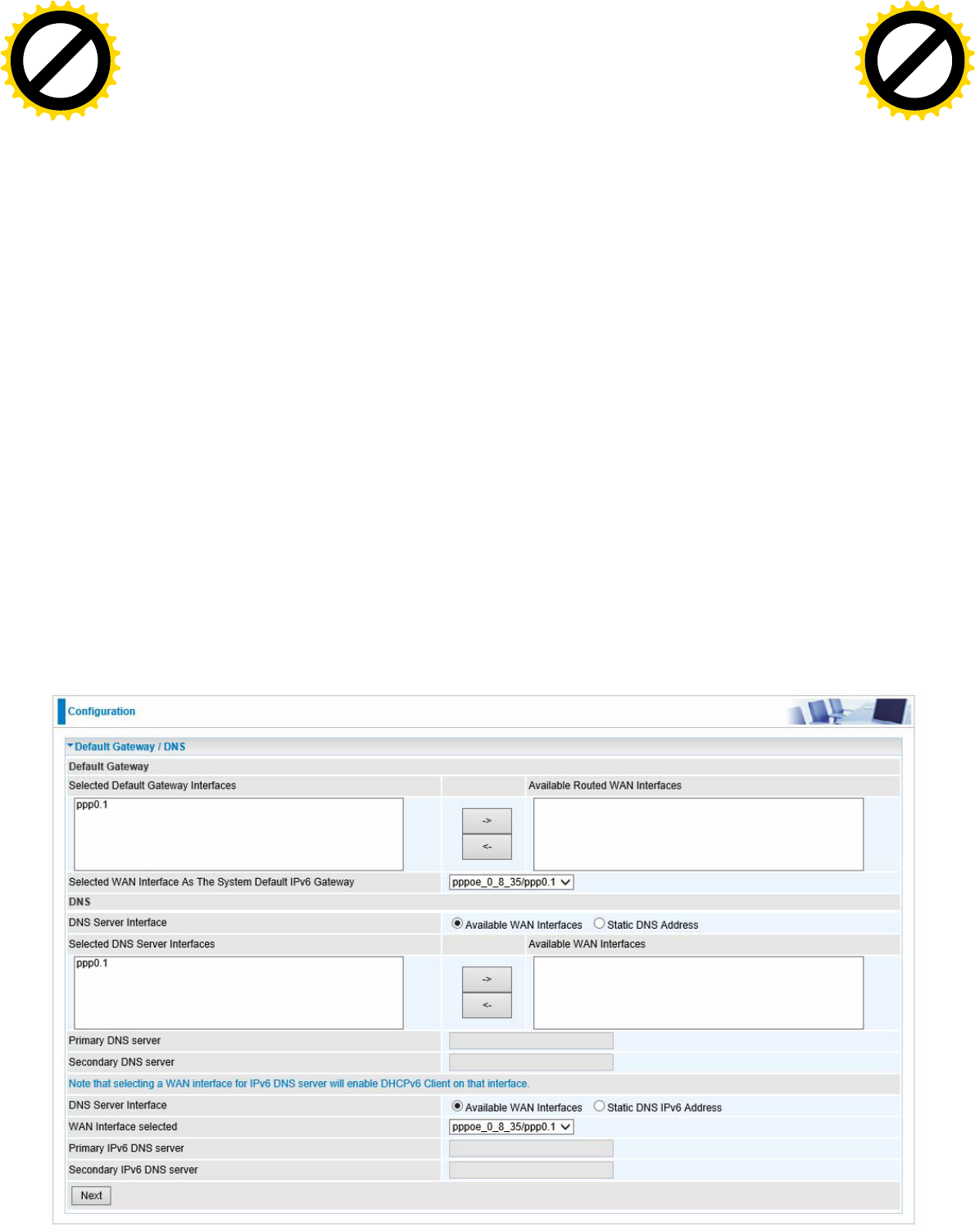
111
IPv4 Address: Select whether to set static IPv4 address or obtain automatically.
IP Address: If Static is enabled in the above field, enter the static IPv4 address get from the ISP.
Dial on demand: It is a parameter to let users to dial for connection to internet themselves. It is
useful when saving internet fees.
Inactivity Timeout: The set Inactivity timeout period, unit: minutes. It is combined use with Dial on
Demand, users should specify the concrete time interval for dial on demand.
IPv6 for this service: Enable to use IPv6 service.
IPv6 Address: Select whether to set static IPv6 address or obtain automatically.
IP Address: If Static is enabled in the above field, enter the static IPv4 address.
MTU: Maximum Transmission Unit, the size of the largest datagram (excluding media-specific
headers) that IP will attempt to send through the interface.
PPPoE with Pass-through: Enable or disable PPPoE pass-through. If it is enabled, PCs behind the
router can dial itself.
IGMP Multicast Proxy: Check whether to enable this feature. IGMP (Internet Group Management
Protocol) Proxy intercepts the IGMP request from Clients and set up the multicast-forwarding table,
it takes over some of the router’s job, simplifying the router’s job and multicast communication.
MLD Multicast Proxy: check whether to enable this function. MLD (Multicast Listener Discovery
Protocol) Proxy intercepts the MLD request from Clients a set up the multicast-forwarding table. it
takes over some of the router’s job, simplifying the router’s job and multicast communication.
Support MLDv1 and MLDv2.
Click Next to continue to set the default gateway and DNS for IPv4 and IPv6.
Click to buy NOW!
P
D
F
-
X
C
h
a
n
g
e
V
i
e
w
e
r
w
w
w
.
d
o
c
u
-
t
r
a
c
k
.
c
o
m
Click to buy NOW!
P
D
F
-
X
C
h
a
n
g
e
V
i
e
w
e
r
w
w
w
.
d
o
c
u
-
t
r
a
c
k
.
c
o
m
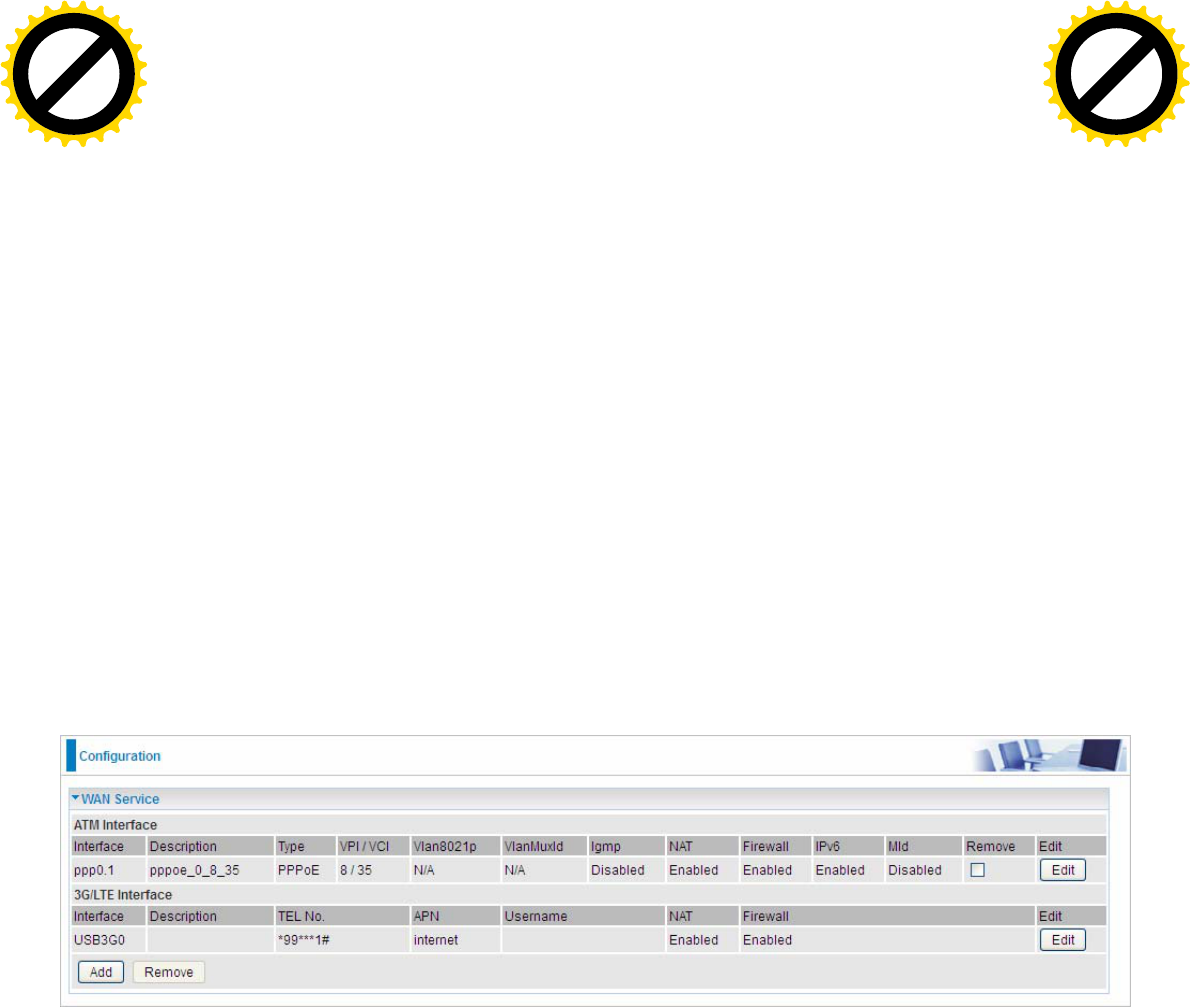
112
Default Gateway
Select default gateway for you connection (IPv4 and IPv6).
DNS
Either IPv4 or IPv6, you can choose static setting or select from available interfaces.
IPv6 DNS Server’s operation is similar to IPv4 DNS server. There are two modes to get DNS server
address: Auto and static mode.
Obtain IPv6 DNS info from a WAN interface
WAN Interface selected: select one configured IPv6 WAN connection from the menu to be as an
IPv6 DNS.
Static DNS IPv6 Address
Primary IPv6 DNS Server / Secondary IPv6 DNS Server: type the specific primary and secondary
IPv6 DNS Server address.
If you don’t need a service, select the item you want to remove, check the checkbox, then press
Remove.
Press Edit button to re-edit this service settings.
Click to buy NOW!
P
D
F
-
X
C
h
a
n
g
e
V
i
e
w
e
r
w
w
w
.
d
o
c
u
-
t
r
a
c
k
.
c
o
m
Click to buy NOW!
P
D
F
-
X
C
h
a
n
g
e
V
i
e
w
e
r
w
w
w
.
d
o
c
u
-
t
r
a
c
k
.
c
o
m
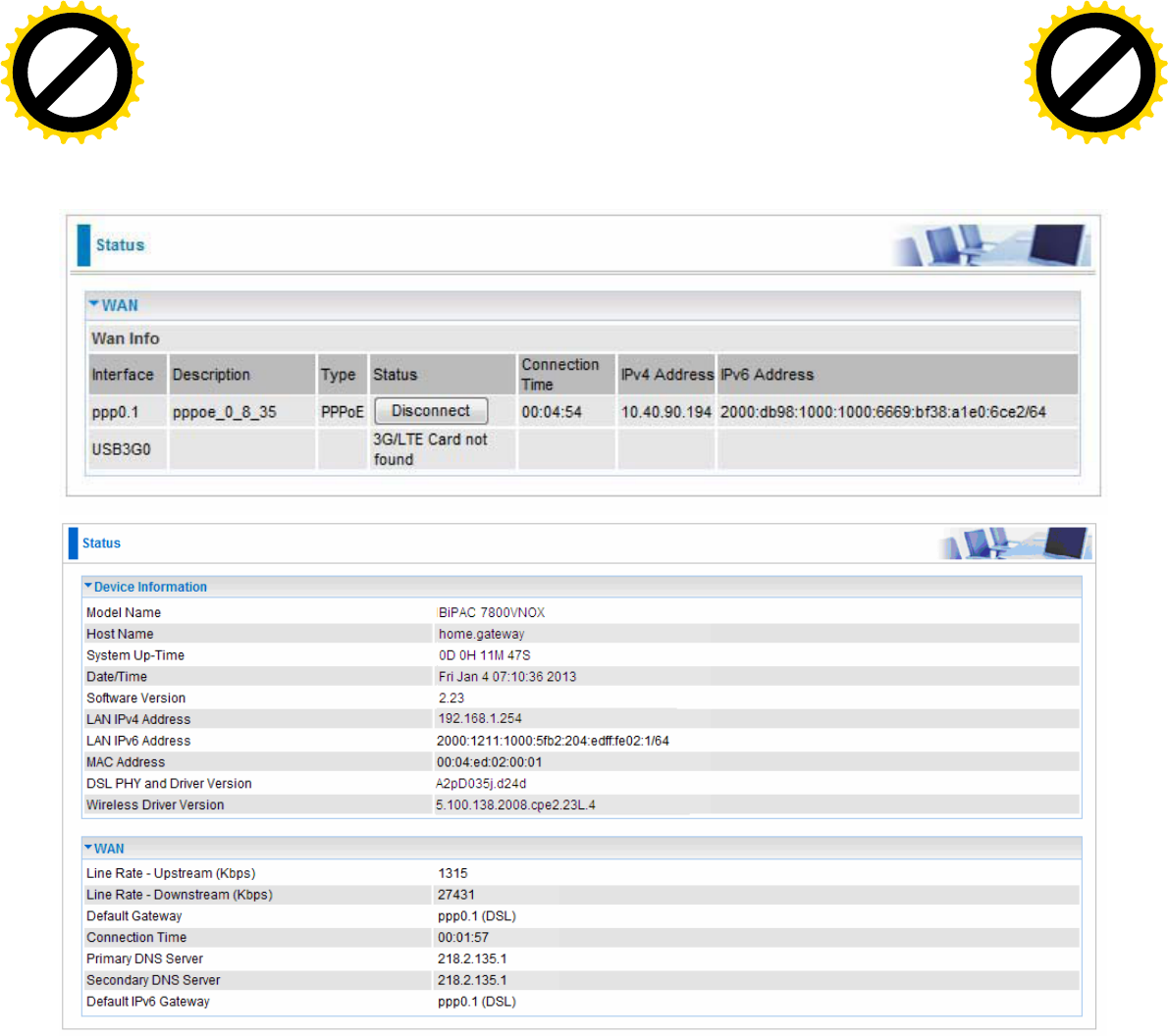
113
Here you can configure WAN Service, if it is OK, you can access the internet. You can go to Status
>WAN or Summary to view the WAN connection information (if your ISP provides IPv6 service, then
you will obtain an IPv6 address).
(IPv4 or IPv6)
Click to buy NOW!
P
D
F
-
X
C
h
a
n
g
e
V
i
e
w
e
r
w
w
w
.
d
o
c
u
-
t
r
a
c
k
.
c
o
m
Click to buy NOW!
P
D
F
-
X
C
h
a
n
g
e
V
i
e
w
e
r
w
w
w
.
d
o
c
u
-
t
r
a
c
k
.
c
o
m
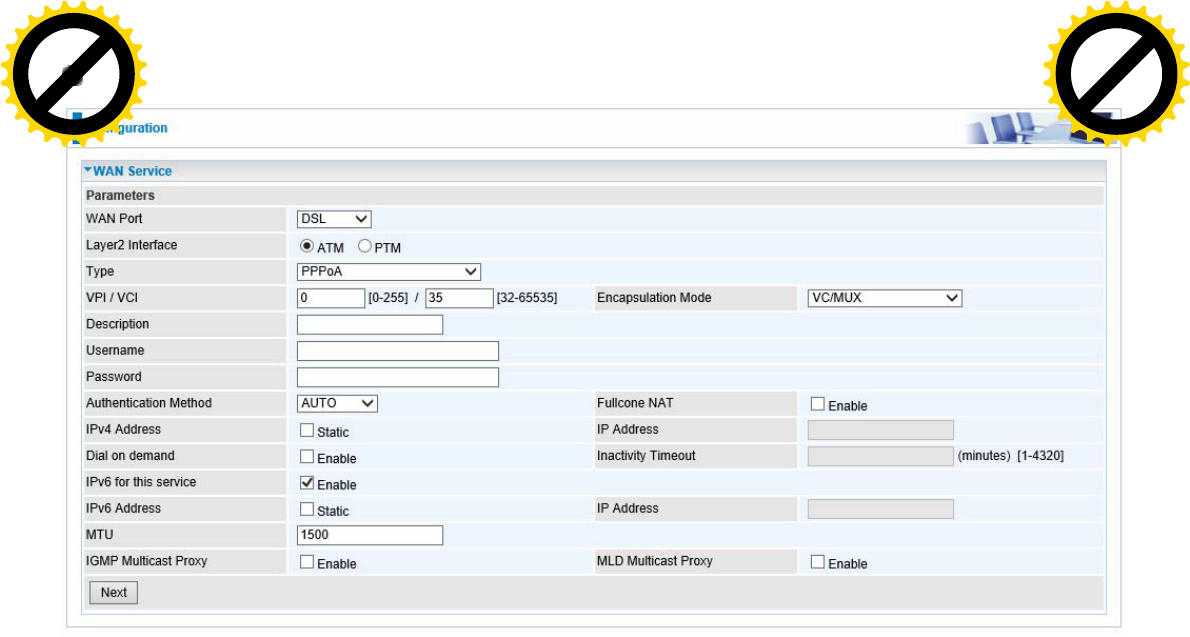
114
PPPoA
VCP/VPI: Enter the VCI/VPI combination from you ISP.
Encapsulation Mode: Select the encapsulation mode, LLC/SNAP-BRIDGING, or VC/MUX.
Description: User-defined description for the connection.
Username: Enter the account obtained from the ISP.
Password: Enter the password obtained from the ISP.
Service Name: The item is for identification purposes, user can define this.
Authentication Method: Default is Auto. Or else your ISP will advise you the appropriate mode.
Fullcone NAT: Enable or disable fullcone NAT. Fullcone is a kind of NAT, in this mode, all requests
from the same internal IP address and port are mapped to the same external IP address and port.
Furthermore, any external host can send a packet to the internal host by sending a packet to the
mapped external address.
Note: In this connection, NAT is enabled by default, you can determine whether to enable Fullcone
NAT or disable Fullcone NAT and only use NAT, the default NAT type is Port Restricted cone NAT.
With Port-Restricted cone NAT, the restriction includes port numbers. Specifically, an external host
can send a packet, with source IP address X and source port P, to the internal host only if the
internal host had previously sent a packet to IP address X and port P
IPv4 Address: Select whether to set static IPv4 address or obtain automatically.
IP Address: If Static is enabled in the above field, enter the static IPv4 address get from the ISP.
Dial on demand: It is a parameter to let users to dial for connection to internet themselves. It is
useful when saving internet fees.
Inactivity Timeout: The set Inactivity timeout period, unit: minutes. It is combined use with Dial on
Demand, users should specify the concrete time interval for dial on demand.
IPv6 for this service: Enable to use IPv6 service.
IPv6 Address: Select whether to set static IPv6 address or obtain automatically.
IP Address: If Static is enabled in the above field, enter the static IPv4 address.
Click to buy NOW!
P
D
F
-
X
C
h
a
n
g
e
V
i
e
w
e
r
w
w
w
.
d
o
c
u
-
t
r
a
c
k
.
c
o
m
Click to buy NOW!
P
D
F
-
X
C
h
a
n
g
e
V
i
e
w
e
r
w
w
w
.
d
o
c
u
-
t
r
a
c
k
.
c
o
m

115
MTU: Maximum Transmission Unit, the size of the largest datagram (excluding media-specific
headers) that IP will attempt to send through the interface.
IGMP Multicast Proxy: Check whether to enable this feature. IGMP (Internet Group Management
Protocol) Proxy intercepts the IGMP request from Clients and set up the multicast-forwarding table,
it takes over some of the router’s job, simplifying the router’s job and multicast communication.
MLD Multicast Proxy: check whether to enable this function. MLD (Multicast Listener Discovery
Protocol) Proxy intercepts the MLD request from Clients a set up the multicast-forwarding table. it
takes over some of the router’s job, simplifying the router’s job and multicast communication.
Support MLDv1 and MLDv2.
Click Next to continue to set the default gateway and DNS for IPv4 and IPv6.
Click to buy NOW!
P
D
F
-
X
C
h
a
n
g
e
V
i
e
w
e
r
w
w
w
.
d
o
c
u
-
t
r
a
c
k
.
c
o
m
Click to buy NOW!
P
D
F
-
X
C
h
a
n
g
e
V
i
e
w
e
r
w
w
w
.
d
o
c
u
-
t
r
a
c
k
.
c
o
m
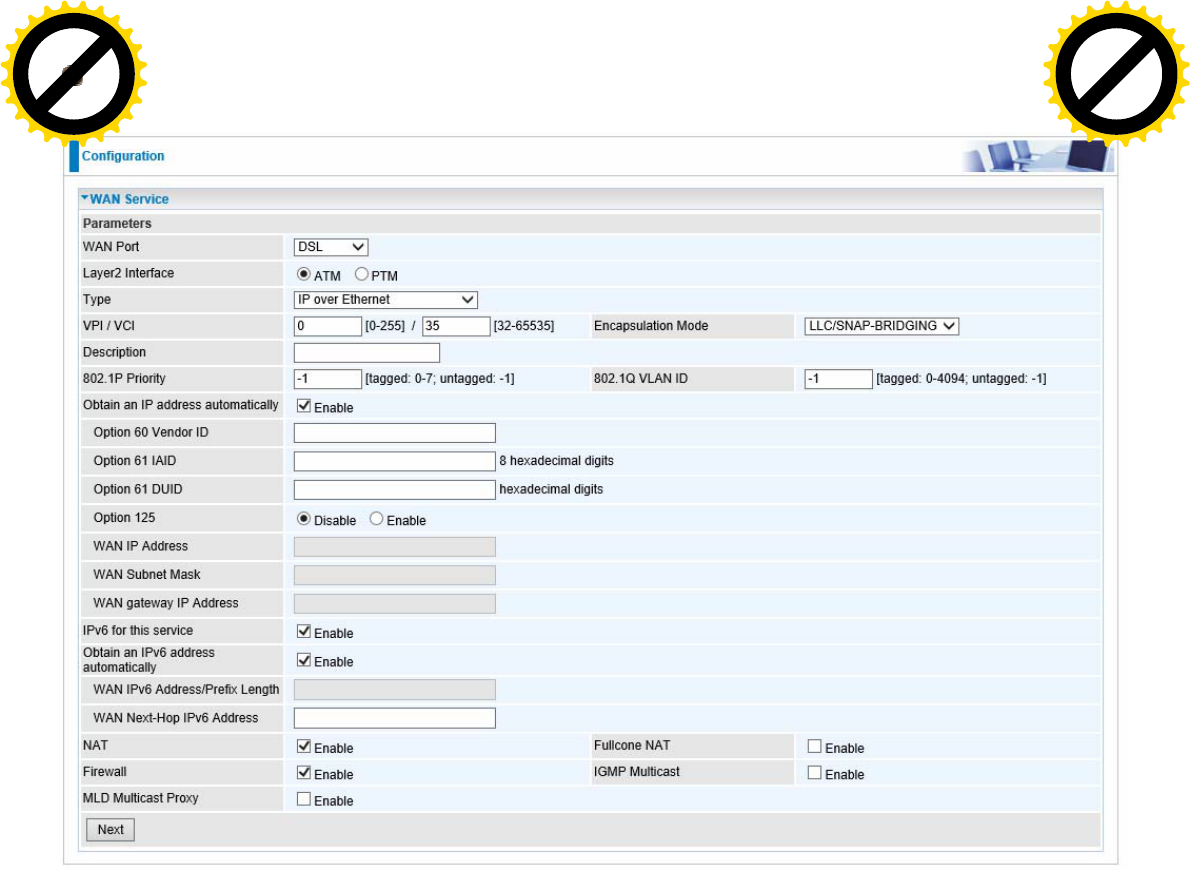
116
IP over Ethernet
VCP/VPI: Enter the VCI/VPI combination from you ISP.
Encapsulation Mode: Select the encapsulation mode, LLC/SNAP-BRIDGING, or VC/MUX.
Description: User-defined description for the connection, commonly for friendly use.
Authentication Method: Default is Auto. Or else your ISP will advise you the appropriate mode.
802.1P Priority: The parameter indicates the frame priority level from 0 (lowest) to 7 (highest), which
can be used to prioritize different classes of traffic (voice, video, data, etc). Enter the priority
identification, tagged: 0-1, untagged: -1.
802.1Q VLAN ID: It is a parameter to specify the VLAN which the frame belongs. Enter the VLAN ID
identification, tagged: 0-4094, untagged : -1.
Here two modes are supported for users to deal with the IP and DNS. You can select obtain
automatically or manually input the information according to your ISP.
Obtain an IP address automatically: Check whether to enable this function.
Option 60 Vendor ID: Enter the associated information by your ISP. This option is used by DHCP
clients to optionally identify the vendor type and configuration of a DHCP client. The information is a
string of n octets, interpreted by servers. Vendors may choose to define specific vendor class
identifiers to convey particular configuration or other identification information about a client.
Option 61 IAID: Enter the associated information provided by your ISP. You should input 8
hexadecimal numbers.
Option 61 DUID: Enter the associated information provided by your ISP. You should input
hexadecimal number(s).
Click to buy NOW!
P
D
F
-
X
C
h
a
n
g
e
V
i
e
w
e
r
w
w
w
.
d
o
c
u
-
t
r
a
c
k
.
c
o
m
Click to buy NOW!
P
D
F
-
X
C
h
a
n
g
e
V
i
e
w
e
r
w
w
w
.
d
o
c
u
-
t
r
a
c
k
.
c
o
m

117
Option 125: Option 125 is a complementary standard of DHCP protocol, it is used to encapsulate
option 125 message into DHCP offer packet before forward it to clients. After the clients receive the
packet, it check the option 125 field in the packet with the prestored message, if it is matched, then
the client accepts this offer, otherwise it will be abandoned. Check Enable or Disable this function.
Default setting is Disable.
WAN IP Address: Enter your IPv4 address to the device provided by your ISP.
WAN Subnet Mask: Enter your submask to the device provided by your ISP.
WAN gateway IP Address: Enter your gateway IP address to the device provided by your ISP.
IPv6 for this service: Enable to use IPv6 service.
Obtain an IPv6 address automatically: check whether to enable or disable this feature.
WAN IPv6 Address/Prefix Length: Enter the WAN IPv6 Address/Prefix Length from your ISP.
WAN Next-Hop IPv6 Address: Enter the WAN Next-Hop IPv6 Address from your ISP.
Note: If you don’t know well about the DHCP Option, you can leave it empty or leave it as default.
NAT: The NAT (Network Address Translation) feature allows multiple users to access the Internet
through a single IP account by sharing the single IP address. If users on your LAN have their own
public IP addresses to access the Internet, NAT function can be disabled. When enabled, a Fullcone
NAT parameter will appear, you can determine whether to enable Fullcone NAT. While only NAT
enabled, the default NAT type Port-Restricted cone NAT will be used.
Fullcone NAT: Enable or disable fullcone NAT. Fullcone is a kind of NAT, in this mode, all requests
from the same internal IP address and port are mapped to the same external IP address and port.
Furthermore, any external host can send a packet to the internal host, by sending a packet to the
mapped external address.
Firewall: Enable to drop all traffic from WAN side. If enabled, all incoming packets by default would
be dropped, and please turn to IP Filtering Incoming to add allowing rules.
IGMP Multicast: IGMP (Internet Group Membership Protocol) is a protocol used by IP hosts to
report their multicast group memberships to any immediately neighboring multicast routers. Check
this item to enable IGMP multicast on that WAN interface for multicast forwarding.
MLD Multicast Proxy: check whether to enable this function. MLD (Multicast Listener Discovery
Protocol) Proxy intercepts the MLD request from Clients a set up the multicast-forwarding table. it
takes over some of the router’s job, simplifying the router’s job and multicast communication.
Support MLDv1 and MLDv2.
Click Next to continue to set the default gateway and DNS for IPv4 and IPv6.
Click to buy NOW!
P
D
F
-
X
C
h
a
n
g
e
V
i
e
w
e
r
w
w
w
.
d
o
c
u
-
t
r
a
c
k
.
c
o
m
Click to buy NOW!
P
D
F
-
X
C
h
a
n
g
e
V
i
e
w
e
r
w
w
w
.
d
o
c
u
-
t
r
a
c
k
.
c
o
m
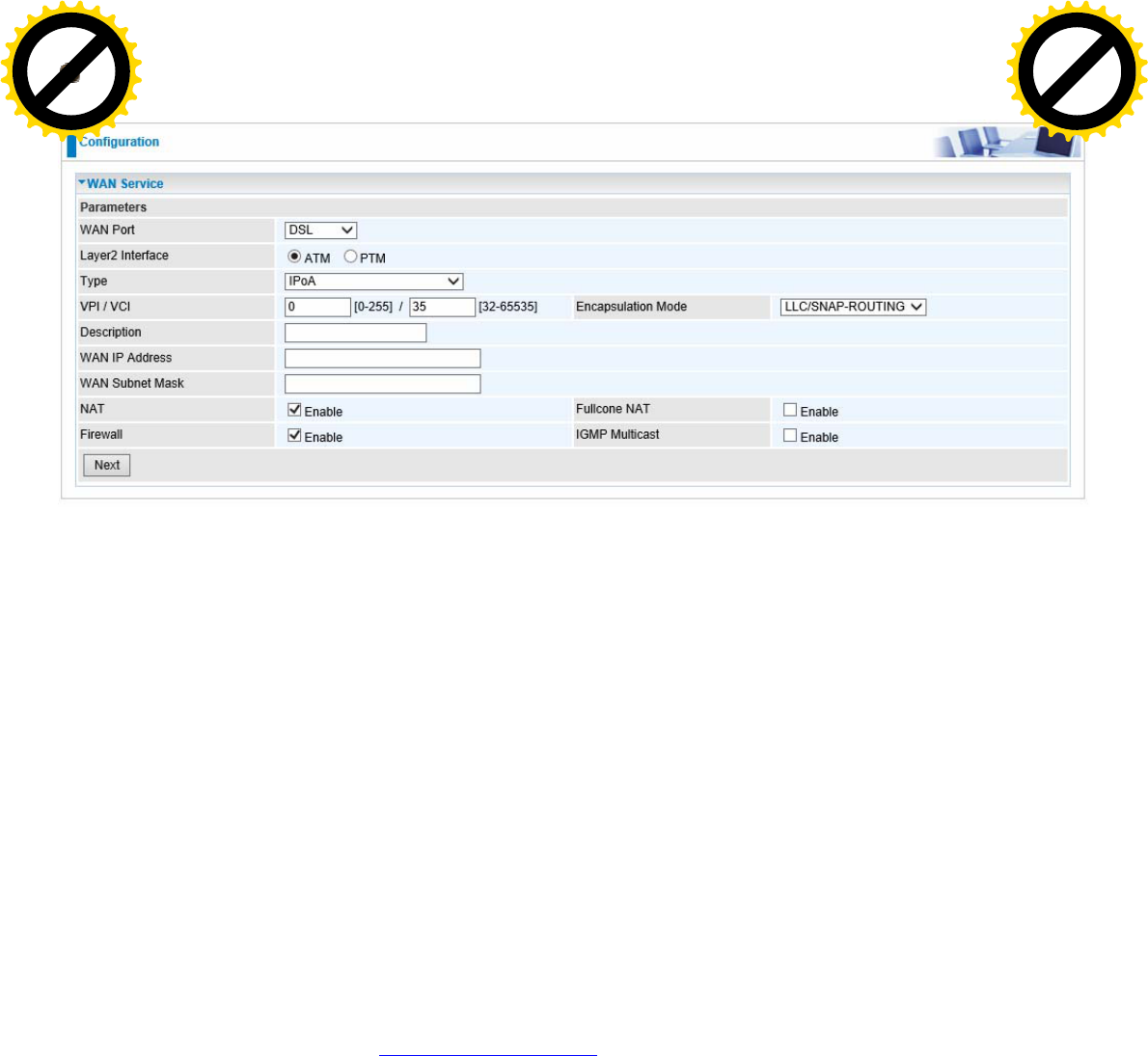
118
IPoA
VCP/VPI: Enter the VCI/VPI combination from you ISP.
Encapsulation Mode: Select the encapsulation mode, LLC/SNAP-BRIDGING, or VC/MUX.
Description: User-defined description for the connection, commonly for friendly use.
WAN IP: Enter the WAN IP from the ISP.
WAN Subnet Mask: Enter the WAN Subnet Mask from the ISP.
NAT: The NAT (Network Address Translation) feature allows multiple users to access the Internet
through a single IP account by sharing the single IP address. If users on your LAN have their own
public IP addresses to access the Internet, NAT function can be disabled. When enabled, a Fullcone
NAT parameter will appear, you can determine whether to enable Fullcone NAT. While only NAT
enabled, the default NAT type Port-Restricted cone NAT will be used.
Fullcone NAT: Enable or disable fullcone NAT. Fullcone is a kind of NAT, in this mode, all requests
from the same internal IP address and port are mapped to the same external IP address and port.
Furthermore, any external host can send a packet to the internal host, by sending a packet to the
mapped external address.
Firewall: Enable to drop all traffic from WAN side. If enabled, all incoming packets by default would
be dropped, and please turn to IP Filtering Incoming to add allowing rules.
IGMP Multicast: IGMP (Internet Group Membership Protocol) is a protocol used by IP hosts to
report their multicast group memberships to any immediately neighboring multicast routers. Check
this item to enable IGMP multicast on that WAN interface for multicast forwarding.
Click to buy NOW!
P
D
F
-
X
C
h
a
n
g
e
V
i
e
w
e
r
w
w
w
.
d
o
c
u
-
t
r
a
c
k
.
c
o
m
Click to buy NOW!
P
D
F
-
X
C
h
a
n
g
e
V
i
e
w
e
r
w
w
w
.
d
o
c
u
-
t
r
a
c
k
.
c
o
m
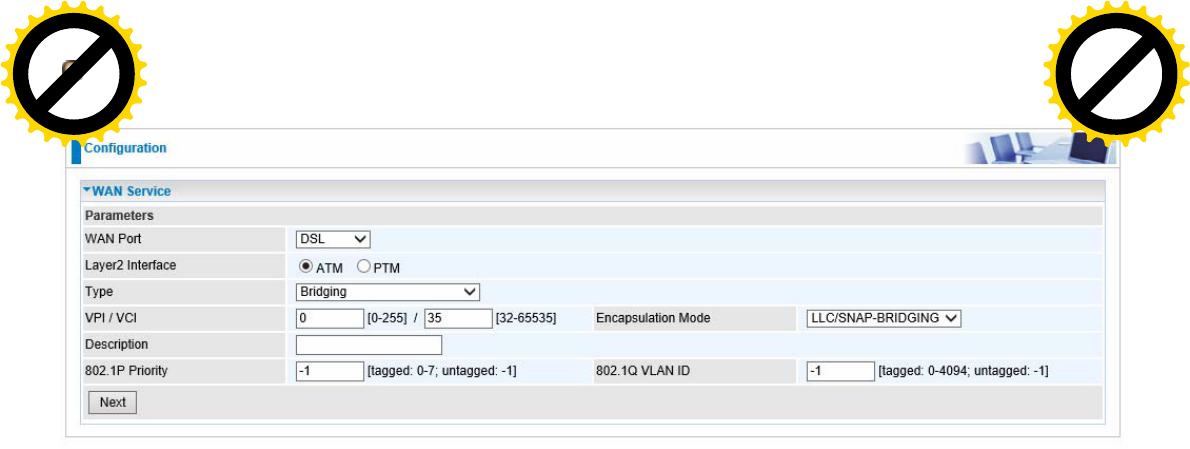
119
Bridging
VCP/VPI: Enter the VCI/VPI combination from you ISP.
Encapsulation Mode: Select the encapsulation mode, LLC/SNAP-BRIDGING, or VC/MUX.
Description: User-defined description for the connection, commonly for friendly use.
802.1P Priority: The parameter indicates the frame priority level from 0 (lowest) to 7 (highest), which
can be used to prioritize different classes of traffic (voice, video, data, etc). Enter the priority
identification, tagged: 0-1, untagged: -1.
802.1Q VLAN ID: It is a parameter to specify the VLAN which the frame belongs. Enter the VLAN ID
identification, tagged: 0-4094, untagged : -1.
Click to buy NOW!
P
D
F
-
X
C
h
a
n
g
e
V
i
e
w
e
r
w
w
w
.
d
o
c
u
-
t
r
a
c
k
.
c
o
m
Click to buy NOW!
P
D
F
-
X
C
h
a
n
g
e
V
i
e
w
e
r
w
w
w
.
d
o
c
u
-
t
r
a
c
k
.
c
o
m
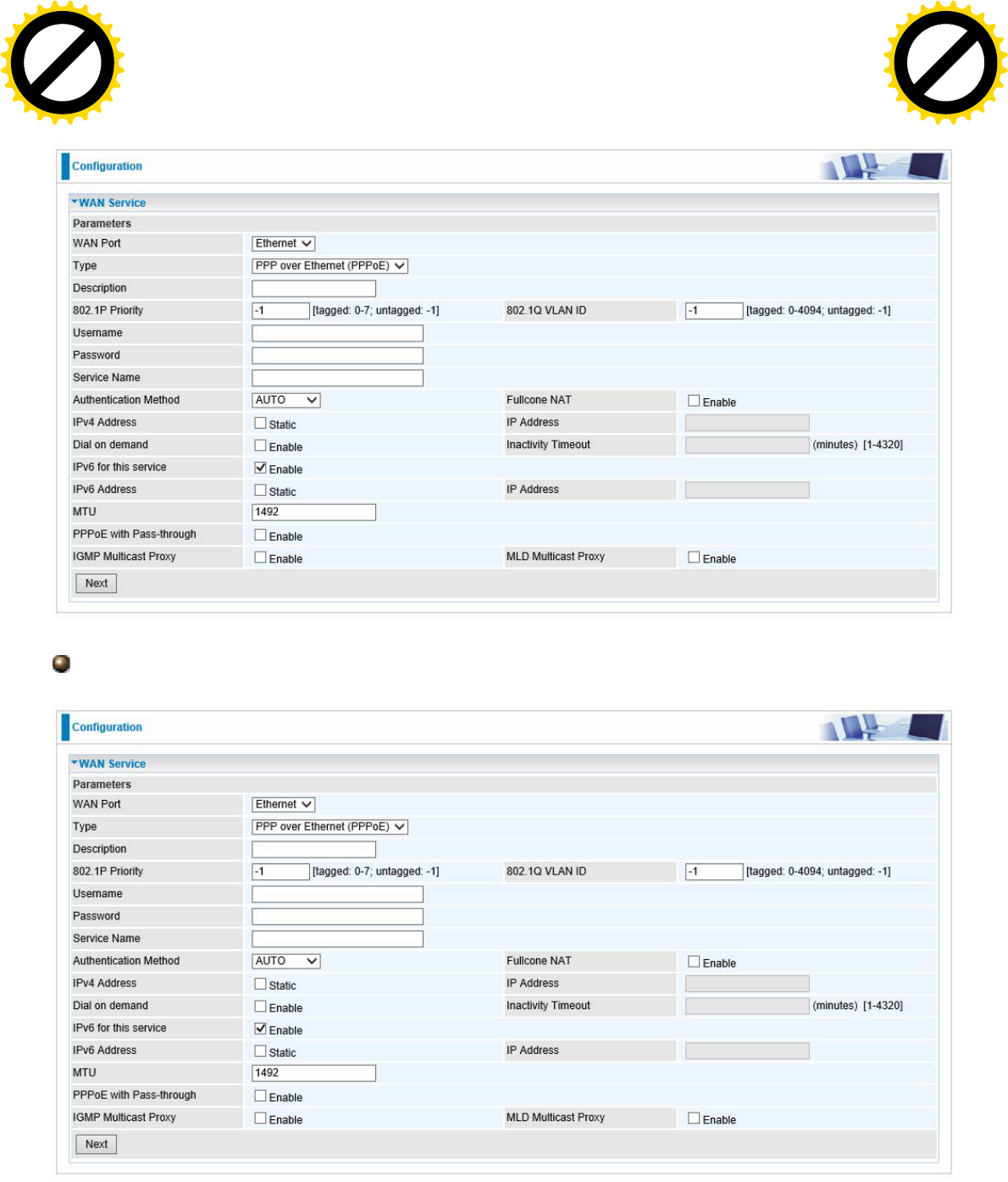
120
Ethernet
Ethernet WAN connection is well known as directly broadband WAN connection.
PPPoE
Description: User-defined description for the connection, commonly for friendly use.
802.1P Priority: The parameter indicates the frame priority level from 0 (lowest) to 7 (highest), which
can be used to prioritize different classes of traffic (voice, video, data, etc). Enter the priority
identification, tagged: 0-1, untagged: -1.
802.1Q VLAN ID: It is a parameter to specify the VLAN which the frame belongs. Enter the VLAN ID
identification, tagged: 0-4094, untagged : -1.
Click to buy NOW!
P
D
F
-
X
C
h
a
n
g
e
V
i
e
w
e
r
w
w
w
.
d
o
c
u
-
t
r
a
c
k
.
c
o
m
Click to buy NOW!
P
D
F
-
X
C
h
a
n
g
e
V
i
e
w
e
r
w
w
w
.
d
o
c
u
-
t
r
a
c
k
.
c
o
m

121
Username: Enter the account obtained from the ISP.
Password: Enter the password obtained from the ISP.
Service Name: The item is for identification purpose, user can define it yourselfe.
Authentication Method: Default is Auto. Or else your ISP will advise you the appropriate mode.
Fullcone NAT: Enable or disable fullcone NAT. Fullcone is a kind of NAT, in this mode, all requests
from the same internal IP address and port are mapped to the same external IP address and port.
Furthermore, any external host can send a packet to the internal host by sending a packet to the
mapped external address.
Note: In PPPoE connection, NAT is enabled by default, you can determine whether to enable
Fullcone NAT. and while you disable Fullcone NAT and only use NAT, the default NAT type is Port
Restricted or Port-Restricted cone NAT, the restriction includes port numbers. Specifically, an
external host can send a packet, with source IP address X and source port P, to the internal host
only if the internal host had previously sent a packet to IP address X and port P
IPv4 Address: Select whether to set static IPv4 address or obtain automatically.
IP Address: If Static is enabled in the above field, enter the static IPv4 address get from the ISP.
Dial on demand: It is a parameter to let users to dial for connection to internet themselves. It is
useful when saving internet fees.
Inactivity Timeout: The set Inactivity timeout period, unit: minutes. It is combined use with Dial on
Demand, users should specify the concrete time interval for dial on demand.
IPv6 for this service: Enable to use IPv6 service.
IPv6 Address: Select whether to set static IPv6 address or obtain automatically.
IP Address: If Static is enabled in the above field, enter the static IPv4 address.
MTU: Maximum Transmission Unit, the size of the largest datagram (excluding media-specific
headers) that IP will attempt to send through the interface.
PPPoE with Pass-through: Enable or disable PPPoE pass-through. If it is enabled, PCs behind the
router can dial itself.
IGMP Multicast Proxy: Check whether to enable this feature. IGMP (Internet Group Management
Protocol) Proxy intercepts the IGMP request from Clients and set up the multicast-forwarding table,
it takes over some of the router’s job, simplifying the router’s job and multicast communication.
MLD Multicast Proxy: check whether to enable this function. MLD (Multicast Listener Discovery
Protocol) Proxy intercepts the MLD request from Clients a set up the multicast-forwarding table. it
takes over some of the router’s job, simplifying the router’s job and multicast communication.
Support MLDv1 and MLDv2.
Click to buy NOW!
P
D
F
-
X
C
h
a
n
g
e
V
i
e
w
e
r
w
w
w
.
d
o
c
u
-
t
r
a
c
k
.
c
o
m
Click to buy NOW!
P
D
F
-
X
C
h
a
n
g
e
V
i
e
w
e
r
w
w
w
.
d
o
c
u
-
t
r
a
c
k
.
c
o
m
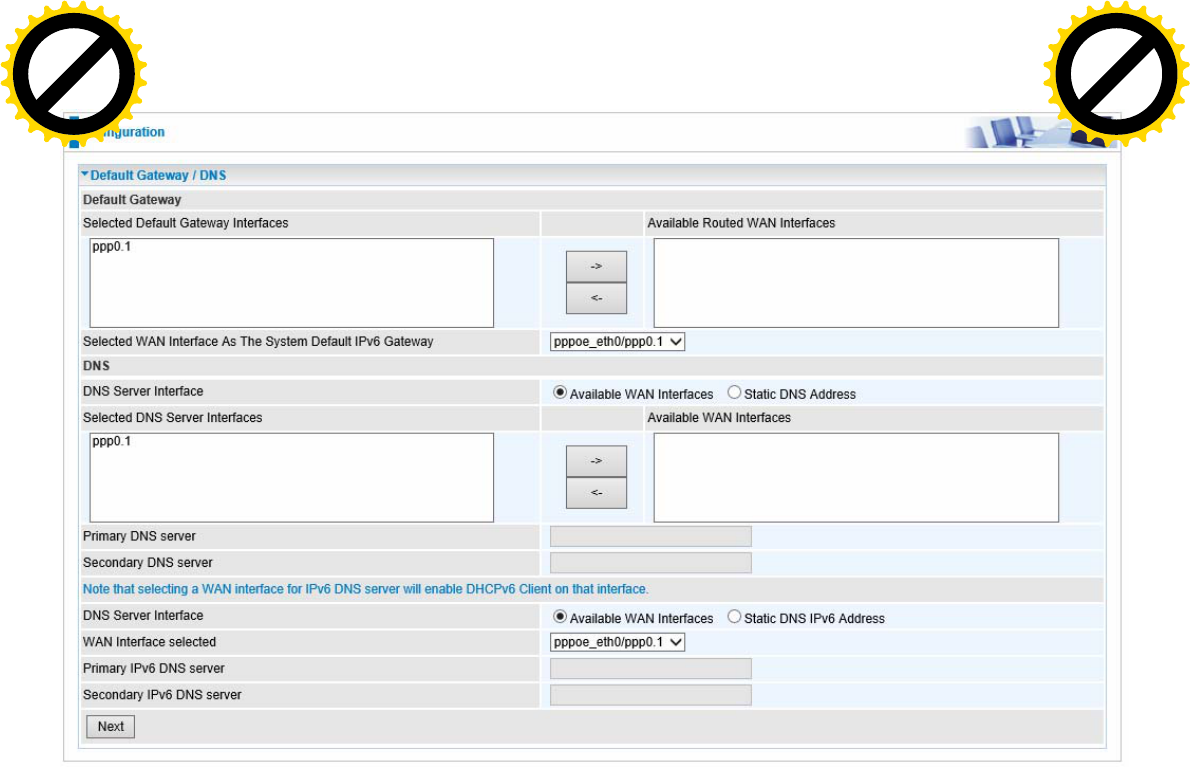
122
Click Next to continue to set the default gateway and DNS for IPv4 and IPv6.
Default Gateway
Select a default gateway for you connection (IPv4 and IPv6).
DNS
Either IPv4 or IPv6, you can choose a static setting or select from available interfaces.
IPv6 DNS Server’s operation is similar to IPv4 DNS server. There are two modes to get DNS server
address: Auto and static mode.
Obtain IPv6 DNS info from a WAN interface
WAN Interface selected: Select one configured IPv6 WAN connection from the menu to be as an
IPv6 DNS.
Static DNS IPv6 Address
Primary IPv6 DNS Server / Secondary IPv6 DNS Server: Type the specific primary and secondary
IPv6 DNS Server address.
Click to buy NOW!
P
D
F
-
X
C
h
a
n
g
e
V
i
e
w
e
r
w
w
w
.
d
o
c
u
-
t
r
a
c
k
.
c
o
m
Click to buy NOW!
P
D
F
-
X
C
h
a
n
g
e
V
i
e
w
e
r
w
w
w
.
d
o
c
u
-
t
r
a
c
k
.
c
o
m
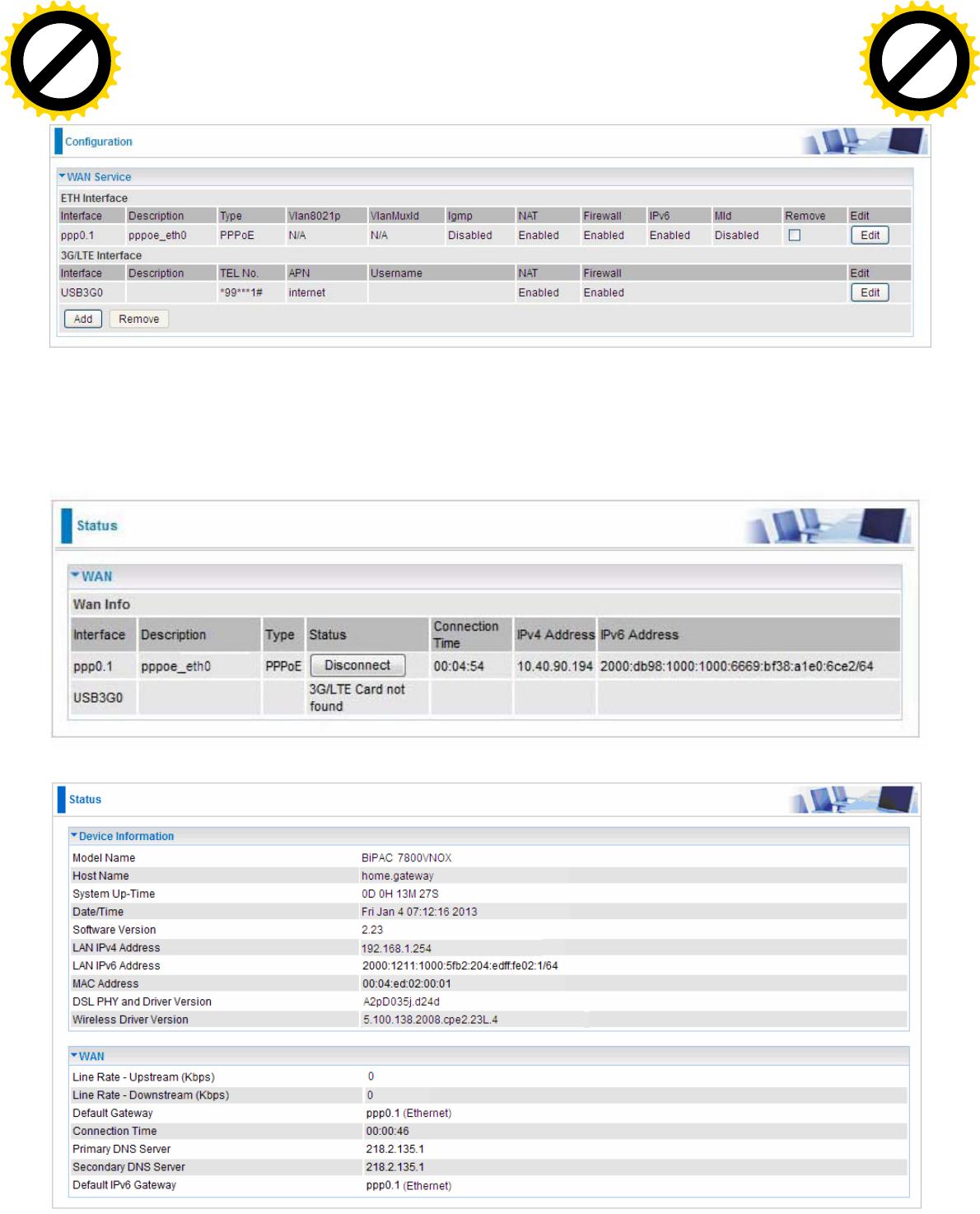
123
If you don’t need the service, select the item you want to remove, check the checkbox, then press
Remove, it will be OK.
Press Edit button to re-edit this service settings.
Here the corresponding WAN Service have been configured, if it is OK, you can access the internet.
You can go to Status>WAN or Summary to view the WAN connection information (if your ISP
provides IPv6 service, then you will obtain an IPv6 address).
(IPv4 or IPv6)
The device summary information
Click to buy NOW!
P
D
F
-
X
C
h
a
n
g
e
V
i
e
w
e
r
w
w
w
.
d
o
c
u
-
t
r
a
c
k
.
c
o
m
Click to buy NOW!
P
D
F
-
X
C
h
a
n
g
e
V
i
e
w
e
r
w
w
w
.
d
o
c
u
-
t
r
a
c
k
.
c
o
m
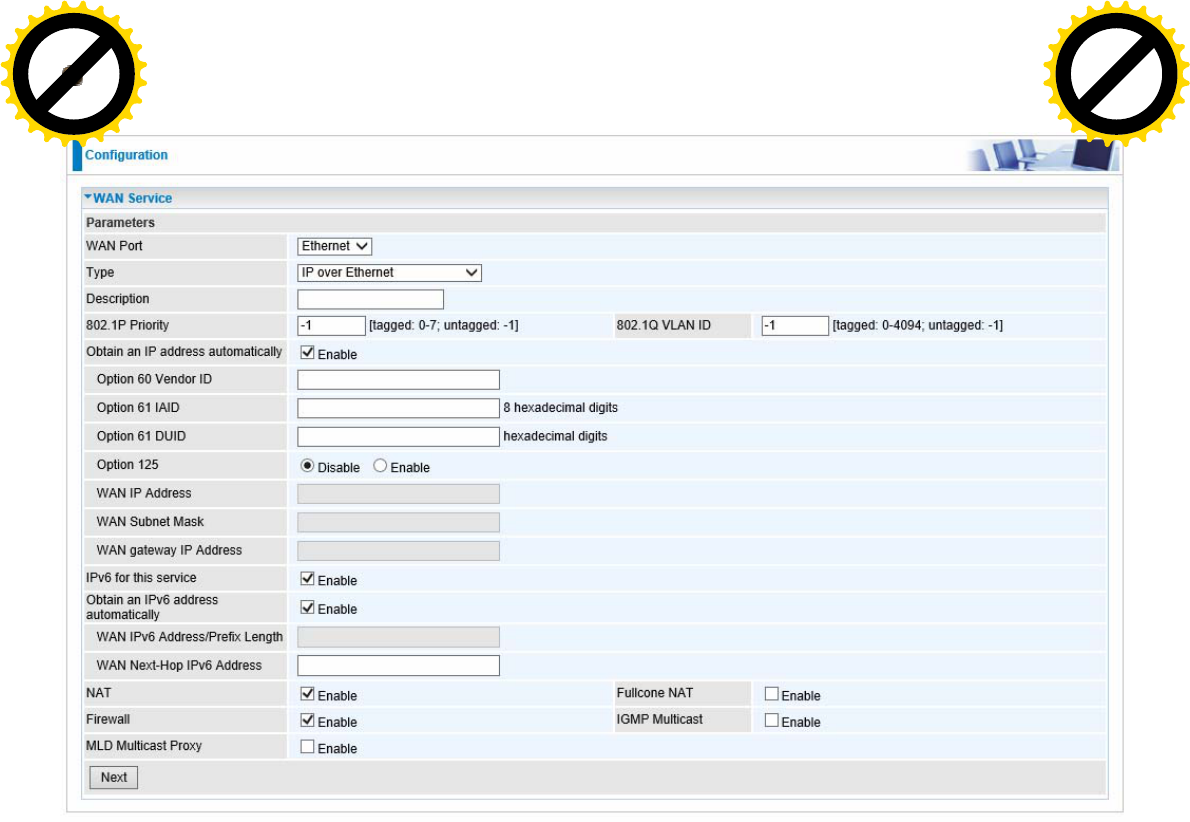
124
IP over Ethernet
Description: User-defined description for the connection, commonly for friendly use.
802.1P Priority: The parameter indicates the frame priority level from 0 (lowest) to 7 (highest), which
can be used to prioritize different classes of traffic (voice, video, data, etc). Enter the priority
identification, tagged: 0-1, untagged: -1.
802.1Q VLAN ID: It is a parameter to specify the VLAN which the frame belongs. Enter the VLAN ID
identification, tagged: 0-4094, untagged : -1.
Here two modes are supported for users to deal with the IP and DNS. You can select obtain
automatically or manually input the information according to your ISP.
Obtain an IP address automatically: Check whether to enable this function.
Option 60 Vendor ID: Enter the associated information by your ISP. This option is used by DHCP
clients to optionally identify the vendor type and configuration of a DHCP client. The information is a
string of n octets, interpreted by servers. Vendors may choose to define specific vendor class
identifiers to convey particular configuration or other identification information about a client.
Option 61 IAID: Enter the associated information provided by your ISP. You should input 8
hexadecimal numbers.
Option 61 DUID: Enter the associated information provided by your ISP. You should input
hexadecimal number(s).
Option 125: Option 125 is a complementary standard of DHCP protocol, it is used to encapsulate
option 125 message into DHCP offer packet before forward it to clients. After the clients receive the
packet, it check the option 125 field in the packet with the pre-stored message, if it is matched, then
the client accepts this offer, otherwise it will be abandoned. Check Enable or Disable this function.
Default setting is Disable.
Click to buy NOW!
P
D
F
-
X
C
h
a
n
g
e
V
i
e
w
e
r
w
w
w
.
d
o
c
u
-
t
r
a
c
k
.
c
o
m
Click to buy NOW!
P
D
F
-
X
C
h
a
n
g
e
V
i
e
w
e
r
w
w
w
.
d
o
c
u
-
t
r
a
c
k
.
c
o
m

125
WAN IP Address: Enter your IPv4 address to the device provided by your ISP.
WAN Subnet Mask: Enter your submask to the device provided by your ISP.
WAN gateway IP Address: Enter your gateway IP address to the device provided by your ISP.
IPv6 for this service: Enable to use IPv6 service.
Obtain an IPv6 address automatically: check whether to enable or disable this feature.
WAN IPv6 Address/Prefix Length: Enter the WAN IPv6 Address/Prefix Length from your ISP.
WAN Next-Hop IPv6 Address: Enter the WAN Next-Hop IPv6 Address from your ISP.
Note: If you don’t know well about the DHCP Option, you can leave it empty or leave it as default.
NAT: The NAT (Network Address Translation) feature allows multiple users to access the Internet
through a single IP account by sharing the single IP address. If users on your LAN have their own
public IP addresses to access the Internet, NAT function can be disabled. When enabled, a Fullcone
NAT parameter will appear, you can determine whether to enable Fullcone NAT. While only NAT
enabled, the default NAT type Port-Restricted cone NAT will be used.
Fullcone NAT: Enable or disable fullcone NAT. Fullcone is a kind of NAT, in this mode, all requests
from the same internal IP address and port are mapped to the same external IP address and port.
Furthermore, any external host can send a packet to the internal host, by sending a packet to the
mapped external address.
Firewall: Enable to drop all traffic from WAN side. If enabled, all incoming packets by default would
be dropped, and please turn to IP Filtering Incoming to add allowing rules.
IGMP Multicast: IGMP (Internet Group Membership Protocol) is a protocol used by IP hosts to
report their multicast group memberships to any immediately neighboring multicast routers. Check
this item to enable IGMP multicast on that WAN interface for multicast forwarding.
MLD Multicast Proxy: check whether to enable this function. MLD (Multicast Listener Discovery
Protocol) Proxy intercepts the MLD request from Clients a set up the multicast-forwarding table. it
takes over some of the router’s job, simplifying the router’s job and multicast communication.
Support MLDv1 and MLDv2.
Click to buy NOW!
P
D
F
-
X
C
h
a
n
g
e
V
i
e
w
e
r
w
w
w
.
d
o
c
u
-
t
r
a
c
k
.
c
o
m
Click to buy NOW!
P
D
F
-
X
C
h
a
n
g
e
V
i
e
w
e
r
w
w
w
.
d
o
c
u
-
t
r
a
c
k
.
c
o
m

126
Bridging
Description: User-defined description for the connection, commonly for friendly use.
802.1P Priority: The parameter indicates the frame priority level from 0 (lowest) to 7 (highest), which
can be used to prioritize different classes of traffic (voice, video, data, etc). Enter the priority
identification, tagged: 0-1, untagged: -1.
802.1Q VLAN ID: It is a parameter to specify the VLAN which the frame belongs. Enter the VLAN ID
identification, tagged: 0-4094, untagged : -1.
Click to buy NOW!
P
D
F
-
X
C
h
a
n
g
e
V
i
e
w
e
r
w
w
w
.
d
o
c
u
-
t
r
a
c
k
.
c
o
m
Click to buy NOW!
P
D
F
-
X
C
h
a
n
g
e
V
i
e
w
e
r
w
w
w
.
d
o
c
u
-
t
r
a
c
k
.
c
o
m
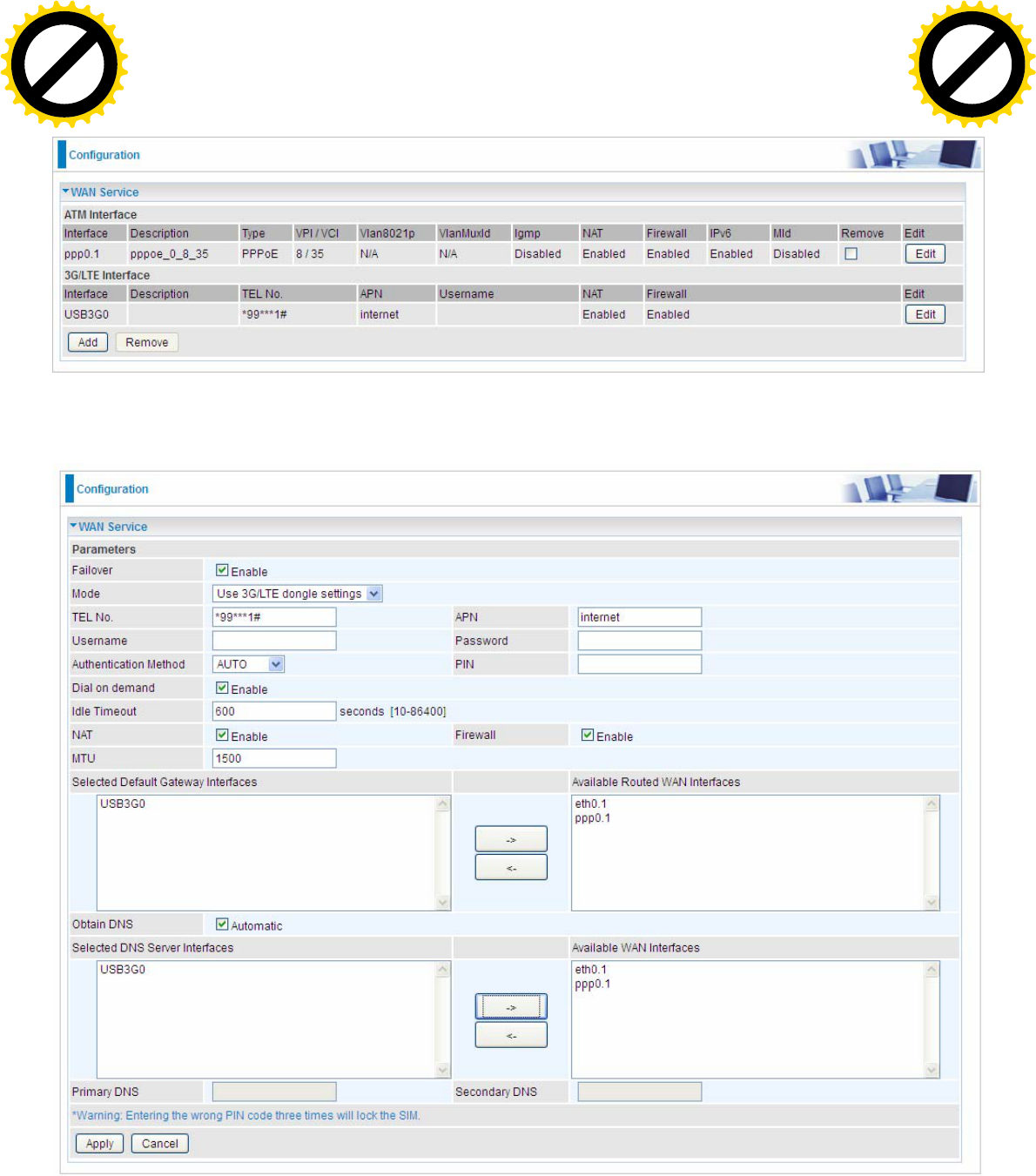
127
3G/LTE
Select 3G/LTE to configure the route to enjoy the mobility. By default the 3G/LTE interface is on,
user can edit the parameters to meet your own requirements.
Click Edit button to enter the 3G/LTE configuration page.
Failover: If enabled, the 3G/LTE will work in failover mode and be brought up only when there is no
active default route. In this mode, 3G/LTE work as a backup for the WAN connectivity. While if
disabled, 3G/LTE serves as a normal interface, and can only be brought up when it has been
configured to achieve a mobile connectivity.
Mode: There are 6 options of phone service standards: GSM 2G only, UTMS 3G only, GSM 2G
preferred, UMTS 3G preferred, Automatic, and Use 3G/LTE 3g dongle settings. If you are uncertain
what services are available to you, and then please select Automatic.
TEL No.: The dial string to make a 3G/LTE user internetworking call. It may provide by your mobile
Click to buy NOW!
P
D
F
-
X
C
h
a
n
g
e
V
i
e
w
e
r
w
w
w
.
d
o
c
u
-
t
r
a
c
k
.
c
o
m
Click to buy NOW!
P
D
F
-
X
C
h
a
n
g
e
V
i
e
w
e
r
w
w
w
.
d
o
c
u
-
t
r
a
c
k
.
c
o
m
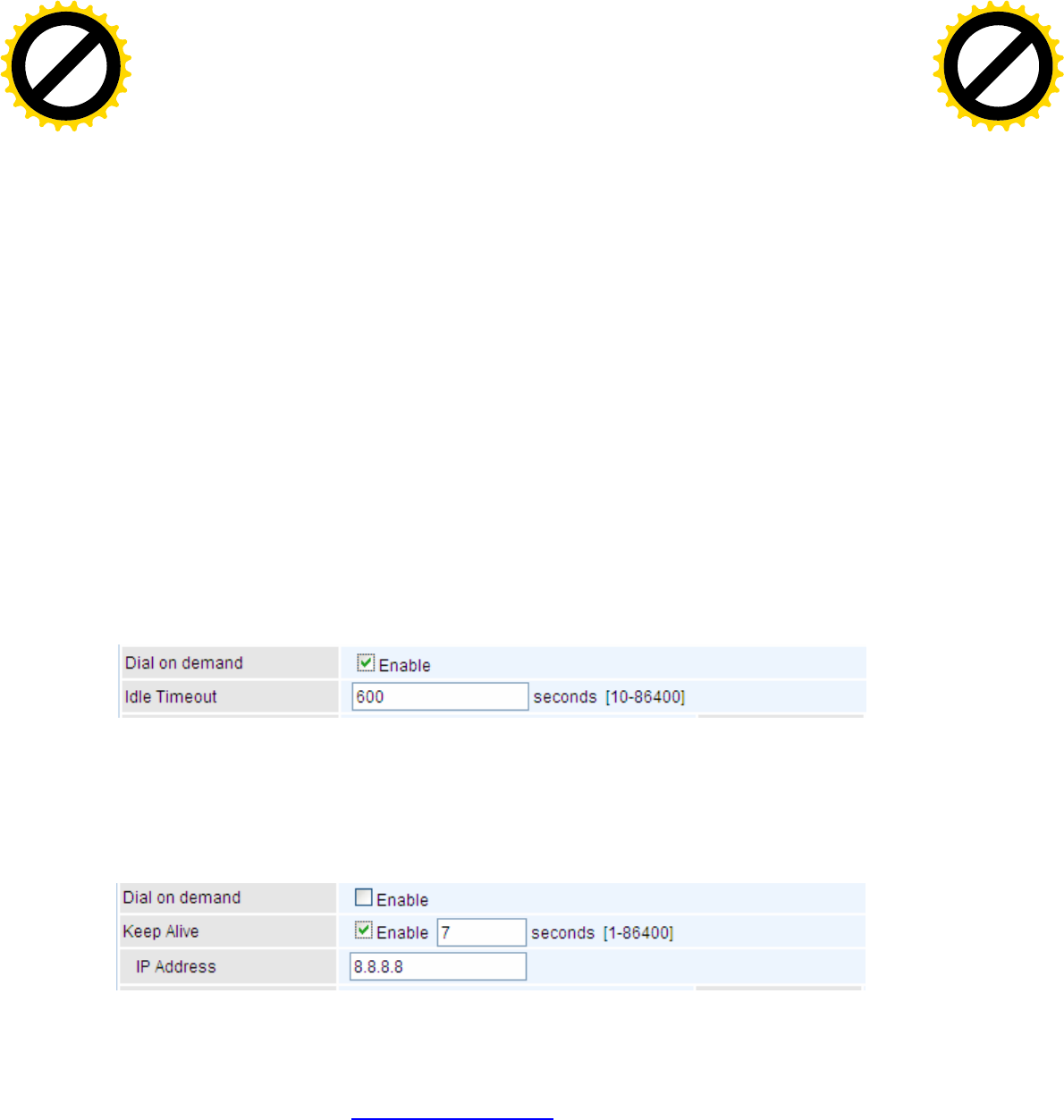
128
service provider.
APN: An APN is similar to a URL on the WWW, it is what the unit makes a GPRS / UMTS call. The
service provider is able to attach anything to an APN to create a data connection, requirements for
APNs varies between different service providers. Most service providers have an internet portal
which they use to connect to a DHCP Server, thus giving you access to the internet i.e. some 3G
operators use the APN ‘internet’ for their portal. The default value is “internet”.
Username/Password: Enter the username and password provided by your service provider. The
username and password are case sensitive.
Authentication Protocol: Default is Auto. Please consult your service provider on whether to use
PAP, CHAP or MSCHAP.
PIN: PIN stands for Personal Identification Number. A PIN code is a numeric value used in certain
systems as a password to gain access, and authenticate. In mobile phones a PIN code locks the
SIM card until you enter the correct code. If you enter the PIN code incorrectly into the phone 3 times
in a row, then the SIM card will be blocked and you will require a PUK code from your network/
service provider.
Connect on Demand: If you want to make UMTS/GPRS call only when there is a packet
requesting access to the Internet (i.e. when a program on your computer attempts to access
the Internet). In this mode, you must set Idle Timeout value at same time. Click on Connect on
Demand, the Idle Timeout field will display.
Idle Timeout: Auto-disconnect the broadband firewall gateway when there is no activity on
the line for a predetermined period of time. Default is 600 seconds.
Keep Alive: Check Enable to allow the router to send message out every 7 seconds (can be
changed base on need) to prevent the connection being dropped by ISP.
IP Address: The IP address is used to “ping”, and router will ping the IP to find whether the
connection is still on.
NAT: Check to enable the NAT function.
Firewall: Enable to drop all traffic from WAN side. If enabled, all incoming packets by default would
be dropped, and please turn to IP Filtering Incoming to add allowing rules.
MTU: MTU (Maximum Transmission Unit) is the size of the largest datagram that IP will attempt to
send through the interface.
Select default gateway interfaces: Select from the interfaces the default gateway, here commonly
we select ppp3g0.
Selected DNS Server Interfaces: Select the IP addresses of the DNS servers.
Click Apply to confirm the settings.
Click to buy NOW!
P
D
F
-
X
C
h
a
n
g
e
V
i
e
w
e
r
w
w
w
.
d
o
c
u
-
t
r
a
c
k
.
c
o
m
Click to buy NOW!
P
D
F
-
X
C
h
a
n
g
e
V
i
e
w
e
r
w
w
w
.
d
o
c
u
-
t
r
a
c
k
.
c
o
m
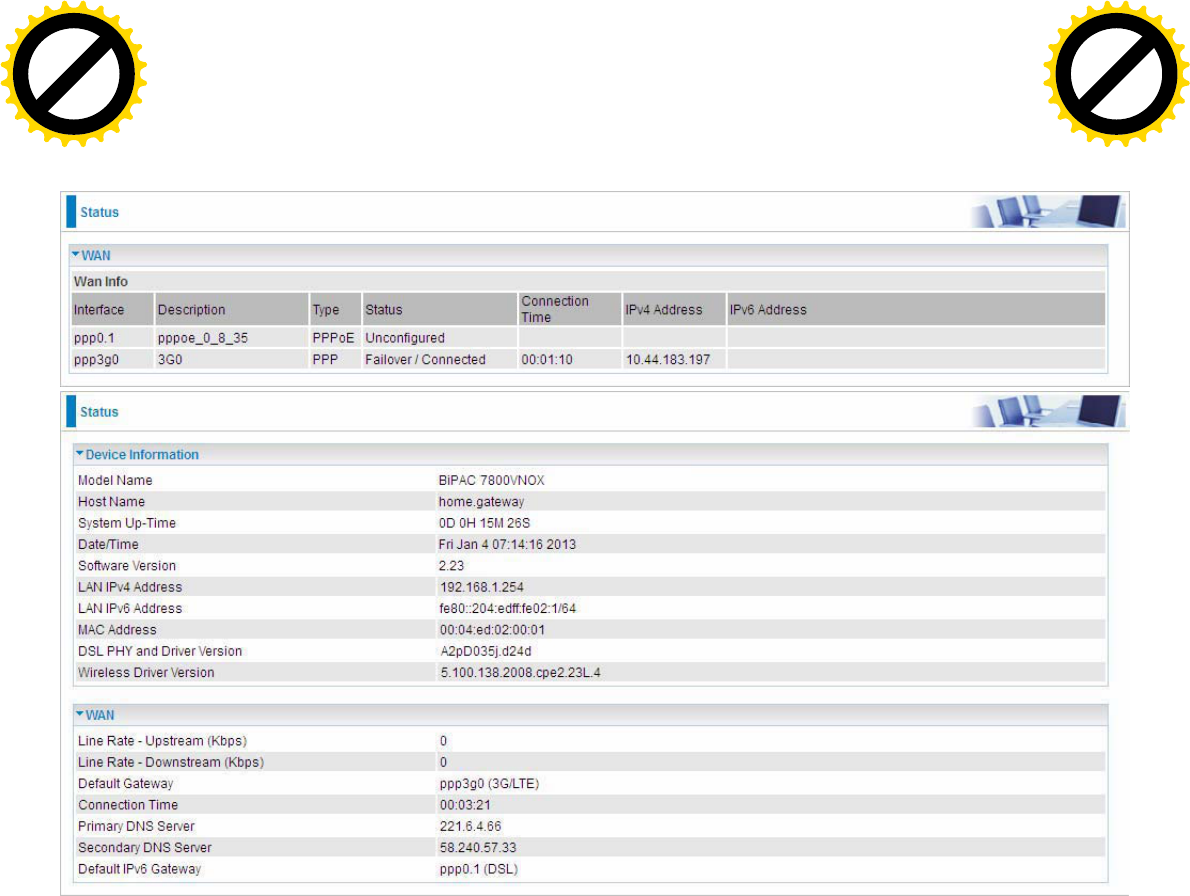
129
Here you can configure WAN Service, if it is OK, you can access the internet. You can go to Status
>WAN or Summary to view the WAN connection information (Here user can see the 3G/LTE
failover).
Click to buy NOW!
P
D
F
-
X
C
h
a
n
g
e
V
i
e
w
e
r
w
w
w
.
d
o
c
u
-
t
r
a
c
k
.
c
o
m
Click to buy NOW!
P
D
F
-
X
C
h
a
n
g
e
V
i
e
w
e
r
w
w
w
.
d
o
c
u
-
t
r
a
c
k
.
c
o
m
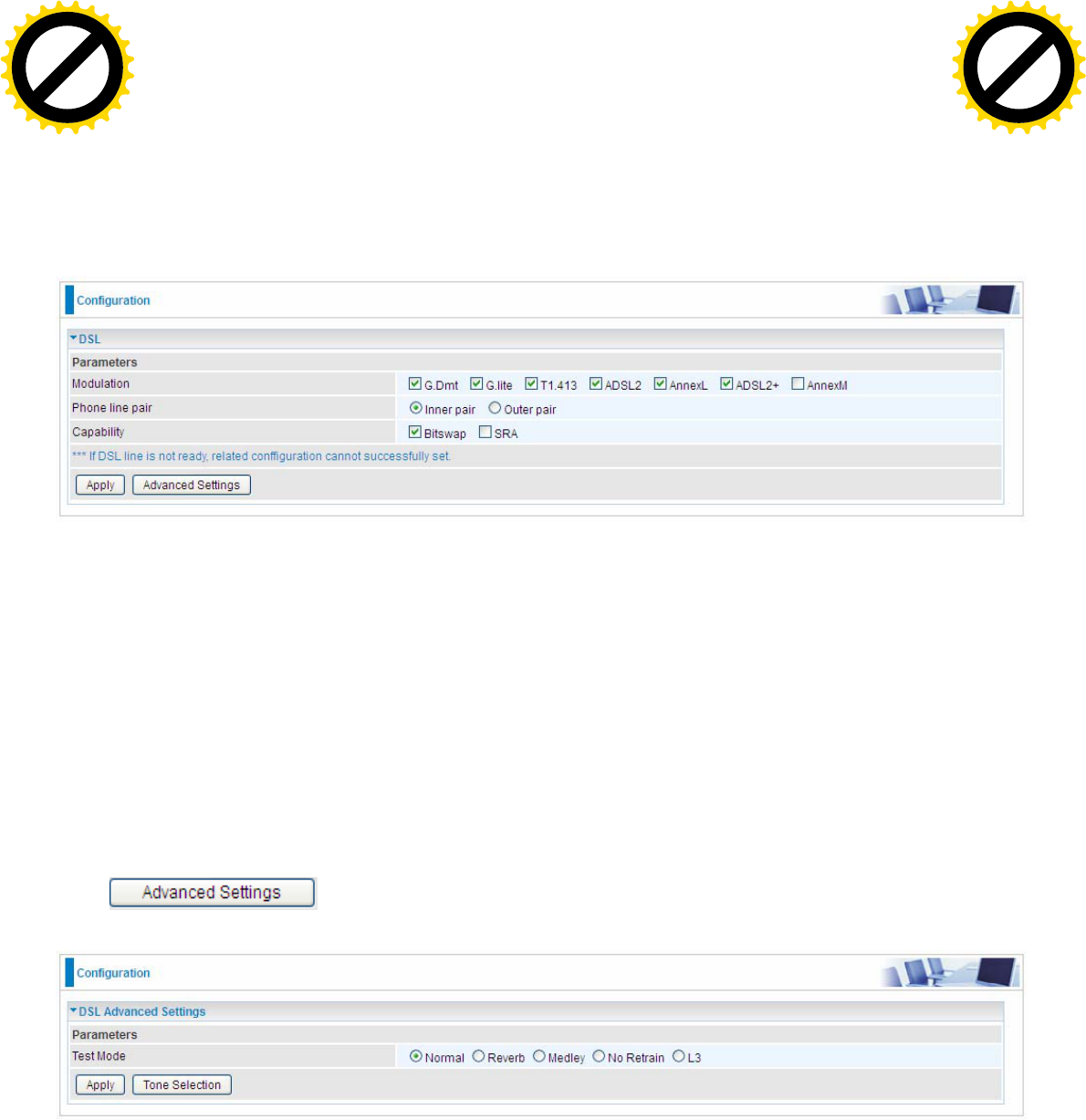
130
DSL
This screen allows you to set DSL parameters. DSL knowledge is required to configure these
settings. Contact your ISP to make sure that these parameters are correct.
Modulation: There are 7 modes “G.Dmt”, “G.lite”, “T1.413”, “ADSL2”, “AnnexL”, ”ADSL2+”,
“AnnexM” that user can select for this connection.
Phone line pair: This is for reserved only. You can choose "Inner Pair" or "Outer Pair".
Capability: There are 2 options “Bitswap Enable” and “SRA Enable” that user can select for this
connection.
Bitswap Enable: Allows bitswaping function.
SRA Enable: Allows seamless rate adaptation.
Click Apply to confirm the settings.
Click to future configure DSL.
Select the Test Mode, or leave it as default.
Tone Selection: This should be left as default or be configured by an advanced user.
The frequency band of ADSL is split up into 256 separate tones, each spaced 4.3125 kHz apart.
With each tone carrying separate data, the technique operates as if 256 separate modems were
running in parallel. The tone range is from 0 to 31 for upstream and from 32 to 255 for
downstream。
Click to buy NOW!
P
D
F
-
X
C
h
a
n
g
e
V
i
e
w
e
r
w
w
w
.
d
o
c
u
-
t
r
a
c
k
.
c
o
m
Click to buy NOW!
P
D
F
-
X
C
h
a
n
g
e
V
i
e
w
e
r
w
w
w
.
d
o
c
u
-
t
r
a
c
k
.
c
o
m
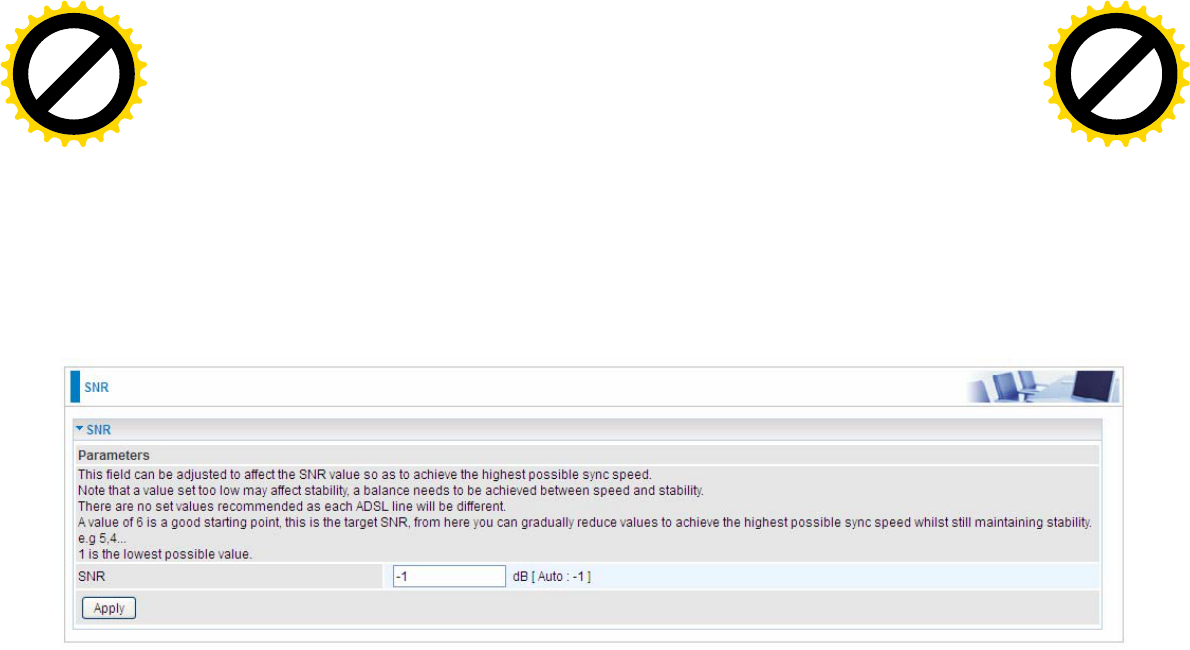
131
SNR
Signal-to-noise ratio (often abbreviated SNR or S/N) is a measure used in science and engineering
that compares the level of a desired signal to the level of background noise. It is defined as the ratio
of signal power to the noise power.
SNR: Change the value to adjust the DSL link rate, more suitable for an advanced user.
Click to buy NOW!
P
D
F
-
X
C
h
a
n
g
e
V
i
e
w
e
r
w
w
w
.
d
o
c
u
-
t
r
a
c
k
.
c
o
m
Click to buy NOW!
P
D
F
-
X
C
h
a
n
g
e
V
i
e
w
e
r
w
w
w
.
d
o
c
u
-
t
r
a
c
k
.
c
o
m
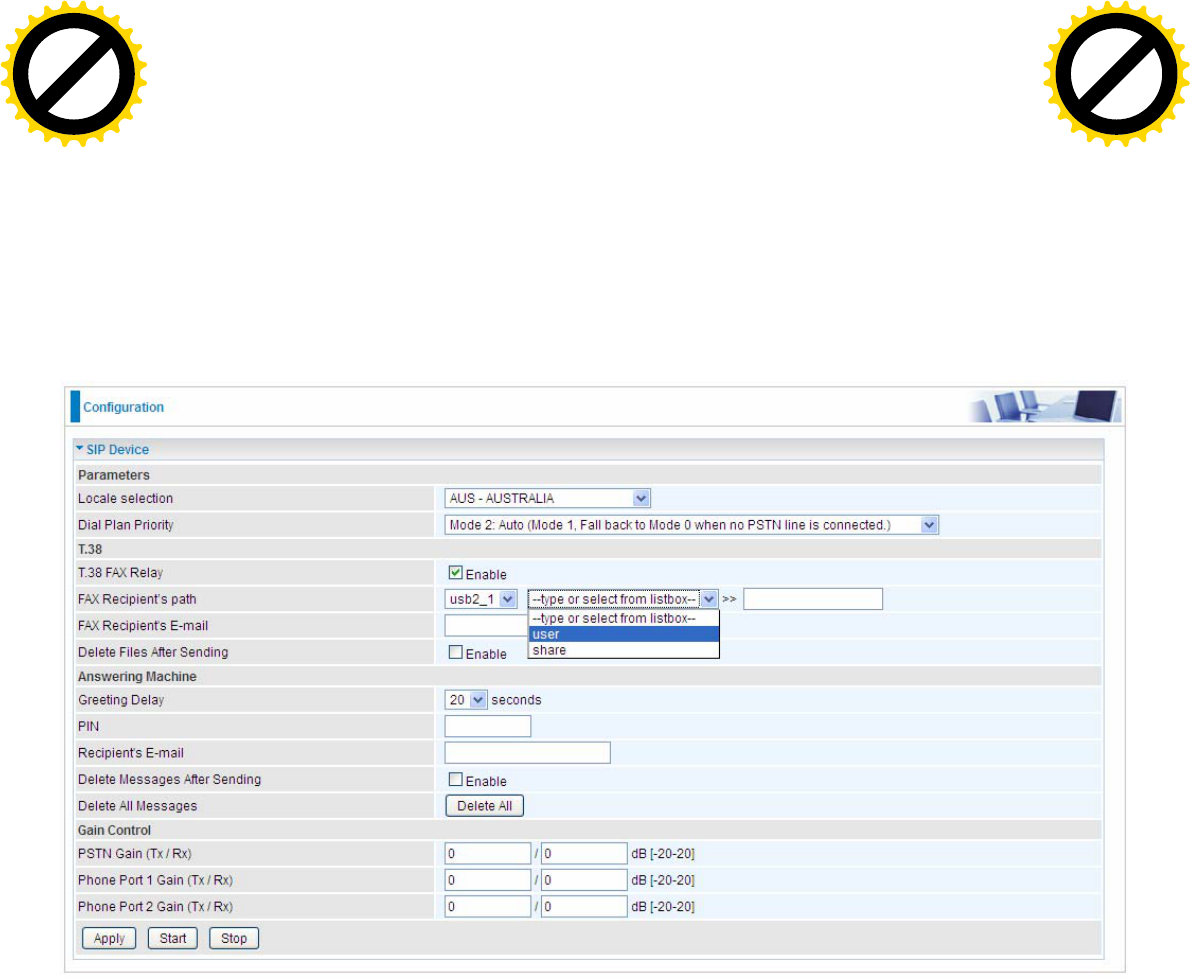
132
VoIP
VoIP, or Voice over Internet Protocol, enables telephone calls through existing internet connections
instead of going through the traditional PSTN (Public Switched Telephone Network). It is not only
cost-effective, especially for a long-distance call, but also top quality voice calls over the internet.
Five sub-items to be covered to configure the VoIP feature, namely SIP Device, Service Provider,
SIP Account, VoIP Dial Plan, PSTN Dial Plan, Phone Book
SIP Device
Locale: This selection is a drop-down box, which allows users to select the country for which the
VoIP device is operating. When a country is selected, the country parameters are automatically
loaded. Different countries can have their special ring mechanism.
Dial Plan Priority: Three modes for users to set the dial mechanism, default is set to Auto, thus
PSTN only with exception.
Mode 0: VoIP only and ignore all PSTN dial plans, send all calls to VoIP, including
Emergency calls.
Mode 1: Default, which means that under this mode, the dial mechanism always match PSTN
plan first, then move to VoIP plan.
Auto: Auto, this means the dial system will fall back to Mode 0 (VoIP) when no PSTN is
connected.
T.38
T.38 relay is a way to permit faxes to be transported across IP networks between existing fax
terminals. The T.38 fax gateway converts and encapsulates the fax sent from the terminal fax
machines into a T.38 date stream. Then the gateway send the converted date packets to a T.38
enabled end point such as a fax or fax server or another T.38 gateway that converts it back to the
analog signal to realize the communication between two fax terminals.
Click to buy NOW!
P
D
F
-
X
C
h
a
n
g
e
V
i
e
w
e
r
w
w
w
.
d
o
c
u
-
t
r
a
c
k
.
c
o
m
Click to buy NOW!
P
D
F
-
X
C
h
a
n
g
e
V
i
e
w
e
r
w
w
w
.
d
o
c
u
-
t
r
a
c
k
.
c
o
m
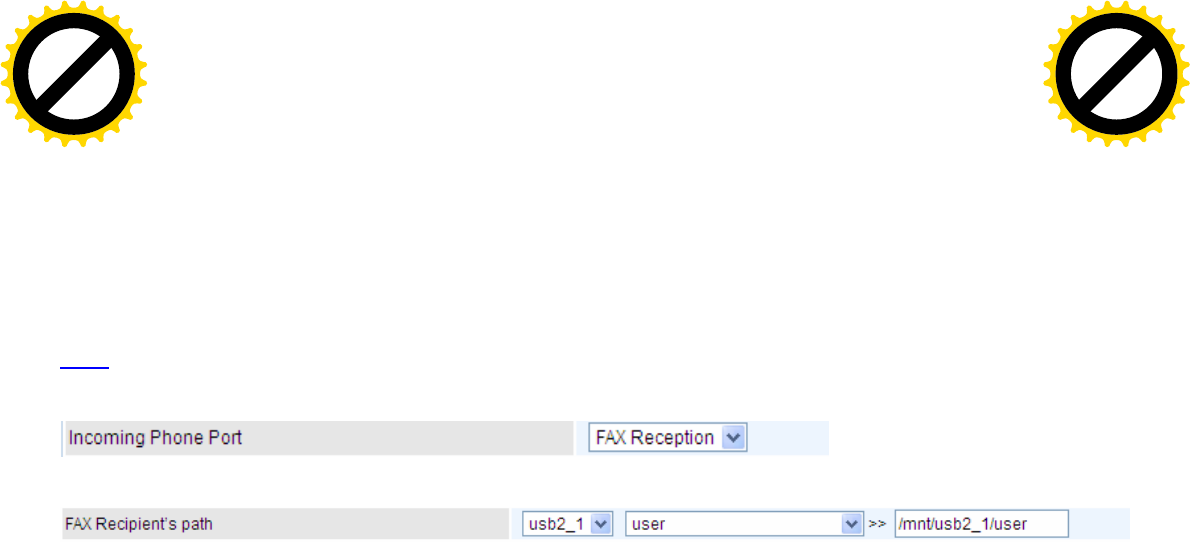
133
T.38 Relay: Click Enable to allow transmission of fax over IP network between two fax machines. If
T.38 relay is disabled, the analog fax signal is transmitted as the normal audio data. If T.38 relay is
enabled, the fax signal is converted to T.38 signal.
FAX Recipient’s path: Set the path directly for storing the fax file to the storage.
Note: For common fax usage, user should have a fax connected to the router, creating a fax
environment between two fax terminals, and the fax file(s) would be received through fax connected
to the router as what we usually perform.
But if user does not get a fax or he wants to store the fax to the file directly, he then can enable Fax
Reception feature. Select or enter manually the reception path for the file. (Here user can turn to
USB for help.)
1) Set the field “Incoming Phone Port” to “FAX Reception” at the “VoIP Account” page.
2) Set the path user wants fax file saved at “FAX Recipient’s path” at the “SIP Device” page.
3) The incoming VoIP call for the specified VoIP account will be treated as Fax and saved to path.
FAX Recipient’s E-mail: Enter the recipient’s email address. Once the fax file is delivered, the fax
file will be mailed to the account specified by the “Recipient’s Email”,
Delete Files After Sending: The files will be deleted from system once the mail is sent out.
Answering Machine
The answering machine is a device for answering telephones and recording callers’ messages and
being enabled for both VoIP and PSTN.
The operation for the answering machine:
*#00: Record user own greeting message;
1) Start the recording after the beep sound
2) Press # while finished.
3) Hang up after the beep is heard. (system needs time on file translation and save to storage).
*#99: Delete the user's greeting message
*#98: Play the greeting message
*#xx: Access the specified answering machine where xx (automatically designated by the system)
can be found at the "SIP Account" page.
*#96: Enable the answering machine
*#97: Disable the answering machine
1) After the beep sound, dial the specified code xx where xx can be found at the "SIP Account"
page.
2) Hang up after the beep is heard. (system needs time on file translation and save to storage).
*#90: Access the PSTN A/M.
Note: 7800VNP(O)X uses the 1st available phone port to record the PSTN message. So, the answer
machine stops recording if user picks up the specified phone.
Greeting Delay: The parameter is used as a threshhold for the answer machine to automatically
answer and record the messgae. There are seven items marking 0, 5, 10, 15, 20, 25, 30 respectively.
For example, if set to 0s, when there is an incoming call, the answering machine will respond
Click to buy NOW!
P
D
F
-
X
C
h
a
n
g
e
V
i
e
w
e
r
w
w
w
.
d
o
c
u
-
t
r
a
c
k
.
c
o
m
Click to buy NOW!
P
D
F
-
X
C
h
a
n
g
e
V
i
e
w
e
r
w
w
w
.
d
o
c
u
-
t
r
a
c
k
.
c
o
m

134
immediately and record the message. And if it is set to 20s, then the call will keep ringing until time
out of 20s (without user picking up the phone) before it can respond and record the meassge.
PIN: The set password (no exceeding 8 digits) for listening to message. The customer should press
the PIN number so as to listen to the message. Leave it empty, and user can listen to the message
without entering password first.
Recipient’s Email: Enter the recipient’s email address. Once the voice message is left (answering
machine operation), the voice message will be mailed to the account specified by the “Recipient’s
Email”,
Deleting Messages After Sending: The message will be deleted from system once the mail is sent
out.
Delete All Messages: Press the “Delete All” button to delete all messages stored in the system all at
once.
Gain Control
Gain control is to reduce the bad performance of quality issue caused by noise or echo, etc. Rx
means the performance of receiving and the Tx implies the performance of transimitting. A plus
quantity is to raise the performance while a negative quantity is to cut the performance (Rx: +1 to
increase the performance of receiving by 1 point and if set -1, the performance will be cut by 1 point,
the range is -20- 20. ).
PSTN Gain: Set the PSTN gain, Tune the gain between -20-20 of the Rx and Tx respectively to
obtain a appropriate PSTN call environment.
Phone Port 1 Gain: Set the gain. Tune the gain between -20-20 of the Rx and Tx respectively to
ensure a clear phone call.
Phone Port 2 Gain: Set the gain. Tune the gain between -20-20 of the Rx and Tx respectively to
ensure a clear phone call.
Click to buy NOW!
P
D
F
-
X
C
h
a
n
g
e
V
i
e
w
e
r
w
w
w
.
d
o
c
u
-
t
r
a
c
k
.
c
o
m
Click to buy NOW!
P
D
F
-
X
C
h
a
n
g
e
V
i
e
w
e
r
w
w
w
.
d
o
c
u
-
t
r
a
c
k
.
c
o
m
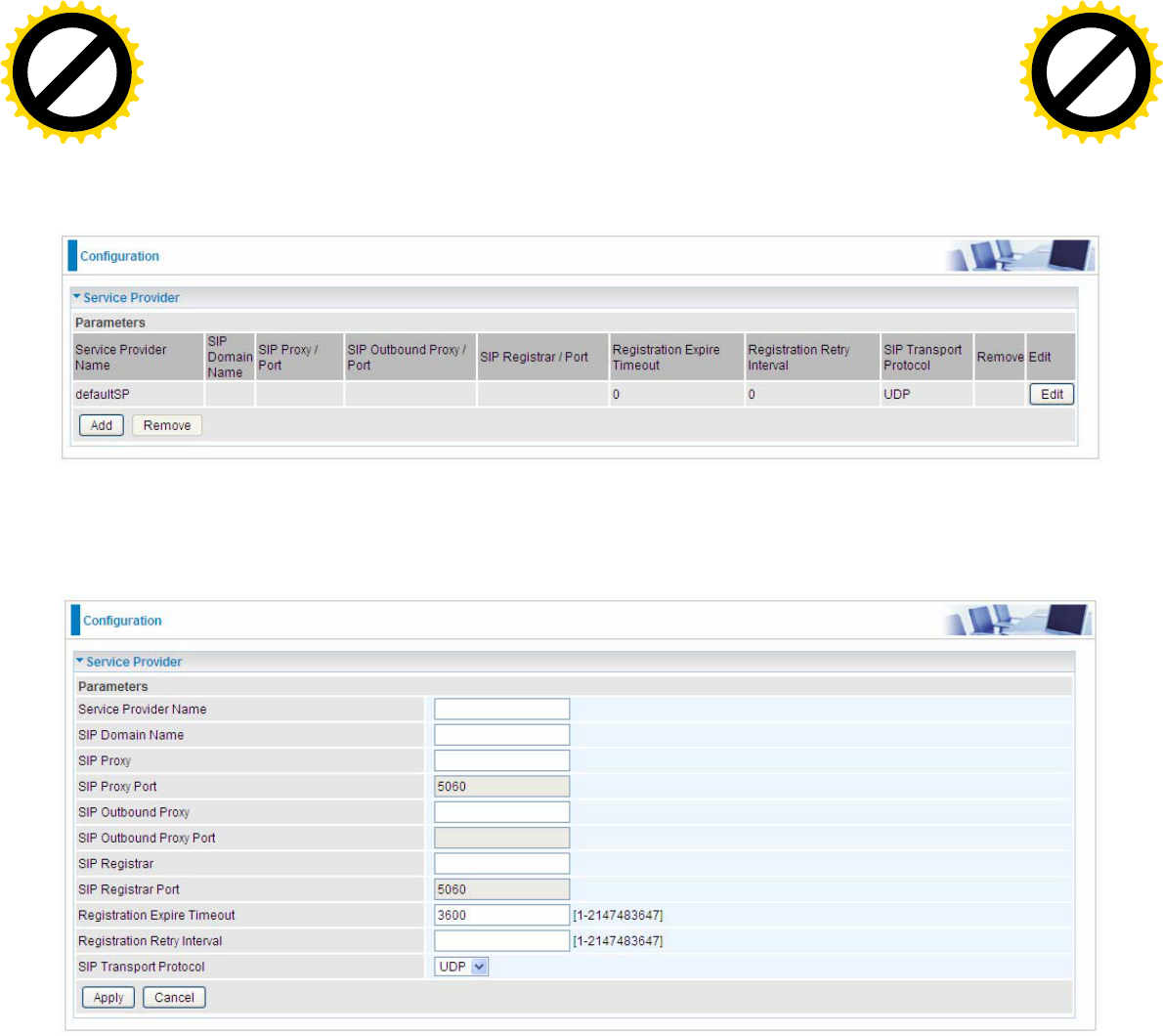
135
Service Provider
Register to a SIP service provider is an essential step before making the VoIP call. Users can find
out SIP service provider, and register a SIP account, jotting down the registration information and
configuring in router.
BiPAC 7800VNP(O)X offers a defaultSP item, you can change the settings or add a new Service
Provider yourself.
Service Provider Name: Name of provider of the VoIP service
SIP Domain Name: Enter the SIP registrar domain name.
SIP Proxy: Also seen as SIP server, it manages the setup of calls between SIP devices including
the controlling of call routing and some necessary functions such as registration, authentication, and
network access control. Type the SIP Proxy address you obtain after you register from the service
provider.
SIP Proxy Port: The port number set on your SIP proxy serve that the SIP proxy server uses to
make network connections, default is 5060.
SIP Outbound Proxy: SIP outbound proxy is in similar use as SIP proxy, but when the SIP devices
are behind a firewall or a router or NAT, the SIP outbound proxy is the useful way to let SIP traffic to
pass from the internal network to the internet. Enter the SIP outbound proxy server address here.
SIP Outbound Proxy port: Enter the port, normally 5060.
SIP Registrar: Type the VoIP SIP registrar IP address.
SIP Registrar Port: Type the port; it will listen to register requests from VoIP devices.
Click to buy NOW!
P
D
F
-
X
C
h
a
n
g
e
V
i
e
w
e
r
w
w
w
.
d
o
c
u
-
t
r
a
c
k
.
c
o
m
Click to buy NOW!
P
D
F
-
X
C
h
a
n
g
e
V
i
e
w
e
r
w
w
w
.
d
o
c
u
-
t
r
a
c
k
.
c
o
m

136
Registration Expire Timeout: This sets time interval before timeout.
Registration Retry Interval: The interval set to retry sending registration message.
SIP Transport Protocol: The protocol adopted to transport SIP, UDP commonly used.
Click to buy NOW!
P
D
F
-
X
C
h
a
n
g
e
V
i
e
w
e
r
w
w
w
.
d
o
c
u
-
t
r
a
c
k
.
c
o
m
Click to buy NOW!
P
D
F
-
X
C
h
a
n
g
e
V
i
e
w
e
r
w
w
w
.
d
o
c
u
-
t
r
a
c
k
.
c
o
m
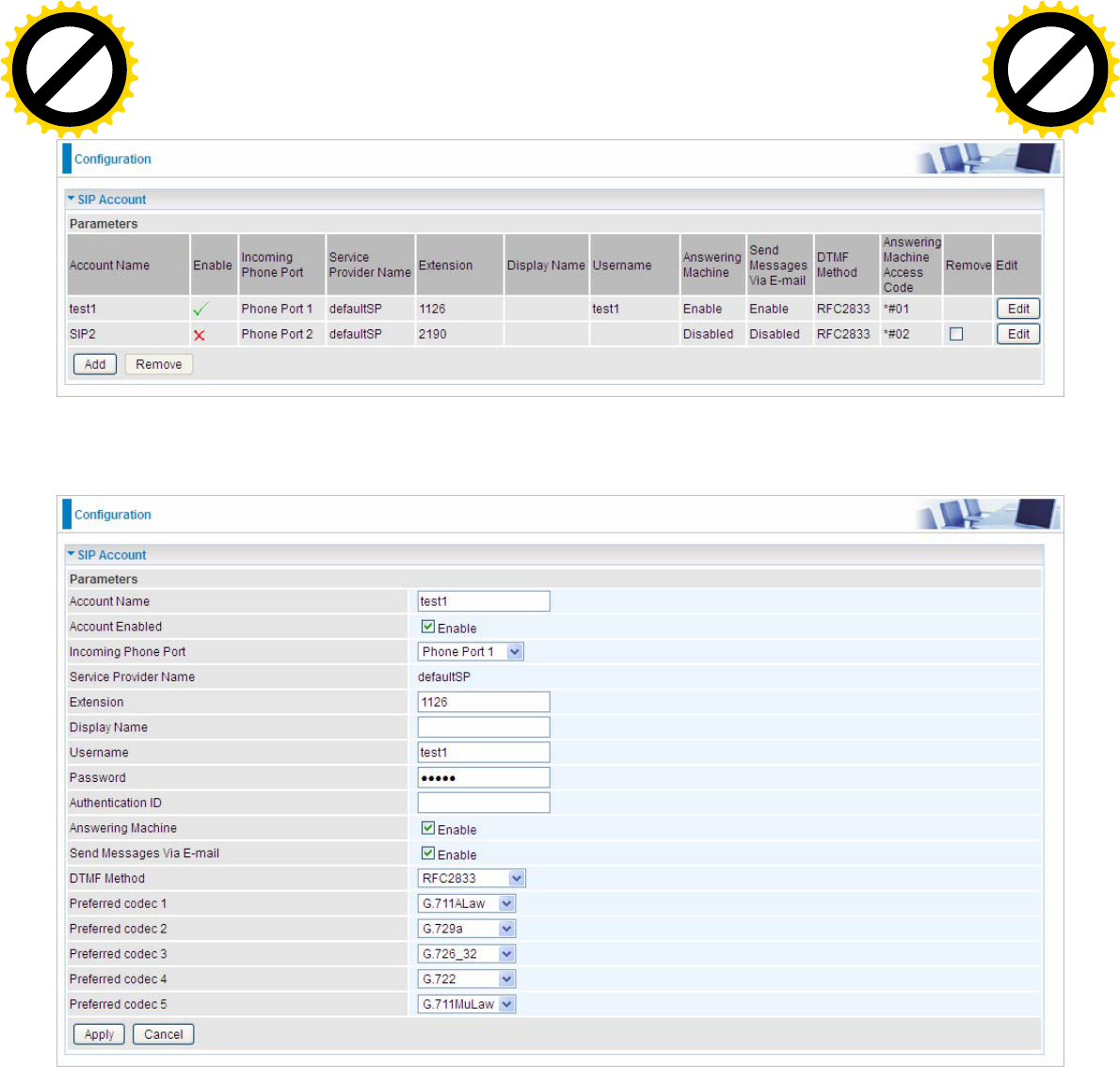
137
SIP Account
SIP account is an independent section for SIP account settings, including Extension number, etc.
Click Add or Edit to add new account or modify the existing sip account.
Account Name: User-defined account name.
Account Enabled: Enable to activate the sip account.
Incoming Phone Port: Select which phone port you are setting.
Extension: The Phone number.
Display Name: Enter a display name to identify the phone, like indicating the phone usage.
User Name: The user name user registers in the sip server.
Password: The password user registers in the sip server.
Authentication ID: It is an authentication code required for some ISP, and can be left empty if not
required.
Answering Machine: Enable to activate the answering machine feature so that user can record and
listen to the messages of this phone.
Click to buy NOW!
P
D
F
-
X
C
h
a
n
g
e
V
i
e
w
e
r
w
w
w
.
d
o
c
u
-
t
r
a
c
k
.
c
o
m
Click to buy NOW!
P
D
F
-
X
C
h
a
n
g
e
V
i
e
w
e
r
w
w
w
.
d
o
c
u
-
t
r
a
c
k
.
c
o
m

138
Send Message Via E-mail: Enable to send message left by callers via e-mail to the user.
DTMF Method: DTMF stands for "Dual-Tone Multi-Frequency", and is a telecommunication signaling
over analog telephone lines widely used between telephone handsets and other communication
devices and the switching center. “DTMG method” provides ways to transmit DTMF for VoIP, such as
RFC 2833, SIP Info, SIP Info (short), Inband and Auto, and RFC2833 is the widely used one.
Preferred codec#1,2,3,4,5: Codec is known as Coder-Decoder used for data signal conversion. Set
the priority of voice compression; Priority 1 owns the top priority.
G.711A-LAW: It is a basic non-compressed encoder and decoder technique. A-LAW uses
pulse code modulation (PCM) encoder and decoder to convert 13-bit linear sample into 8-bit
value.
G.729a: It is used to encoder and decoder voice information into a single packet which
reduces the bandwidth consumption.
G.726_32: It is an ITU-T ADPCM speech codec standard covering the transmission of voice
at rates of 32kbit/s.
G.722: G.722 is an ITU standard codec that provides 7 kHz wideband audio at data rates from
48, 56 and 64 kbit/s. G.722 sample audio data at a rate of 16 kHz (using 14 bits), double that
of traditional telephony interfaces, which results in superior audio quality and clarity.
G.711Mu-Law: It is a basic non-compressed encoder and decoder technique. μ-LAW uses
pulse code modulation (PCM) encoder and decoder to convert 14-bit linear sample.
Click to buy NOW!
P
D
F
-
X
C
h
a
n
g
e
V
i
e
w
e
r
w
w
w
.
d
o
c
u
-
t
r
a
c
k
.
c
o
m
Click to buy NOW!
P
D
F
-
X
C
h
a
n
g
e
V
i
e
w
e
r
w
w
w
.
d
o
c
u
-
t
r
a
c
k
.
c
o
m
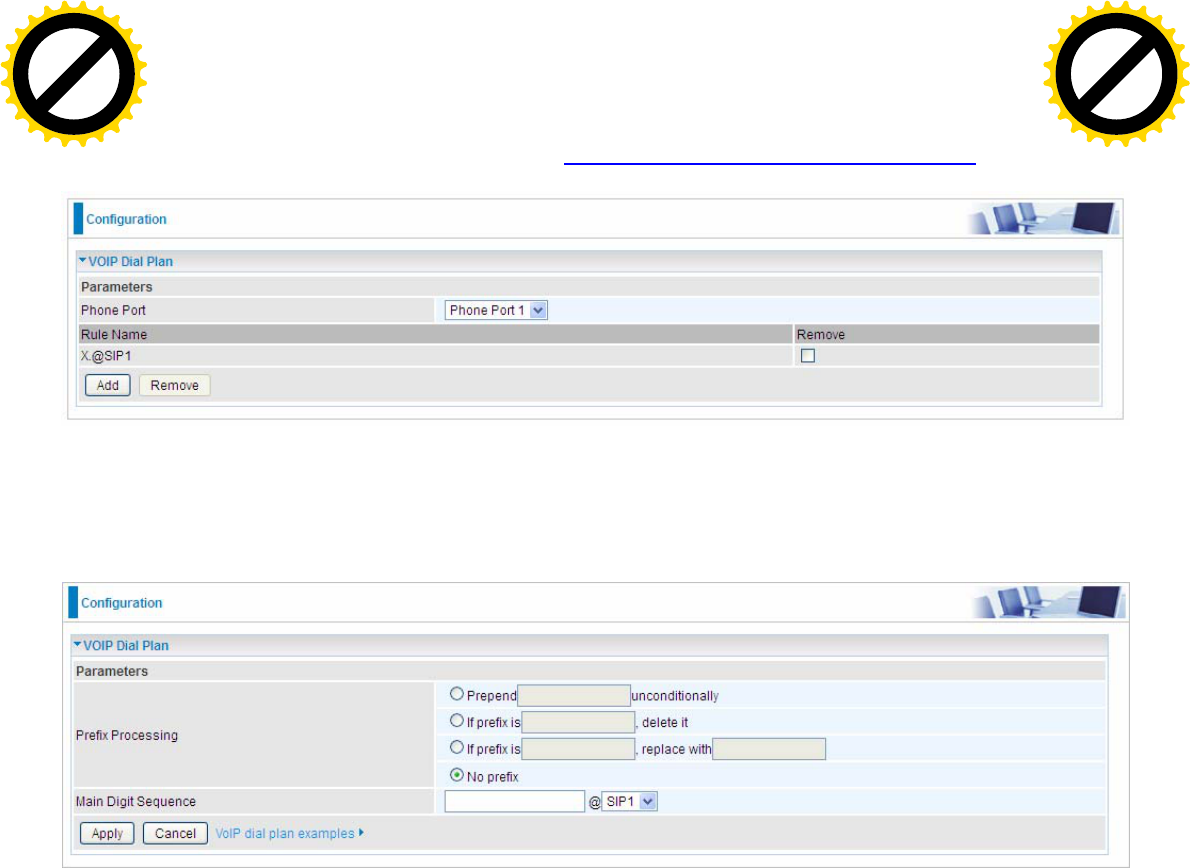
139
VOIP Plan
This section helps you to make a number dial via VoIP. You no longer need to memorize a long dial
string or number for making a VoIP call. Go to Configuration > VOIP > VOIP Dial Plan.
Phone Port: Set the phone the VoIP dial rule relates to. When phone port is set to Phone Port 1, the
rules will apply to phone1.
Click Add to create new rules.
Prefix Processing:
Prepend xxx unconditionally: xxx number is appended unconditionally to the front of the
dialing number when making a call. Prefix can also be included with any number and/or
character such as *, #.
Note: For special service with *, #, you may need to check with your VoIP or Local Telephone Service
Provider for information.
If Prefix is xxx, delete it: Prefix xxx is removed from the dialed numbers before making a call.
If Prefix is xxx, replace with yyy: Prefix xxx is replaced with yyy when making a call.
No prefix: No prefix is appended to the front of the dialed numbers. It is set as in default
settings.
Click to buy NOW!
P
D
F
-
X
C
h
a
n
g
e
V
i
e
w
e
r
w
w
w
.
d
o
c
u
-
t
r
a
c
k
.
c
o
m
Click to buy NOW!
P
D
F
-
X
C
h
a
n
g
e
V
i
e
w
e
r
w
w
w
.
d
o
c
u
-
t
r
a
c
k
.
c
o
m
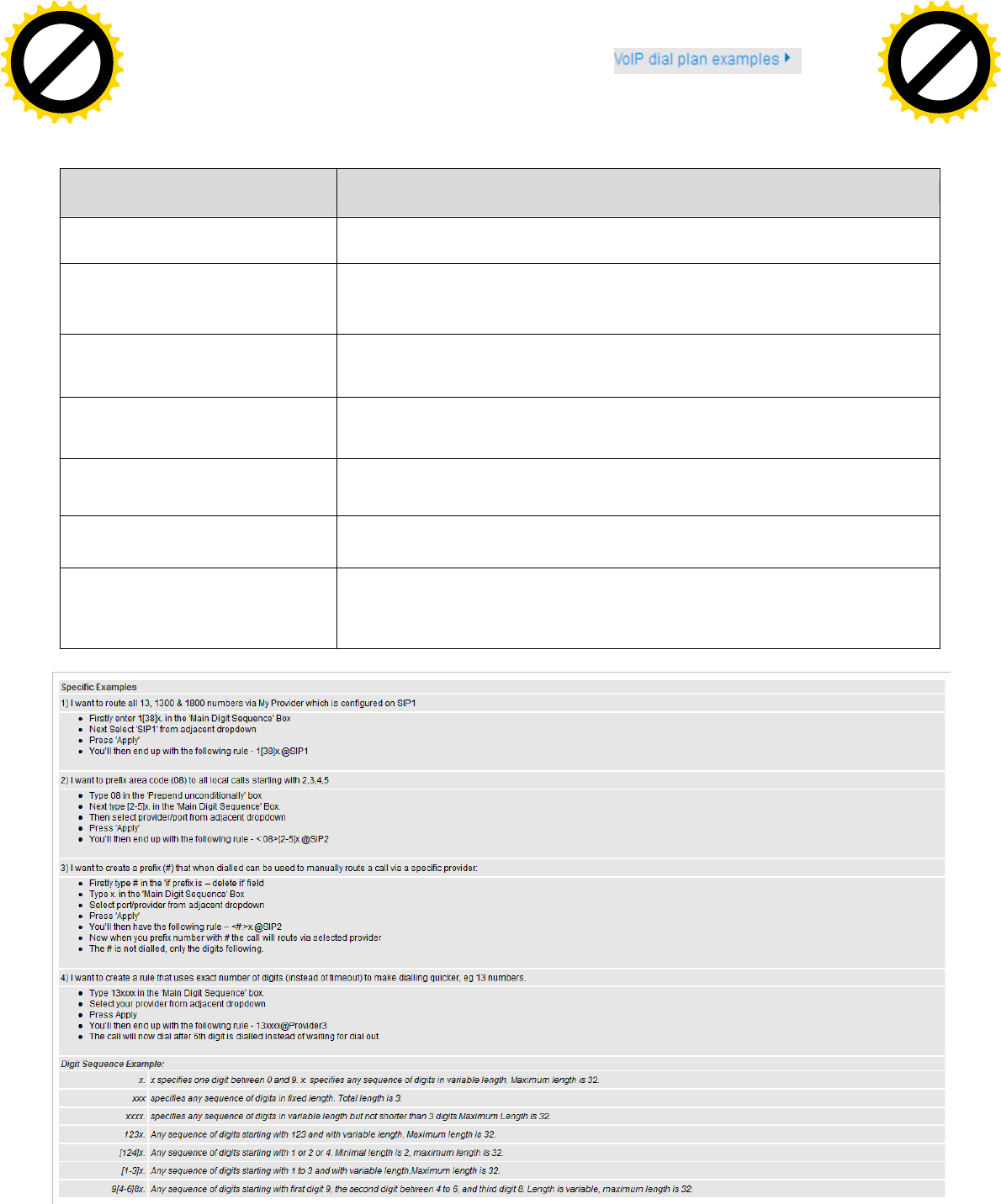
140
Main Digit Sequence: The call(s) can be called out via SIP. leads users to
regular usage for this parameter.
<@ SIPgateway>: This is used for the Intelligent Call Routing feature where you need to set up your
SIP account on the VoIP User-defined Profiles link on the VoIP Wizard page.
Digit sequence Example Description
x. x specifies one digit between 0 and 9. x. specifies any sequence
of di
g
its in variable len
g
th. Maximum len
g
th is 32.
xxx Specifies any sequence of digits in fixed length. Total length is 3.
xxxx. Specifies any sequence of digits in variable length but not shorte
r
than 4 digits. Maximum Length is 32.
123x.
A
ny sequence of digits starting with 123 and with variable length.
Maximum length is 32.
[124]x. Any sequence of digits starting with 1 or 2 or 4. Minimal length is
2, maximum length is 32.
[1-3]x.
A
ny sequence of digits starting with 1 to 3 and with variable
length. Maximum length is 32.
9[4-6]8x.
A
ny sequence of digits starting with first digit 9, the second digit
between 4 to 6, and third digit 8. Length is variable, maximum
length is 32.
Click to buy NOW!
P
D
F
-
X
C
h
a
n
g
e
V
i
e
w
e
r
w
w
w
.
d
o
c
u
-
t
r
a
c
k
.
c
o
m
Click to buy NOW!
P
D
F
-
X
C
h
a
n
g
e
V
i
e
w
e
r
w
w
w
.
d
o
c
u
-
t
r
a
c
k
.
c
o
m
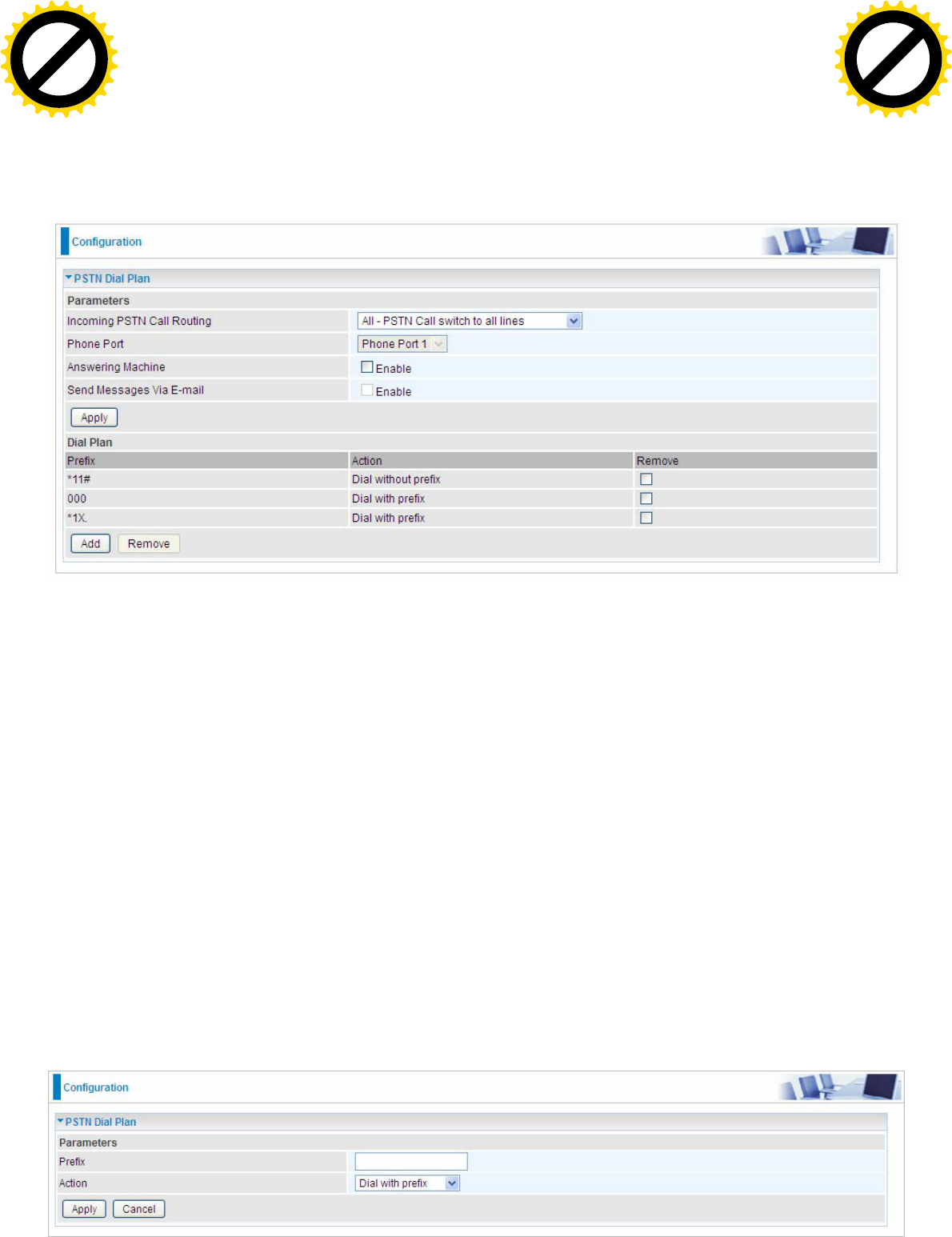
141
PSTN Dial Plan
PSTN Dial Plan assists in routing calls via PSTN. You can define a range of dial plans to make
regular calls from VoIP switching to PSTN line. Prefix numbers are essential in distinguishing
between VoIP and Regular phone calls. If actual numbers dialed matches with prefix number defined
in this dial plan, the dialed number will be routed via PSTN. Otherwise, the number will be routed via
VoIP network.
Parameters
Incoming PSTN Call Routing: Measures to deal with incoming PSTN calls.
Auto: Change the incoming call to another idle line, for example, if Phone 1 is busy, then the
incoming call would be switched to Phone port 2.
Line: If a PSTN call rings on phone 1, and when Phone 1 is busy, there will be a warning of
the incoming call.
All: Both Phone1 and Phone2 ring when a PSTN call is received.
Phone Port: Decide which phone the incoming PSTN call routing applies to.
Answering Machine: Enable to activate the answering machine feature for PSTN so that user can
record and listen to the messages of this phone.
Send Message Via E-mail: Enable to send message left by callers via e-mail to the user.
Dial Plan
Click Add to add new rules.
Click to buy NOW!
P
D
F
-
X
C
h
a
n
g
e
V
i
e
w
e
r
w
w
w
.
d
o
c
u
-
t
r
a
c
k
.
c
o
m
Click to buy NOW!
P
D
F
-
X
C
h
a
n
g
e
V
i
e
w
e
r
w
w
w
.
d
o
c
u
-
t
r
a
c
k
.
c
o
m
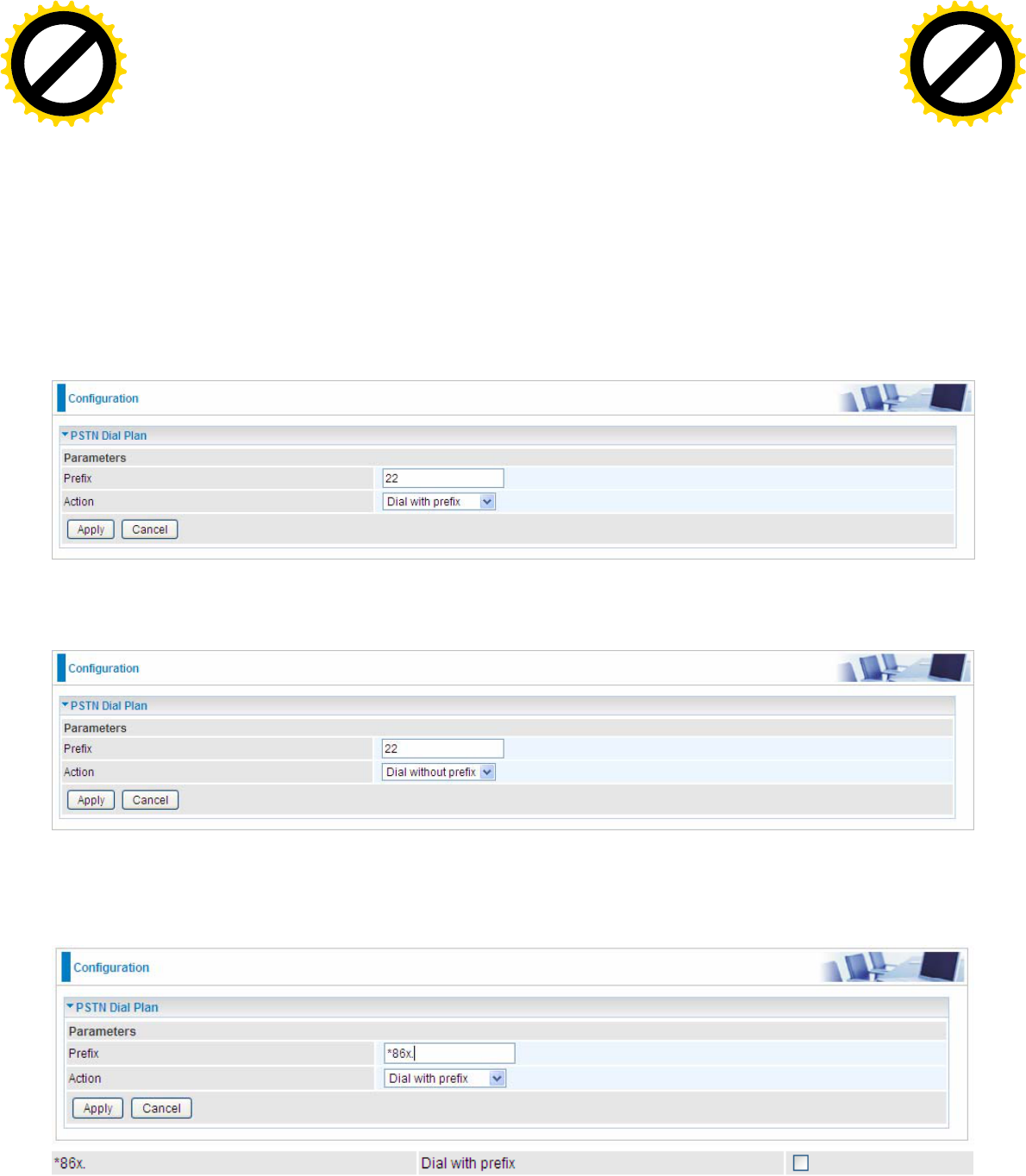
142
Prefix: Specify number(S) marking as the tag for switching to a PSTN call.
Action: The dialing mechanism.
Dial with Prefix: The dialed number together with the prefix will be sent to call through PSTN.
Dial without Prefix: The dialed number will be sent to call through PSTN without prefix.
Note: The x. wildcard character is supported here by PSTN dial plan. x specifies one digit between 0
and 9. x. specifies any sequence of variable length, the maximum length is 32.
Examples of PSTN dial plan:
1. Dial with Prefix
If you dial 2250505, number 2250505 will be dialed out via FXO to make a regular phone call.
2. Dial without Prefix
In this example, if user wants to dial out 50505(the destination extension number), please first dial 22
and it will get the PSTN dial tone from CO site and then dial 50505 to make a regular phone call.
3. With x wildcard character.
If User wants numbers with prefix *860, *8601, *862, etc all to be dialed out via FXO together with
these prefix, and then he could turn to the reference above..
Click to buy NOW!
P
D
F
-
X
C
h
a
n
g
e
V
i
e
w
e
r
w
w
w
.
d
o
c
u
-
t
r
a
c
k
.
c
o
m
Click to buy NOW!
P
D
F
-
X
C
h
a
n
g
e
V
i
e
w
e
r
w
w
w
.
d
o
c
u
-
t
r
a
c
k
.
c
o
m
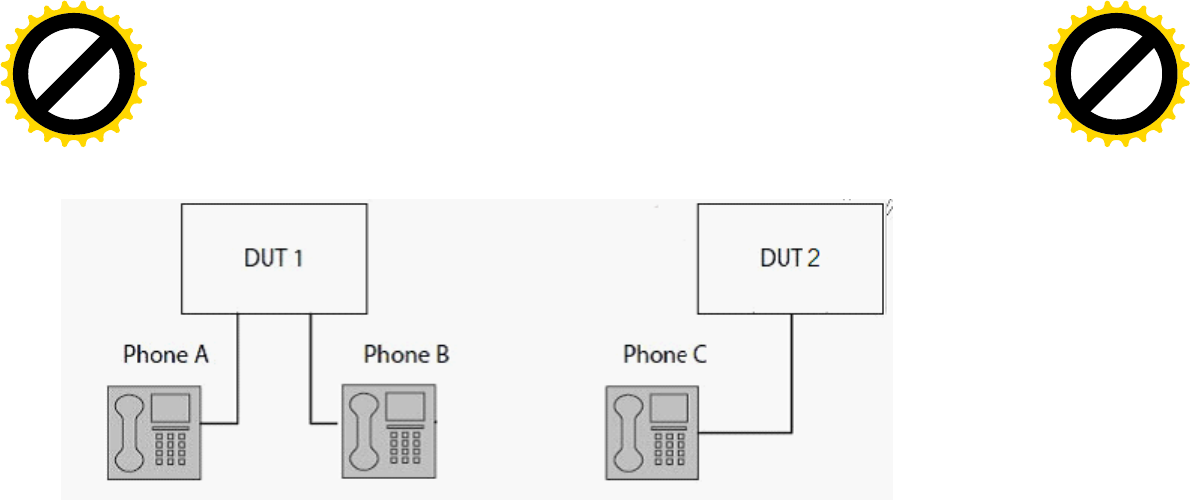
143
How to establish conference call: 3 –way call scenario
Case 1: Phone A invites Phone C to join a conference call
Step – 1: Phone A presses flash (hold original call), and A hears the dial tone
Step – 2: Phone A calls Phone C. C and A are on a new call.
Step – 3: Phone A presses flash (hold new call) and return to original call
Step – 4: Phone A tells Phone B that he wants to set up a conference with Phone C.
Step – 5: Phone A presses flash again to merge all 3 calls
Case 2: Phone C dials in and wants to join Phone A and Phone B’s conference
Step – 1: Phone A and Phone B on a call, then Phone C dials Phone A and A hears a waiting tone
Step – 2: Phone A presses flash and picks up the call waiting call
Step – 3: Phone A presses flash to hold the call with Phone C and return to original call with Phone
B
Step – 4: Phone A tells Phone B that he wants to set up a conference with Phone C.
Step – 5: Phone A presses flash again to merge all 3 calls.
Click to buy NOW!
P
D
F
-
X
C
h
a
n
g
e
V
i
e
w
e
r
w
w
w
.
d
o
c
u
-
t
r
a
c
k
.
c
o
m
Click to buy NOW!
P
D
F
-
X
C
h
a
n
g
e
V
i
e
w
e
r
w
w
w
.
d
o
c
u
-
t
r
a
c
k
.
c
o
m
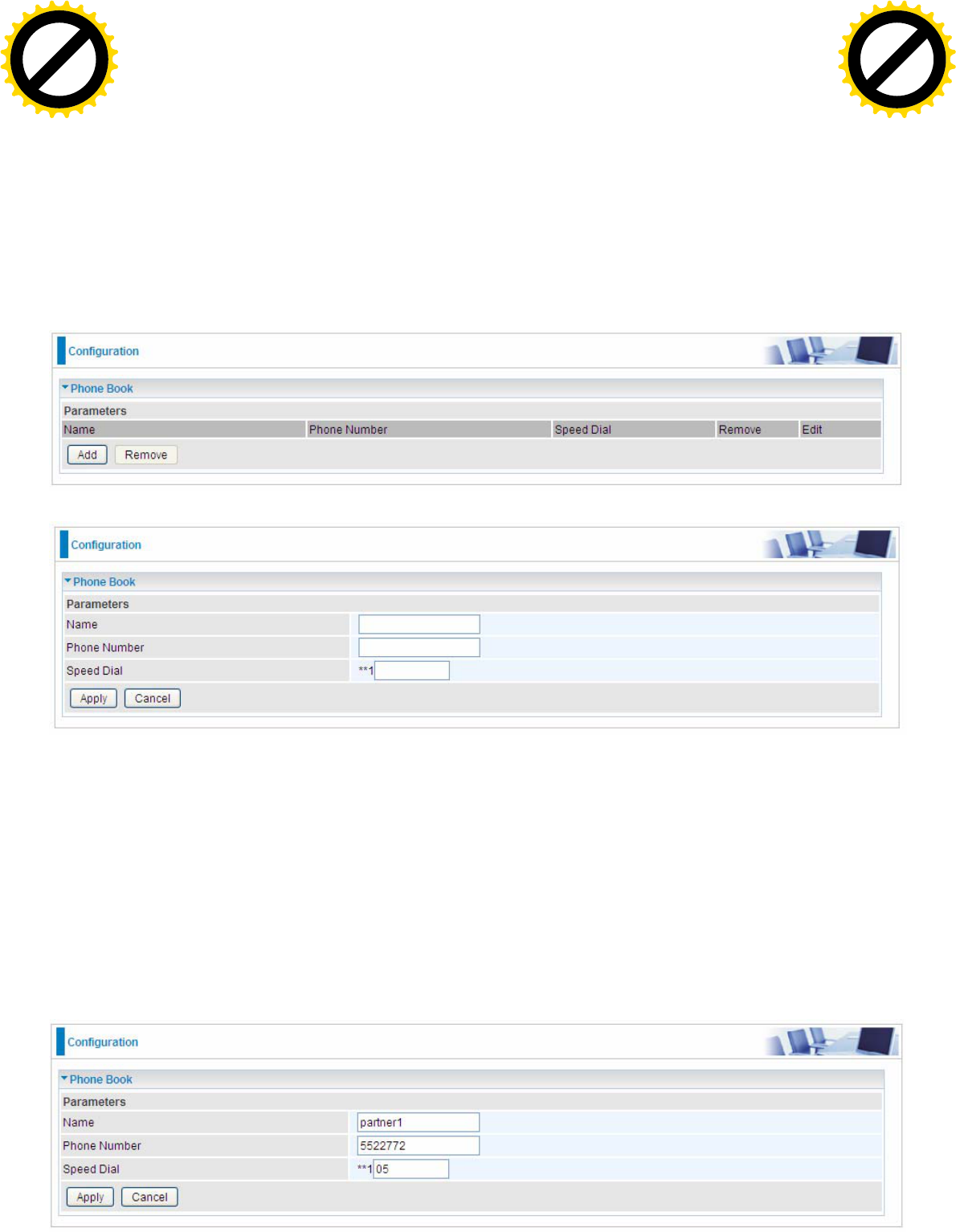
144
Phone Book
Phone Book / Speed Dial comes at hand to store frequently used telephone number(s) that you can
press **1xx instead of the exact dialing-out number on the phone keyboard to make a quick dialing.
For example, if the destination number 5522772 was mapped to a speed-dial number of **105, and
then user can easily press **105 on the phone keyboard, you will be linked to the destination of
5532772, call established..
Note: xx, please remember only two digits (0-9) allowed to identify the phone number.
Name: User-defined identification.
Phone Number: The full destination phone number user wants to be simplified to a speed-dial
number.
Speed Dial: Set the speed-dial number for the destination number.
Simple example:
A user wants to simplify a frequently used phone number to an easy and friendly number for a quick
dialing, and then speed dial is a good choice for him.
For example, the frequently used phone number is 5522772, and mapped to **105, then he can only
dial out **105 to make the call.
Click to buy NOW!
P
D
F
-
X
C
h
a
n
g
e
V
i
e
w
e
r
w
w
w
.
d
o
c
u
-
t
r
a
c
k
.
c
o
m
Click to buy NOW!
P
D
F
-
X
C
h
a
n
g
e
V
i
e
w
e
r
w
w
w
.
d
o
c
u
-
t
r
a
c
k
.
c
o
m
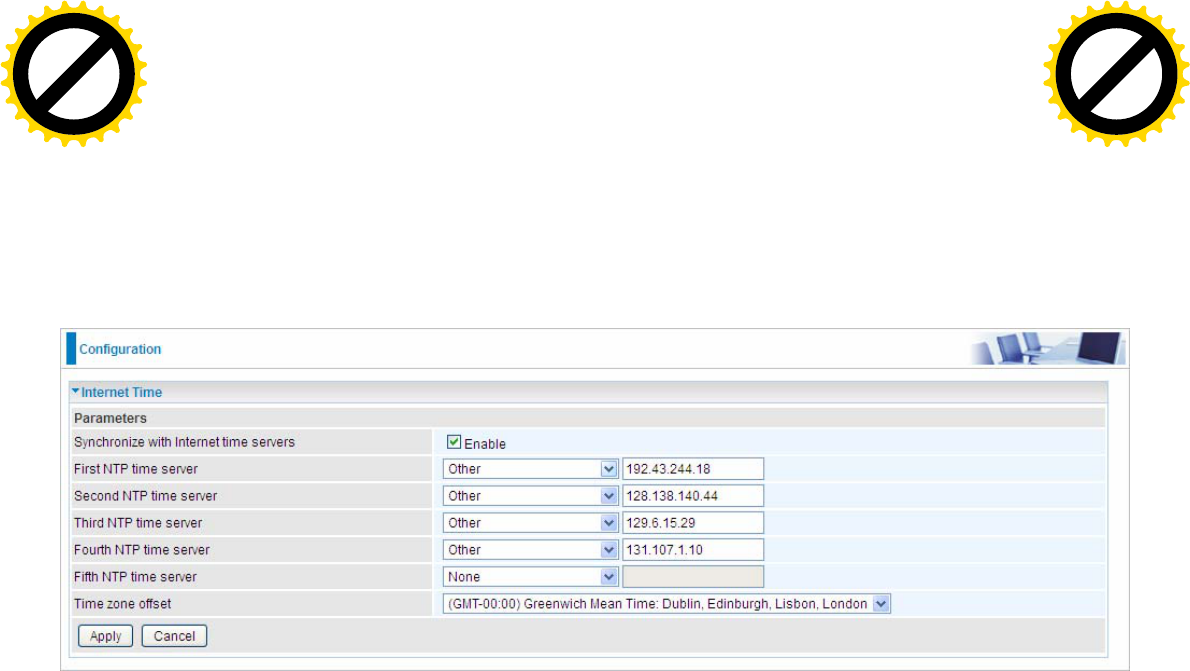
146
System
Internet Time
The router does not have a real time clock on board; instead, it uses the Network Time Protocol
(NTP) to get the most current time from an NTP server.
NTP is a protocol for synchronization of computers. It can enable computers synchronize to the NTP
server or clock source with a high accuracy.
Choose the NTP time server from the drop-down menu, if you prefer to specify an NTP server other
than those in the drop-down list, simply enter its IP address in their appropriate blanks provided as
shown above. Your ISP may also provide an SNTP server for you to use.
Choose your local time zone from the drop-down menu. After a successful connection to the Internet,
the router will retrieve the correct local time from the NTP server you have specified. If you prefer to
specify an NTP server other than those in the drop-down list, simply enter its IP address in their
appropriate blanks provided as shown above. Your ISP may also provide an NTP server for you to
use.
Click Apply to apply your settings.
Click to buy NOW!
P
D
F
-
X
C
h
a
n
g
e
V
i
e
w
e
r
w
w
w
.
d
o
c
u
-
t
r
a
c
k
.
c
o
m
Click to buy NOW!
P
D
F
-
X
C
h
a
n
g
e
V
i
e
w
e
r
w
w
w
.
d
o
c
u
-
t
r
a
c
k
.
c
o
m
